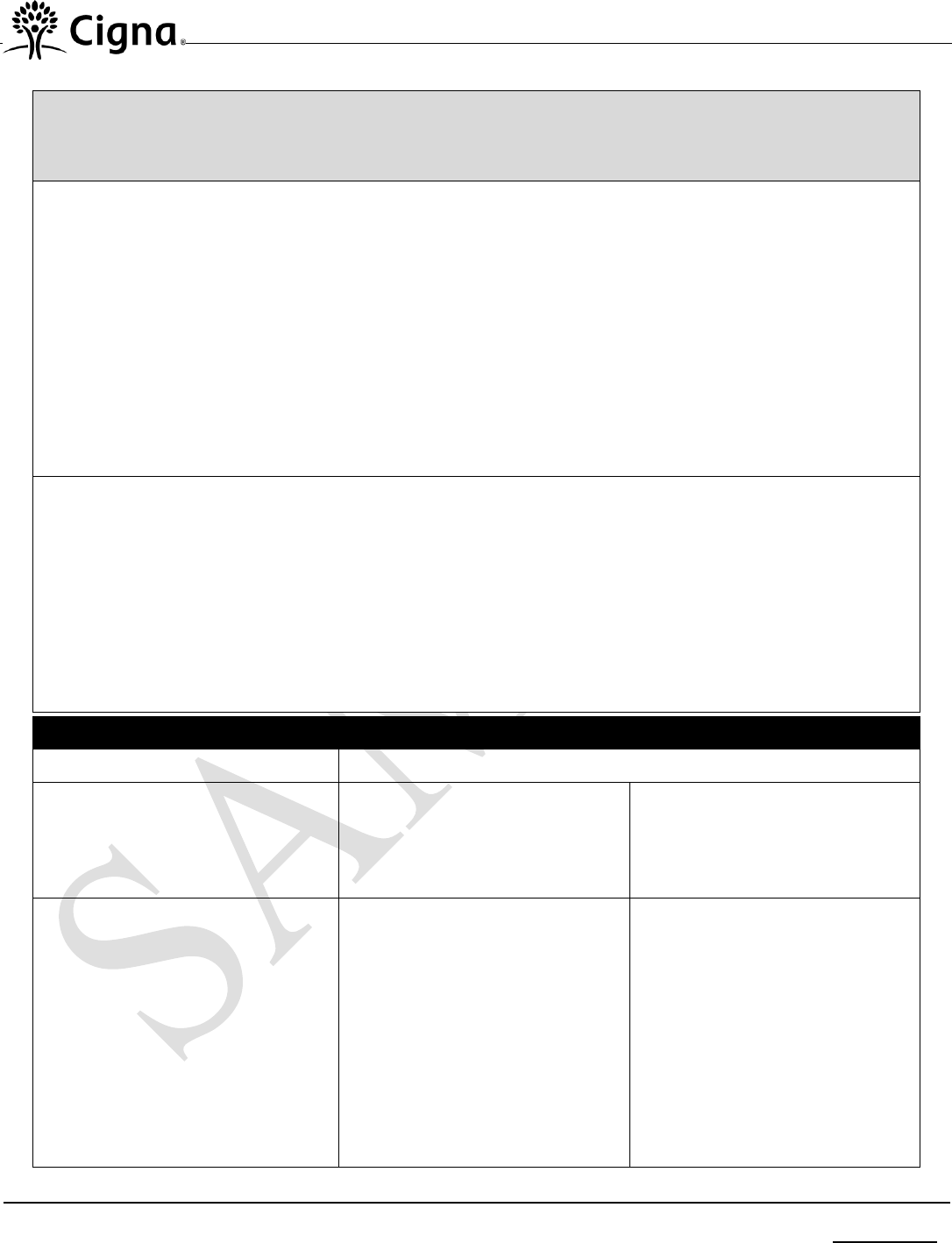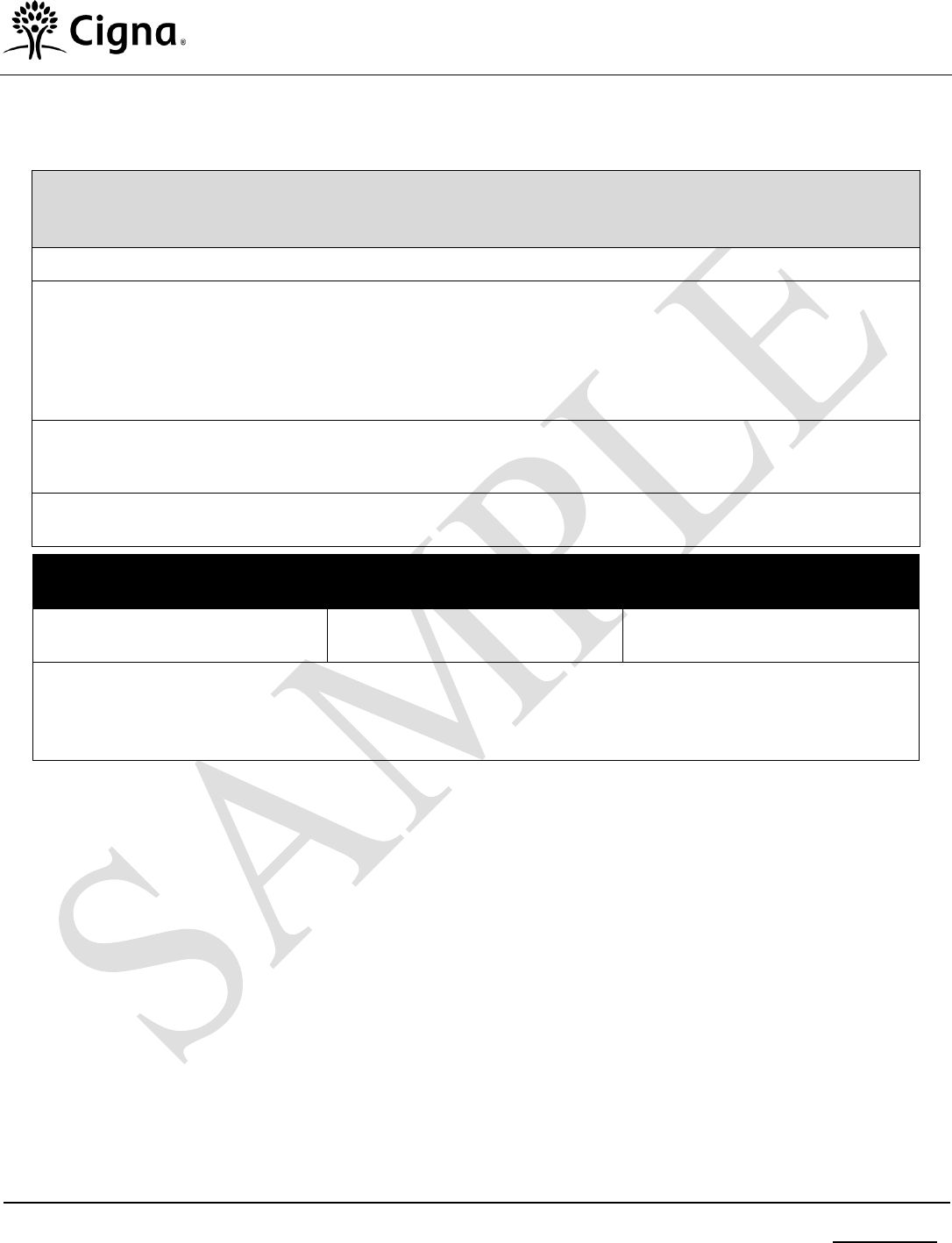
Sample
Cigna LocalPlus Plan
Important Information
THIS IS A SAMPLE DOCUMENT.
NO BENEFITS ARE GUARANTEED. NO COVERAGE REPRESENTATION IS
CONSIDERED TO BE ACTUAL MEDICAL BENEFITS PROVIDED TO YOU BY
CIGNA.


Table of Contents
Important Information ..................................................................................................................5
Special Plan Provisions ..................................................................................................................7
Important Notices ..........................................................................................................................8
How To File Your Claim .............................................................................................................12
Eligibility - Effective Date ...........................................................................................................13
Employee Insurance ............................................................................................................................................. 13
Waiting Period ...................................................................................................................................................... 13
Dependent Insurance ............................................................................................................................................ 14
Important Information About Your Medical Plan ...................................................................14
LocalPlus Medical Benefits .........................................................................................................15
The Schedule ........................................................................................................................................................ 15
Certification Requirements - Out-of-Network ...................................................................................................... 37
Prior Authorization/Pre-Authorized ..................................................................................................................... 37
Covered Expenses ................................................................................................................................................ 38
Prescription Drug Benefits ..........................................................................................................49
The Schedule ........................................................................................................................................................ 49
Covered Expenses ................................................................................................................................................ 53
Limitations............................................................................................................................................................ 53
Your Payments ..................................................................................................................................................... 55
Exclusions ............................................................................................................................................................ 55
Reimbursement/Filing a Claim ............................................................................................................................. 56
Exclusions, Expenses Not Covered and General Limitations ..................................................57
Coordination of Benefits..............................................................................................................59
Expenses For Which A Third Party May Be Responsible .......................................................62
Payment of Benefits .....................................................................................................................63
Termination of Insurance............................................................................................................64
Employees ............................................................................................................................................................ 64
Dependents ........................................................................................................................................................... 64
Rescissions ........................................................................................................................................................... 65
Federal Requirements .................................................................................................................65
Notice of Provider Directory/Networks................................................................................................................ 65
Qualified Medical Child Support Order (QMCSO) ............................................................................................. 65
Special Enrollment Rights Under the Health Insurance Portability & Accountability Act (HIPAA) .................. 66
Effect of Section 125 Tax Regulations on This Plan ............................................................................................ 67
Eligibility for Coverage for Adopted Children ..................................................................................................... 68
Coverage for Maternity Hospital Stay .................................................................................................................. 68
Women’s Health and Cancer Rights Act (WHCRA) ........................................................................................... 68

Group Plan Coverage Instead of Medicaid ........................................................................................................... 68
Requirements of Family and Medical Leave Act of 1993 (as amended) (FMLA) ............................................... 68
Uniformed Services Employment and Re-Employment Rights Act of 1994 (USERRA) .................................... 69
Claim Determination Procedures under ERISA ................................................................................................... 69
Appointment of Authorized Representative ......................................................................................................... 71
Medical - When You Have a Complaint or an Appeal ......................................................................................... 71
COBRA Continuation Rights Under Federal Law ............................................................................................... 73
ERISA Required Information ............................................................................................................................... 76
Definitions .....................................................................................................................................78

Important Information
THIS IS A SAMPLE DOCUMENT.
NO BENEFITS ARE GUARANTEED. NO COVERAGE REPRESENTATION IS
CONSIDERED TO BE ACTUAL MEDICAL BENEFITS PROVIDED TO YOU BY
CIGNA.

Explanation of Terms
You will find terms starting with capital letters throughout your certificate. To help you understand your benefits, most of these terms
are defined in the Definitions section of your certificate.
The Schedule
The Schedule is a brief outline of your maximum benefits which may be payable under your insurance. For a full description
of each benefit, refer to the appropriate section listed in the Table of Contents.

myCigna.com
7
Special Plan Provisions
When you select a Participating Provider, this plan pays a
greater share of the costs than if you select a non-Participating
Provider. Participating Providers include Physicians, Hospitals
and Other Health Professionals and Other Health Care
Facilities. Consult your Physician Guide for a list of
Participating Providers in your area. Participating Providers
are committed to providing you and your Dependents
appropriate care while lowering medical costs.
Services Available in Conjunction With Your Medical
Plan
The following pages describe helpful services available in
conjunction with your medical plan. You can access these
services by calling the toll-free number shown on the back of
your ID card.
HC-SPP70 01-21
Case Management
Case Management is a service provided through a Review
Organization, which assists individuals with treatment needs
that extend beyond the acute care setting. The goal of Case
Management is to ensure that patients receive appropriate care
in the most effective setting possible whether at home, as an
outpatient, or an inpatient in a Hospital or specialized facility.
Should the need for Case Management arise, a Case
Management professional will work closely with the patient,
his or her family and the attending Physician to determine
appropriate treatment options which will best meet the
patient's needs and keep costs manageable. The Case Manager
will help coordinate the treatment program and arrange for
necessary resources. Case Managers are also available to
answer questions and provide ongoing support for the family
in times of medical crisis.
Case Managers are Registered Nurses (RNs) and other
credentialed health care professionals, each trained in a
clinical specialty area such as trauma, high risk pregnancy and
neonates, oncology, mental health, rehabilitation or general
medicine and surgery. A Case Manager trained in the
appropriate clinical specialty area will be assigned to you or
your dependent. In addition, Case Managers are supported by
a panel of Physician advisors who offer guidance on up-to-
date treatment programs and medical technology. While the
Case Manager recommends alternate treatment programs and
helps coordinate needed resources, the patient's attending
Physician remains responsible for the actual medical care.
• You, your dependent or an attending Physician can request
Case Management services by calling the toll-free number
shown on your ID card during normal business hours,
Monday through Friday. In addition, your employer, a claim
office or a utilization review program (see the PAC/CSR
section of your certificate) may refer an individual for Case
Management.
• The Review Organization assesses each case to determine
whether Case Management is appropriate.
• You or your Dependent is contacted by an assigned Case
Manager who explains in detail how the program works.
Participation in the program is voluntary - no penalty or
benefit reduction is imposed if you do not wish to
participate in Case Management.
• Following an initial assessment, the Case Manager works
with you, your family and Physician to determine the needs
of the patient and to identify what alternate treatment
programs are available (for example, in-home medical care
in lieu of an extended Hospital convalescence). You are not
penalized if the alternate treatment program is not followed.
• The Case Manager arranges for alternate treatment services
and supplies, as needed (for example, nursing services or a
Hospital bed and other Durable Medical Equipment for the
home).
• The Case Manager also acts as a liaison between the insurer,
the patient, his or her family and Physician as needed (for
example, by helping you to understand a complex medical
diagnosis or treatment plan).
• Once the alternate treatment program is in place, the Case
Manager continues to manage the case to ensure the
treatment program remains appropriate to the patient's
needs.
While participation in Case Management is strictly voluntary,
Case Management professionals can offer quality, cost-
effective treatment alternatives, as well as provide assistance
in obtaining needed medical resources and ongoing family
support in a time of need.
HC-SPP2 04-10
V1
Additional Programs
We may, from time to time, offer or arrange for various
entities to offer discounts, benefits, or other consideration to
our members for the purpose of promoting the general health
and well being of our members. We may also arrange for the
reimbursement of all or a portion of the cost of services

myCigna.com
8
provided by other parties to the Policyholder. Contact us for
details regarding any such arrangements.
HC-SPP3 04-10
V1
Incentives to Participating Providers
Cigna continuously develops programs to help our customers
access quality, cost-effective health care. Some programs
include Participating Providers receiving financial incentives
from Cigna for providing care to members in a way that meets
or exceeds certain quality and/or cost-efficiency standards,
when, in the Participating Provider’s professional judgment, it
is appropriate to do so within the applicable standard of care.
For example, some Participating Providers could receive
financial incentives for utilizing or referring you to alternative
sites of care as determined by your plan rather than in a more
expensive setting, or achieving particular outcomes for certain
health conditions. Participating Providers may also receive
purchasing discounts when purchasing certain prescription
drugs from Cigna affiliates. Such programs can help make you
healthier, decrease your health care costs, or both. These
programs are not intended to affect your access to the health
care that you need. We encourage you to talk to your
Participating Provider if you have questions about whether
they receive financial incentives from Cigna and whether
those incentives apply to your care.
HC-SPP85 01-24
Care Management and Care Coordination Services
Your plan may enter into specific collaborative arrangements
with health care professionals committed to improving quality
care, patient satisfaction and affordability. Through these
collaborative arrangements, health care professionals commit
to proactively providing participants with certain care
management and care coordination services to facilitate
achievement of these goals. Reimbursement is provided at
100% for these services when rendered by designated health
care professionals in these collaborative arrangements.
HC-SPP27 06-15
V1
Important Notices
Important Information
Rebates and Other Payments
Cigna or its affiliates may receive rebates or other
remuneration from pharmaceutical manufacturers in
connection with certain Medical Pharmaceuticals covered
under your plan and Prescription Drug Products included on
the Prescription Drug List. These rebates or remuneration are
not obtained on you or your Employer’s or plan’s behalf or for
your benefit.
Cigna, its affiliates and the plan are not obligated to pass these
rebates on to you, or apply them to your plan’s Deductible if
any or take them into account in determining your
Copayments and/or Coinsurance. Cigna and its affiliates or
designees, conduct business with various pharmaceutical
manufacturers separate and apart from this plan’s Medical
Pharmaceutical and Prescription Drug Product benefits. Such
business may include, but is not limited to, data collection,
consulting, educational grants and research. Amounts received
from pharmaceutical manufacturers pursuant to such
arrangements are not related to this plan. Cigna and its
affiliates are not required to pass on to you, and do not pass on
to you, such amounts.
Coupons, Incentives and Other Communications
At various times, Cigna or its designee may send mailings to
you or your Dependents or to your Physician that
communicate a variety of messages, including information
about Medical Pharmaceuticals and Prescription Drug
Products. These mailings may contain coupons or offers from
pharmaceutical manufacturers that enable you or your
Dependents, at your discretion, to purchase the described
Medical Pharmaceutical and Prescription Drug Product at a
discount or to obtain it at no charge. Pharmaceutical
manufacturers may pay for and/or provide the content for
these mailings. Cigna, its affiliates and the plan are not
responsible in any way for any decision you make in
connection with any coupon, incentive, or other offer you may
receive from a pharmaceutical manufacturer or Physician.
Specialty Prescription Drug Manufacturer Assistance and
Support Benefit
Certain Specialty Prescription Drugs on the Prescription Drug
List have been classified as non-essential health benefits
(NEHBs) and the cost of such NEHB Specialty Prescription
Drugs will not be applied toward satisfying the Out-of-Pocket
Maximum. A list of these NEHB Specialty Prescription Drugs
and the applicable Coinsurance for each NEHB Specialty
Prescription Drug can be accessed at
www.saveonsp.com/cigna. This list will change from time to
time.

myCigna.com
9
If you are prescribed one of these NEHB Specialty
Prescription Drugs, you will be contacted by SaveOn SP,LLC
("SaveOnSP") and required to enroll in the applicable
prescription drug manufacturer assistance or support program.
Once enrolled, you provide SaveOn SP with consent to
monitor your account. Any Coinsurance required for NEHB
Specialty Prescription Drugs and/or any Coinsurance
remaining after the available prescription drug manufacturer
assistance is applied or is exhausted will be credited, and your
Out-of-Pocket cost share will be reduced to $0.00. In the event
you fail to enroll in the applicable prescription drug
manufacturer assistance or support program, or you do not
provide consent to SaveOnSP to monitor your account, you
will be responsible for the full required Coinsurance for the
NEHB Specialty Prescription Drug without such payment
applying to the Out-of-Pocket Maximum.
In the event you enroll, or attempt to enroll, in the
applicable/available prescription drug manufacturer assistance
or support program and are denied any and all prescription
drug manufacturer assistance or support due to a prescription
drug manufacturer and/or legal restriction, the required
Coinsurance for the NEHB Specialty Prescription Drugs will
be credited and your Out-of-Pocket cost share will be reduced
to $0.00, so long as you have given SaveOnSP consent to
monitor your account.
HC-IMP331 12-22
Discrimination is Against the Law
Cigna complies with applicable Federal civil rights laws and
does not discriminate on the basis of race, color, national
origin, age, disability or sex. Cigna does not exclude people or
treat them differently because of race, color, national origin,
age, disability or sex.
Cigna:
• Provides free aids and services to people with disabilities to
communicate effectively with us, such as:
• Qualified sign language interpreters
• Written information in other formats (large print, audio,
accessible electronic formats, other formats)
• Provides free language services to people whose primary
language is not English, such as
• Qualified interpreters
• Information written in other languages
If you need these services, contact customer service at the toll-
free phone number shown on your ID card, and ask a
Customer Service Associate for assistance.
If you believe that Cigna has failed to provide these services
or discriminated in another way on the basis of race, color,
national origin, age, disability or sex, you can file a grievance
by sending an email to ACAGr[email protected]m or by
writing to the following address:
Cigna
Nondiscrimination Complaint Coordinator
P.O. Box 188016
Chattanooga, TN 37422
If you need assistance filing a written grievance, please call
the number on the back of your ID card or send an email to
ACAGrievance@cigna.com. You can also file a civil rights
complaint with the U.S. Department of Health and Human
Services, Office for Civil Rights electronically through the
Office for Civil Rights Complaint Portal, available at:
https://ocrportal.hhs.gov/ocr/portal/lobby.jsf, or by mail or
phone at:
U.S. Department of Health and Human Services
200 Independence Avenue, SW
Room 509F, HHH Building
Washington, D.C. 20201
1-800-368-1019, 800-537-7697 (TDD)
Complaint forms are available at
http://www.hhs.gov/ocr/office/file/index.html.
HC-NOT96 07-17
Proficiency of Language Assistance Services
English – ATTENTION: Language assistance services, free
of charge, are available to you. For current Cigna customers,
call the number on the back of your ID card. Otherwise, call
1.800.244.6224 (TTY: Dial 711).
Spanish – ATENCIÓN: Hay servicios de asistencia de
idiomas, sin cargo, a su disposición. Si es un cliente actual de
Cigna, llame al número que figura en el reverso de su tarjeta
de identificación. Si no lo es, llame al 1.800.244.6224 (los
usuarios de TTY deben llamar al 711).
Chinese – 注意:我們可為您免費提供語言協助服務。
對於 Cigna 的現有客戶,請致電您的 ID 卡背面的號碼。
其他客戶請致電 1.800.244.6224 (聽障專線:請撥 711)。
Vietnamese – XIN LƯU Ý: Quý vị được cấp dịch vụ trợ giúp
về ngôn ngữ miễn phí. Dành cho khách hàng hiện tại của
Cigna, vui lòng gọi số ở mặt sau thẻ Hội viên. Các trường hợp
khác xin gọi số 1.800.244.6224 (TTY: Quay số 711).

myCigna.com
10
Korean – 주의: 한국어를 사용하시는 경우, 언어 지원
서비스를 무료로 이용하실 수 있습니다. 현재 Cigna
가입자님들께서는 ID 카드 뒷면에 있는 전화번호로
연락해주십시오. 기타 다른 경우에는 1.80XX0.244.6224
(TTY: 다이얼 711)번으로 전화해주십시오.
Tagalog – PAUNAWA: Makakakuha ka ng mga serbisyo sa
tulong sa wika nang libre. Para sa mga kasalukuyang customer
ng Cigna, tawagan ang numero sa likuran ng iyong ID card. O
kaya, tumawag sa 1.800.244.6224 (TTY: I-dial ang 711).
Russian – ВНИМАНИЕ: вам могут предоставить
бесплатные услуги перевода. Если вы уже участвуете в
плане Cigna, позвоните по номеру, указанному на
обратной стороне вашей идентификационной карточки
участника плана. Если вы не являетесь участником одного
из наших планов, позвоните по номеру 1.800.244.6224
(TTY: 711).
French Creole – ATANSYON: Gen sèvis èd nan lang ki
disponib gratis pou ou. Pou kliyan Cigna yo, rele nimewo ki
dèyè kat ID ou. Sinon, rele nimewo 1.800.244.6224
(TTY: Rele 711).
French – ATTENTION: Des services d’aide linguistique vous
sont proposés gratuitement. Si vous êtes un client actuel de
Cigna, veuillez appeler le numéro indiqué au verso de votre
carte d’identité. Sinon, veuillez appeler le numéro
1.800.244.6224 (ATS : composez le numéro 711).
Portuguese – ATENÇÃO: Tem ao seu dispor serviços de
assistência linguística, totalmente gratuitos. Para clientes
Cigna atuais, ligue para o número que se encontra no verso do
seu cartão de identificação. Caso contrário, ligue para
1.800.244.6224 (Dispositivos TTY: marque 711).
Polish – UWAGA: w celu skorzystania z dostępnej,
bezpłatnej pomocy językowej, obecni klienci firmy Cigna
mogą dzwonić pod numer podany na odwrocie karty
identyfikacyjnej. Wszystkie inne osoby prosimy o
skorzystanie z numeru 1 800 244 6224 (TTY: wybierz 711).
Japanese –
注意事項:日本語を話される場合、無料の言語支援サー
ビスをご利用いただけます。現在のCignaの
お客様は、IDカード裏面の電話番号まで、お電話にてご
連絡ください。その他の方は、1.800.244.6224(TTY:
711)まで、お電話にてご連絡ください。
Italian – ATTENZIONE: Sono disponibili servizi di
assistenza linguistica gratuiti. Per i clienti Cigna attuali,
chiamare il numero sul retro della tessera di identificazione.
In caso contrario, chiamare il numero 1.800.244.6224 (utenti
TTY: chiamare il numero 711).
German – ACHTUNG: Die Leistungen der
Sprachunterstützung stehen Ihnen kostenlos zur Verfügung.
Wenn Sie gegenwärtiger Cigna-Kunde sind, rufen Sie bitte die
Nummer auf der Rückseite Ihrer Krankenversicherungskarte
an. Andernfalls rufen Sie 1.800.244.6224 an (TTY: Wählen
Sie 711).
HC-NOT97 07-17
Federal CAA - Consolidated Appropriations Act and TIC
- Transparency in Coverage Notice
Cigna will make available an internet-based self-service tool
for use by individual customers, as well as certain data in
machine-readable file format on a public website, as required
under the Transparency in Coverage rule. Customers can
access the cost estimator tool on myCigna.com. Updated
machine-readable files can be found on Cigna.com and/or
CignaForEmployers.com on a monthly basis.
Pursuant to Consolidated Appropriations Act (CAA), Section
106, Cigna will submit certain air ambulance claim
information to the Department of Health and Human Services
(HHS) in accordance with guidance issued by HHS.
Subject to change based on government guidance for CAA
Section 204, Cigna will submit certain prescription drug and
health care spending information to HHS through Plan Lists
Files (P1-P3) and Data Files (D1-D8) (D1-D2) for an
Employer without an integrated pharmacy product aggregated
at the market segment and state level, as outlined in guidance.
HC-IMP353 01-24
Federal CAA - Consolidated Appropriations Act
Continuity of Care
In certain circumstances, if you are receiving continued care
from an In-Network provider or facility, and that provider’s
network status changes from In-Network to Out-of-Network,
you may be eligible to continue to receive care from the

myCigna.com
11
provider at the In-Network cost-sharing amount for up to 90
days from the date you are notified of your provider’s
termination. A continuing care patient is an individual who is:
• Undergoing treatment for a serious and complex condition
• Pregnant and undergoing treatment for the pregnancy
• Receiving inpatient care
• Scheduled to undergo urgent or emergent surgery, including
postoperative
• Terminally ill (having a life expectancy of 6 months or less)
and receiving treatment from the provider for the illness
If applicable, Cigna will notify you of your continuity of care
options.
Appeals
Any external review process available under the plan will
apply to any adverse determination regarding claims subject to
the No Surprises Act.
Provider Directories and Provider Networks
A list of network providers is available to you, without charge,
by visiting the website or calling the phone number on your ID
card. The network consists of providers, including Hospitals,
of varied specialties as well as generic practice, affiliated or
contracted with Cigna or an organization contracting on its
behalf.
A list of network pharmacies is available to you, without
charge, by visiting the website or calling the phone number on
your ID card. The network consists of pharmacies affiliated or
contracted with Cigna or an organization contracting on its
behalf.
Provider directory content is verified and updated, and
processes are established for responding to provider network
status inquiries, in accordance with applicable requirements of
the No Surprises Act.
If you rely on a provider’s In-Network status in the provider
directory or by contacting Cigna at the website or phone
number on your ID card to receive covered services from that
provider, and that network status is incorrect, then your plan
cannot impose Out-of-Network cost shares to that covered
service. In-Network cost share must be applied as if the
covered service were provided by an In-Network provider.
Direct Access to Obstetricians and Gynecologists
You do not need prior authorization from the plan or from any
other person (including a primary care provider) in order to
obtain access to obstetrical or gynecological care from a health
care professional in our network who specializes in obstetrics
or gynecology. The health care professional, however, may be
required to comply with certain procedures, including
obtaining prior authorization for certain services, following a
pre-approved treatment plan, or procedures for making
referrals. For a list of participating health care professionals
who specialize in obstetrics or gynecology, access the website
or call the phone number on your ID card.
Selection of a Primary Care Provider
This plan generally allows the designation of a primary care
provider. You have the right to designate any primary care
provider who participates in the network and who is available
to accept you or your family members. For children, you may
designate a pediatrician as the primary care provider. For
information on how to select a primary care provider, and for
a list of the participating primary care providers, access the
website or call the phone number on your ID card.
Your Rights and Protections Against Surprise Medical
Bills
When you get emergency care or are treated by an Out-of-
Network provider at an In-Network Hospital or ambulatory
surgical center, you are protected from balance billing. In
these situations, you should not be charged more than your
plan’s Copayments, Coinsurance, and/or Deductible.
What is “balance billing” (sometimes called “surprise
billing”)?
When you see a doctor or other health care provider, you may
owe certain out-of-pocket costs, such as a Copayment,
Coinsurance, and/or Deductible. You may have additional
costs or have to pay the entire bill if you see a provider or visit
a health care facility that is not in your health plan’s network.
“Out-of-Network” means providers and facilities that have not
signed a contract with your health plan to provide services.
Out-of-Network providers may be allowed to bill you for the
difference between what your plan pays and the full amount
charged for a service. This is called “balance billing”. This
amount is likely more than In-Network costs for the same
service and might not count toward your plan’s Deductible or
annual out-of-pocket limit.
“Surprise billing” is an unexpected balance bill. This can
happen when you cannot control who is involved in your care
– such as when you have an emergency or when you schedule
a visit at an In-Network facility but are unexpectedly treated
by an Out-of-Network provider. Surprise medical bills could
cost thousands of dollars depending on the procedure or
service.
You are protected from balance billing for:
• Emergency Services – If you have an Emergency Medical
Condition and get Emergency Services from an Out-of-
Network provider or facility, the most they can bill you is
your plan’s In-Network cost-sharing amount (such as a
Copayments, Coinsurance, and Deductibles). You cannot be
balanced billed for these Emergency Services. This includes
services you may get after you are in stable condition,
unless you give written consent and give up your

myCigna.com
12
protections not to be balanced billed for these post-
stabilization services.
• Certain non-emergency services at an In-Network
Hospital or ambulatory surgical center – When you get
services from an In-Network Hospital or ambulatory
surgical center, certain providers there may be Out-of-
Network. In these cases, the most those providers can bill
you is your plan’s In-Network cost sharing amount. This
applies to emergency medicine, anesthesia, pathology,
radiology, laboratory, neonatology, assistant surgeon,
hospitalist, or intensivist services. These providers cannot
balance bill you and may not ask you to give up your
protections not to be balanced billed.
If you get other types of services at these In-Network
facilities, Out-of-Network providers cannot balance bill you,
unless you give written consent and give up your protections.
You are never required to give up your protections from
balance billing. You also are not required to get Out-of-
Network care. You can choose a provider or facility in
your plan’s network.
When balance billing is not allowed, you have these
protections:
• You are only responsible for paying your share of the cost
(such as Copayments, Coinsurance, and Deductibles that
you would pay if the provider were In-Network). Your
health plan will pay any additional costs to Out-of-Network
providers and facilities directly.
• Generally, your health plan must:
• Cover Emergency Services without requiring you to get
approval in advance for services (also known as prior
authorization).
• Cover Emergency Services provided by Out-of-Network
providers.
• Base what you owe the provider or facility (cost sharing)
on what it would pay an In-Network provider or facility
and show that amount in your explanation of benefits
(EOB).
• Count any amount you pay for Emergency Services or
Out-of-Network services toward your In-Network
Deductible and out-of-pocket limit.
If you think you have been wrongly billed, contact Cigna at
the phone number on your ID card. You can also contact No
Surprises Help Desk at 1-800-985-3059 or
www.cms.gov/nosurprises for more information about your
rights under federal law.
HC-IMP326 01-24
Mental Health Parity and Addiction Equity Act of 2008
(MHPAEA) - Non-Quantitative Treatment Limitations
(NQTLs)
Federal MHPAEA regulations provide that a plan cannot
impose a Non-Quantitative Treatment Limitation (NQTL) on
mental health or substance use disorder (MH/SUD) benefits in
any classification unless the processes, strategies, evidentiary
standards, or other factors used in applying the NQTL to
MH/SUD benefits are comparable to, and are applied no more
stringently than, those used in applying the NQTL to
medical/surgical benefits in the same classification of benefits
as written and in operation under the terms of the plan.
Non-Quantitative Treatment Limitations (NQTLs) include (to
the extent applicable under the plan):
• medical management standards limiting or excluding
benefits based on Medical Necessity or whether the
treatment is experimental or investigative;
• prescription drug formulary design;
• network admission standards;
• methods for determining In-Network and Out-of-Network
provider reimbursement rates;
• step therapy a/k/a fail-first requirements; and
• exclusions and/or restrictions based on geographic location,
facility type or provider specialty.
A description of your plan’s NQTL methodologies and
processes applied to medical/surgical benefits and MH/SUD
benefits is available for review by Plan Administrators (e.g.
Employers) and covered persons:
Employers (Plan Administrators):
Please contact your Cigna Sales Representative to request
the NQTL comparative analysis.
Covered Persons: www.cigna.com\sp
To determine which document applies to your plan, select the
relevant health plan product; medical management model
(inpatient only or inpatient and outpatient) which can be
located in this booklet immediately following The Schedule;
and pharmacy coverage (whether or not your plan includes
pharmacy coverage).
HC-NOT113 12-22
V1
How To File Your Claim
There’s no paperwork for In-Network care. Just show your
identification card and pay your share of the cost, if any; your
provider will submit a claim to Cigna for reimbursement. Out-
of-Network claims can be submitted by the provider if the

myCigna.com
13
provider is able and willing to file on your behalf. If the
provider is not submitting on your behalf, you must send your
completed claim form and itemized bills to the claims address
listed on the claim form.
You may get the required claim forms from the website listed
on your identification card or by using the toll-free number on
your identification card.
CLAIM REMINDERS
• BE SURE TO USE YOUR MEMBER ID AND
ACCOUNT/GROUP NUMBER WHEN YOU FILE
CIGNA’S CLAIM FORMS, OR WHEN YOU CALL
YOUR CIGNA CLAIM OFFICE.
YOUR MEMBER ID IS THE ID SHOWN ON YOUR
BENEFIT IDENTIFICATION CARD.
YOUR ACCOUNT/GROUP NUMBER IS SHOWN ON
YOUR BENEFIT IDENTIFICATION CARD.
• BE SURE TO FOLLOW THE INSTRUCTIONS LISTED
ON THE BACK OF THE CLAIM FORM CAREFULLY
WHEN SUBMITTING A CLAIM TO CIGNA.
Timely Filing of Out-of-Network Claims
Cigna will consider claims for coverage under our plans when
proof of loss (a claim) is submitted within 180 days for Out-
of-Network benefits after services are rendered. If services are
rendered on consecutive days, such as for a Hospital
Confinement, the limit will be counted from the last date of
service. If claims are not submitted within 180 days for Out-
of-Network benefits, the claim will not be considered valid
and will be denied.
WARNING: Any person who knowingly and with intent to
defraud any insurance company or other person files an
application for insurance or statement of claim containing any
materially false information; or conceals for the purpose of
misleading, information concerning any material fact thereto,
commits a fraudulent insurance act.
HC-CLM25 01-11
V11
Eligibility - Effective Date
Employee Insurance
This plan is offered to you as an Employee.
Eligibility for Employee Insurance
You will become eligible for insurance on the day you
complete the waiting period if:
• you are in a Class of Eligible Employees as determined by
your Employer; and
• you are an eligible Employee as determined by your
Employer; and
• you pay any required contribution.
If you were previously insured and your insurance ceased, you
must satisfy the New Employee Group Waiting Period to
become insured again. If your insurance ceased because you
were no longer employed in a Class of Eligible Employees,
you are not required to satisfy any waiting period if you again
become a member of a Class of Eligible Employees within
one year after your insurance ceased.
Initial Employee Group: You are in the Initial Employee
Group if you are employed in a class of employees on the date
that class of employees becomes a Class of Eligible
Employees as determined by your Employer.
New Employee Group: You are in the New Employee Group
if you are not in the Initial Employee Group.
Eligibility for Dependent Insurance
You will become eligible for Dependent Insurance on the later
of:
• the day you become eligible for yourself; or
• the day you acquire your first Dependent.
Waiting Period
Initial Employee Group: A period of time as determined by
your Employer.
New Employee Group: A period of time as determined by
your Employer.
Classes of Eligible Employees
Each Employee as reported to the insurance company by your
Employer.
Effective Date of Employee Insurance
You will become insured on the date you elect the insurance
by signing an approved payroll deduction or enrollment form,
as applicable, but no earlier than the date you become eligible.
You will become insured on your first day of eligibility,
following your election, if you are in Active Service on that
date, or if you are not in Active Service on that date due to
your health status.
Late Entrant - Employee
You are a Late Entrant if:
• you elect the insurance more than 30 days after you become
eligible; or
• you again elect it after you cancel your payroll deduction (if
required).

myCigna.com
14
Dependent Insurance
For your Dependents to be insured, you will have to pay the
required contribution, if any, toward the cost of Dependent
Insurance.
Effective Date of Dependent Insurance
Insurance for your Dependents will become effective on the
date you elect it by signing an approved payroll deduction
form (if required), but no earlier than the day you become
eligible for Dependent Insurance. All of your Dependents as
defined will be included.
Your Dependents will be insured only if you are insured.
Late Entrant – Dependent
You are a Late Entrant for Dependent Insurance if:
• you elect that insurance more than 30 days after you
become eligible for it; or
• you again elect it after you cancel your payroll deduction (if
required).
Exception for Newborns
Any Dependent child born while you are insured will become
insured on the date of his birth if you elect Dependent
Insurance no later than 31 days after his birth. If you do not
elect to insure your newborn child within such 31 days,
coverage for that child will end on the 31st day. No benefits
for expenses incurred beyond the 31st day will be payable.
HC-ELG274 01-19
Important Information About Your
Medical Plan
Details of your medical benefits are described on the
following pages.
Primary Care Physician
This medical plan does not require that you select a Primary
Care Physician or obtain a referral from a Primary Care
Physician in order to receive all benefits available to you
under this medical plan. Notwithstanding, a Primary Care
Physician may serve an important role in meeting your health
care needs by providing or arranging for medical care for you
and your Dependents. For this reason, we encourage the use of
Primary Care Physicians and provide you with the Primary
Care Physician from a list provided by Cigna for yourself and
your Dependents. If you choose to select a Primary Care
Physician, the Primary Care Physician you select for yourself
may be different from the Primary Care Physician you select
for each of your Dependents. If you need assistance selecting
your Primary Care Physician, please visit our website at
www.cigna.com or call the number on the back of your ID
Card.
The Primary Care Physician's role is to provide or arrange for
medical care for you and any of your Dependents.
You and your Dependents are allowed direct access to
Participating Physicians for covered services. Even if you
select a Primary Care Physician, there is no requirement to
obtain an authorization of care from your Primary Care
Physician for visits to the Participating Physician of your
choice, including Participating Specialist Physicians, for
covered services.
Changing Primary Care Physicians
You may request a transfer from one Primary Care Physician
to another by visiting our website at www.cigna.com or
calling the number on the back of your ID Card. Any such
transfer will be effective on the first day of the month
following the month in which the processing of the change
request is completed.
In addition, if at any time a Primary Care Physician ceases to
be a Participating Provider, you or your Dependent will be
notified for the purpose of selecting a new Primary Care
Physician, if you choose.
Direct Access For Mental Health and Substance Use
Disorder Services
You are allowed direct access to a licensed/certified
Participating Provider for covered Mental Health and
Substance Use Disorder Services. There is no requirement to
obtain an authorization of care from your Primary Care
Physician for individual or group therapy visits to the
Participating Provider of your choice for Mental Health and
Substance Use Disorder.
HC-IMP361 01-24

myCigna.com
15
LocalPlus Medical Benefits
The Schedule
For You and Your Dependents
LocalPlus Medical Benefits provide coverage for care In-Network and Out-of-Network. To receive LocalPlus Medical
Benefits, you and your Dependents may be required to pay a portion of the Covered Expenses for services and supplies.
That portion is the Copayment, Deductible or Coinsurance.
When you receive services from an In-Network Provider, remind your provider to utilize In-Network Providers for x-rays,
lab tests and other services to ensure the cost may be considered at the In-Network level.
If you are unable to locate an In-Network Provider in your area who can provide you with a service or supply that is
covered under this plan, you must call the number on the back of your I.D. card to obtain authorization for Out-of-
Network Provider coverage. If you obtain authorization for services provided by an Out-of-Network Provider, benefits for
those services will be covered at the In-Network benefit level.
.
Important Notice on Mental Health and Substance Use Disorder Coverage
Covered medical services received to diagnose or treat a Mental Health or Substance Use Disorder condition will be
payable according to the Mental Health and Substance Use Disorder sections of The Schedule.
.
Coinsurance
The term Coinsurance means the percentage of Covered Expenses that an insured person is required to pay under the plan
in addition to the Deductible, if any.
Copayments/Deductibles
Copayments are amounts to be paid by you or your Dependent for covered services. Deductibles are Covered Expenses to
be paid by you or your Dependent before benefits are payable under this plan. Deductible amounts are separate from and
not reduced by Copayments. Copayments and Deductibles are in addition to any Coinsurance. Once the Deductible
maximum in The Schedule has been reached, you and your family need not satisfy any further medical deductible for the
rest of that year.
Out-of-Pocket Expenses - For In-Network Charges Only
Out-of-Pocket Expenses are Covered Expenses incurred for charges that are not paid by the benefit plan because of any
Deductibles, Copayments or Coinsurance. Such Covered Expenses accumulate to the Out-of-Pocket Maximum shown in
The Schedule. When the Out-of-Pocket Maximum is reached, all Covered Expenses, except charges for non-compliance
penalties, are payable by the benefit plan at 100%.

myCigna.com
16
LocalPlus Medical Benefits
The Schedule
Out-of-Pocket Expenses - For Out-of-Network Charges Only
Out-of-Pocket Expenses are Covered Expenses incurred for charges that are not paid by the benefit plan. The following
Expenses contribute to the Out-of-Pocket Maximum, and when the Out-of-Pocket Maximum shown in The Schedule is
reached, they are payable by the benefit plan at 100%:
• Coinsurance.
• Plan Deductible.
The following Out-of-Pocket Expenses and charges do not contribute to the Out-of-Pocket Maximum, and they are not
payable by the benefit plan at 100% when the Out-of-Pocket Maximum shown in The Schedule is reached:
• Non-compliance penalties.
• Any copayments and/or benefit deductibles.
• Provider charges in excess of the Maximum Reimbursable Charge.
.
Accumulation of Plan Deductibles and Out-of-Pocket Maximums
Deductibles and Out-of-Pocket Maximums will accumulate in one direction (that is, Out-of-Network will accumulate to
In-Network). All other plan maximums and service-specific maximums (dollar and occurrence) cross-accumulate between
In- and Out-of-Network unless otherwise noted.
.
Multiple Surgical Reduction
Multiple surgeries performed during one operating session result in payment reduction of 50% to the surgery of lesser
charge. The most expensive procedure is paid as any other surgery.
Assistant Surgeon and Co-Surgeon Charges
Assistant Surgeon
The maximum amount payable will be limited to charges made by an assistant surgeon that do not exceed a percentage of
the surgeon’s allowable charge as specified in Cigna Reimbursement Policies. (For purposes of this limitation, allowable
charge means the amount payable to the surgeon prior to any reductions due to coinsurance or deductible amounts.)
Co-Surgeon
The maximum amount payable for charges made by co-surgeons will be limited to the amount specified in Cigna
Reimbursement Policies.
Out-of-Network Charges for Certain Services
Charges for services furnished by an Out-of-Network provider in an In-Network facility while you are receiving In-
Network services at that In-Network facility: (i) are payable at the In-Network cost-sharing level; and (ii) the allowable
amount used to determine the Plan's benefit payment is the amount agreed to by the Out-of-Network provider and Cigna,
or as required by applicable state or Federal law.
The member is responsible for applicable In-Network cost-sharing amounts (any deductible, copay or coinsurance). The
member is not responsible for any charges that may be made in excess of the allowable amount. If the Out-of-Network
provider bills you for an amount higher than the amount you owe as indicated on the Explanation of Benefits (EOB),
contact Cigna Customer Service at the phone number on your ID card.

myCigna.com
17
LocalPlus Medical Benefits
The Schedule
Out-of-Network Emergency Services Charges
1. Emergency Services are covered at the In-Network cost-sharing level if services are received from a non-Participating
(Out-of-Network) provider.
2. The allowable amount used to determine the Plan's benefit payment for covered Emergency Services rendered in an
Out-of-Network Hospital, or by an Out-of-Network provider in an In-Network Hospital, is the amount agreed to by the
Out-of-Network provider and Cigna, or as required by applicable state or Federal law.
3. The allowable amount used to determine the Plan’s benefit payment when Out-of-Network Emergency Services result
in an inpatient admission is the median amount negotiated with In-Network facilities.
The member is responsible for applicable In-Network cost-sharing amounts (any deductible, copay or coinsurance). The
member is not responsible for any charges that may be made in excess of the allowable amount. If the Out-of-Network
provider bills you for an amount higher than the amount you owe as indicated on the Explanation of Benefits (EOB),
contact Cigna Customer Service at the phone number on your ID card.
Out-of-Network Air Ambulance Services Charges
1. Covered air ambulance services are payable at the In-Network cost-sharing level if services are received from a non-
Participating (Out-of-Network) provider.
2. The allowable amount used to determine the Plan’s benefit payment for covered air ambulance services rendered by an
Out-of-Network provider is the amount agreed to by the Out-of-Network provider and Cigna, or as required by
applicable state or Federal law.
The member is responsible for applicable In-Network cost-sharing amounts (any deductible, copay or coinsurance). The
member is not responsible for any charges that may be made in excess of the allowable amount. If the Out-of-Network
provider bills you for an amount higher than the amount you owe as indicated on the Explanation of Benefits (EOB),
contact Cigna Customer Service at the phone number on your ID card.
BENEFIT HIGHLIGHTS
IN-NETWORK
OUT-OF-NETWORK
Lifetime Maximum
Unlimited
The Percentage of Covered Expenses
the Plan Pays
See Definitions section for an
explanation of Maximum Reimbursable
Charge.
XX%
YY%
Calendar Year Deductible
Individual
$AAAA per person
$BBBB per person
Family Maximum
$CCCC per family
$DDDD per family
Family Maximum Calculation
Individual Calculation:
Family members meet only their
individual deductible and then their
claims will be covered under the plan
coinsurance; if the family deductible
has been met prior to their individual
deductible being met, their claims
will be paid at the plan coinsurance.

myCigna.com
18
BENEFIT HIGHLIGHTS
IN-NETWORK
OUT-OF-NETWORK
Combined Out-of-Pocket Maximum
for Medical and Pharmacy expenses
Individual
$EEEE per person
$FFFFF per person
Family Maximum
$GGGG per family
$HHHHH per family
Family Maximum Calculation
Individual Calculation:
Family members meet only their
individual Out-of-Pocket and then
their claims will be covered at 100%;
if the family Out-of-Pocket has been
met prior to their individual Out-of-
Pocket being met, their claims will
be paid at 100%.
Combined Medical/Pharmacy Out-
of-Pocket Maximum
Combined Medical/Pharmacy Out-
of-Pocket: includes retail and home
delivery drugs
Yes
Yes
Home Delivery Pharmacy Costs
Contribute to the Combined
Medical/Pharmacy Out-of-Pocket
Maximum
Yes
In-Network coverage only
.

myCigna.com
19
BENEFIT HIGHLIGHTS
IN-NETWORK
OUT-OF-NETWORK
Physician’s Services
Primary Care Physician’s Office
Visit
$WW per visit copay, then 100%
Plan deductible, then YY% of the
Maximum Reimbursable Charge
Specialty Care Physician’s Office
Visit
$ZZ per visit copay, then 100%
Plan deductible, then YY% of the
Maximum Reimbursable Charge
Consultant and Referral
Physician’s Services
Note:
OB/GYN providers will be
considered either as a PCP or
Specialist, depending on how
the provider contracts with
Cigna on an In-Network basis.
Out-of-Network OB/GYN
providers will be considered a
Specialist.
Surgery Performed in the Physician’s
Office
Primary Care Physician
$WW per visit copay, then 100%
Plan deductible, then YY% of the
Maximum Reimbursable Charge
Specialty Care Physician
$ZZ per visit copay, then 100%
Plan deductible, then YY% of the
Maximum Reimbursable Charge
Second Opinion Consultations
(provided on a voluntary basis)
Primary Care Physician’s Office
Visit
$WW per visit copay, then 100%
Plan deductible, then YY% of the
Maximum Reimbursable Charge
Specialty Care Physician’s Office
Visit
$4ZZper visit copay, then 100%
Plan deductible, then YY% of the
Maximum Reimbursable Charge
Allergy Treatment/Injections
Primary Care Physician’s Office
Visit
$WW per visit copay, then 100%
Plan deductible, then YY% of the
Maximum Reimbursable Charge
Specialty Care Physician’s Office
Visit
$ZZ per visit copay, then 100%
Plan deductible, then YY% of the
Maximum Reimbursable Charge
Allergy Serum (dispensed by the
Physician in the office)
Primary Care Physician
100%
Plan deductible, then YY% of the
Maximum Reimbursable Charge
Specialty Care Physician
100%
Plan deductible, then YY% of the
Maximum Reimbursable Charge
Convenience Care Clinic
(includes any related lab and x-ray
services and surgery)
$WW per visit copay, then 100%
Plan deductible, then YY% of the
Maximum Reimbursable Charge
.

myCigna.com
20
BENEFIT HIGHLIGHTS
IN-NETWORK
OUT-OF-NETWORK
Virtual Care
Dedicated Virtual Providers
Dedicated virtual care services may be
provided by MDLIVE, a Cigna
affiliate.
Services available through contracted
virtual providers as medically
appropriate.
Notes:
• Primary Care cost share applies to
routine care. Virtual wellness
screenings are payable under
preventive care.
• MDLIVE Behavioral Services,
please refer to the Mental Health and
Substance Use Disorder section
(below).
• Lab services supporting a virtual
visit must be obtained through
dedicated labs.
MDLIVE Urgent Care Services
$WW per visit copay, then 100%
In-Network coverage only
MDLIVE Primary Care Services
$WW per visit copay, then 100%
In-Network coverage only
MDLIVE Specialty Care Services
$ZZ per visit copay, then 100%
In-Network coverage only
Virtual Physician Services
Services available through Physicians
as medically appropriate.
Note:
Physicians may deliver services
virtually that are payable under other
benefits (e.g., Preventive Care,
Outpatient Therapy Services).
Primary Care Physician Virtual Office
Visit
$WW per visit copay, then 100%
Plan deductible, then YY% of the
Maximum Reimbursable Charge
Specialty Care Physician Virtual Office
Visit
$ZZ per visit copay, then 100%
Plan deductible, then YY% of the
Maximum Reimbursable Charge
.

myCigna.com
21
BENEFIT HIGHLIGHTS
IN-NETWORK
OUT-OF-NETWORK
Preventive Care
Note:
Includes coverage of additional
services, such as urinalysis, EKG,
and other laboratory tests,
supplementing the standard
Preventive Care benefit.
Routine Preventive Care - all ages
Primary Care Physician’s Office
Visit
100%
Plan deductible, then YY% of the
Maximum Reimbursable Charge
Specialty Care Physician’s Office
Visit
100%
Plan deductible, then YY% of the
Maximum Reimbursable Charge
Immunizations - all ages
Primary Care Physician’s Office
Visit
100%
Plan deductible, then YY% of the
Maximum Reimbursable Charge
Specialty Care Physician’s Office
Visit
100%
Plan deductible, then YY% of the
Maximum Reimbursable Charge
.
Mammograms, PSA, PAP Smear
Preventive Care Related Services
(i.e. “routine” services)
100%
Subject to the plan’s x-ray benefit &
lab benefit; based on place of service
Diagnostic Related Services (i.e.
“non-routine” services)
Subject to the plan’s x-ray benefit &
lab benefit; based on place of service
Subject to the plan’s x-ray benefit &
lab benefit; based on place of service
Inpatient Hospital – Facility Services
Plan deductible, then XX%
$VV per day deductible, then plan
deductible, then YY% of the
Maximum Reimbursable Charge
Semi-Private Room and Board
Limited to the semi-private room
negotiated rate
Limited to the semi-private room rate
Private Room
Limited to the semi-private room
negotiated rate
Limited to the semi-private room rate
Special Care Units (ICU/CCU)
Limited to the negotiated rate
Limited to the ICU/CCU daily room
rate
Outpatient Facility Services
Operating Room, Recovery Room,
Procedures Room, Treatment Room
and Observation Room
Plan deductible, then XX%
$VV per visit deductible, then plan
deductible, then YY% of the
Maximum Reimbursable Charge
Note:
Non-surgical treatment procedures
are not subject to the facility
deductible.
Inpatient Hospital Physician’s
Visits/Consultations
Plan deductible, then XX%
Plan deductible, then YY% of the
Maximum Reimbursable Charge

myCigna.com
22
BENEFIT HIGHLIGHTS
IN-NETWORK
OUT-OF-NETWORK
Inpatient Professional Services
Plan deductible, then XX%
Plan deductible, then YY% of the
Maximum Reimbursable Charge
Surgeon
Radiologist, Pathologist,
Anesthesiologist
Outpatient Professional Services
Plan deductible, then XX%
Plan deductible, then YY% of the
Maximum Reimbursable Charge
Surgeon
Radiologist, Pathologist,
Anesthesiologist
Urgent Care Services
Urgent Care Facility or Outpatient
Facility
Includes Outpatient Professional
Services, X-ray and/or Lab services
performed at the Urgent Care
Facility and billed by the facility as
part of the UC visit.
$WW per visit copay, then 100%
$VV per visit copay, then 100% of
the Maximum Reimbursable Charge
Advanced Radiological Imaging (i.e.
MRIs, MRAs, CAT Scans, PET
Scans etc.) billed by the facility as
part of the UC visit
$WW per visit copay, then 100%
$VV per visit copay, then 100% of
the Maximum Reimbursable Charge
Emergency Services
Hospital Emergency Room
Includes Outpatient Professional
Services, X-ray and/or Lab services
performed at the Emergency Room
and billed by the facility as part of
the ER visit.
$WW per visit copay (waived if
admitted), then 100%
$WW per visit copay (waived if
admitted), then 100%
Advanced Radiological Imaging (i.e.
MRIs, MRAs, CAT Scans, PET
Scans etc.) billed by the facility as
part of the ER visit
$WW per visit copay (waived if
admitted), then 100%
$WW per visit copay (waived if
admitted), then 100%
Air Ambulance
Plan deductible, then XX%
Plan deductible, then XX%
Ambulance
Plan deductible, then XX%
Plan deductible, then XX% of the
Maximum Reimbursable Charge
Inpatient Services at Other Health
Care Facilities
Includes Skilled Nursing Facility,
Rehabilitation Hospital and Sub-
Acute Facilities
Plan deductible, then XX%
Plan deductible, then YY% of the
Maximum Reimbursable Charge
Calendar Year Maximum:
100 days combined

myCigna.com
23
BENEFIT HIGHLIGHTS
IN-NETWORK
OUT-OF-NETWORK
Laboratory Services
Primary Care Physician’s Office
Visit
Plan deductible, then XX%
Plan deductible, then YY% of the
Maximum Reimbursable Charge
Specialty Care Physician’s Office
Visit
Plan deductible, then XX%
Plan deductible, then YY% of the
Maximum Reimbursable Charge
Outpatient Hospital Facility
Plan deductible, then XX%
Plan deductible, then YY% of the
Maximum Reimbursable Charge
Independent Lab Facility
Plan deductible, then XX%
Plan deductible, then YY% of the
Maximum Reimbursable Charge
Radiology Services
Primary Care Physician’s Office
Visit
Plan deductible, then XX%
Plan deductible, then YY% of the
Maximum Reimbursable Charge
Specialty Care Physician’s Office
Visit
Plan deductible, then XX%
Plan deductible, then YY% of the
Maximum Reimbursable Charge
Outpatient Hospital Facility
Plan deductible, then XX%
Plan deductible, then YY% of the
Maximum Reimbursable Charge
Advanced Radiological Imaging (i.e.
MRIs, MRAs, CAT Scans and PET
Scans)
Primary Care Physician’s Office
Visit
$WW per visit copay, then 100%
Plan deductible, then YY% of the
Maximum Reimbursable Charge
Specialty Care Physician’s Office
Visit
$ZZ per visit copay, then 100%
Plan deductible, then YY% of the
Maximum Reimbursable Charge
Inpatient Facility
Plan deductible, then XX%
$WW per day deductible, then plan
deductible, then YY% of the
Maximum Reimbursable Charge
Outpatient Facility
Plan deductible, then XX%
$WW per visit deductible, then plan
deductible, then YY% of the
Maximum Reimbursable Charge

myCigna.com
24
BENEFIT HIGHLIGHTS
IN-NETWORK
OUT-OF-NETWORK
Outpatient Therapy Services
Calendar Year Maximum:
20 days for all therapies combined
(The limit is not applicable to mental
health conditions.)
Includes:
Physical Therapy
Speech Therapy
Occupational Therapy
Pulmonary Rehab
Cognitive Therapy
Primary Care Physician’s Office
Visit
$WW per visit copay*, then 100%
Plan deductible, then YY% of the
Maximum Reimbursable Charge
Specialty Care Physician’s Office
Visit
$ZZ per visit copay*, then 100%
Plan deductible, then YY% of the
Maximum Reimbursable Charge
*Note:
Outpatient Therapy Services copay
applies, regardless of place of
service, including the home.
.
Outpatient Cardiac Rehabilitation
Calendar Year Maximum:
36 days
Primary Care Physician’s Office
Visit
$WW per visit copay, then 100%
Plan deductible, then YY% of the
Maximum Reimbursable Charge
Specialty Care Physician’s Office
Visit
$ZZ per visit copay, then 100%
Plan deductible, then YY% of the
Maximum Reimbursable Charge
Chiropractic Care
Calendar Year Maximum:
20 days
Primary Care Physician’s Office
Visit
$WW per visit copay, then 100%
Plan deductible, then YY% of the
Maximum Reimbursable Charge
Specialty Care Physician’s Office
Visit
$ZZ per visit copay, then 100%
Plan deductible, then YY% of the
Maximum Reimbursable Charge

myCigna.com
25
BENEFIT HIGHLIGHTS
IN-NETWORK
OUT-OF-NETWORK
Home Health Care Services
Calendar Year Maximum:
100 days (includes outpatient private
nursing when approved as Medically
Necessary)
Plan deductible, then XX%
Plan deductible, then YY% of the
Maximum Reimbursable Charge
Dialysis services in the home setting
will not accumulate to the Home
Health Care maximum
(The limit is not applicable to Mental
Health and Substance Use Disorder
conditions.)
.
Hospice
Inpatient Services
Plan deductible, then XX%
Plan deductible, then YY% of the
Maximum Reimbursable Charge
Outpatient Services
(same coinsurance level as Home
Health Care Services)
Plan deductible, then XX%
Plan deductible, then YY% of the
Maximum Reimbursable Charge
.
Bereavement Counseling
Services provided as part of Hospice
Care
Inpatient
Plan deductible, then XX%
Plan deductible, then YY% of the
Maximum Reimbursable Charge
Outpatient
Plan deductible, then XX%
Plan deductible, then YY% of the
Maximum Reimbursable Charge
Services provided by Mental Health
Professional
Covered under Mental Health benefit
Covered under Mental Health benefit
.
Medical Pharmaceuticals
Inpatient Facility
Plan deductible, then XX%
Plan deductible, then YY% of the
Maximum Reimbursable Charge
Cigna Pathwell Specialty Medical
Pharmaceuticals
Cigna Pathwell Specialty Network
provider:
Plan deductible, then XX%
In-Network coverage only
Non-Cigna Pathwell Specialty
Network Providers:
Not Covered
Other Medical Pharmaceuticals
Plan deductible, then XX%
In-Network coverage only

myCigna.com
26
BENEFIT HIGHLIGHTS
IN-NETWORK
OUT-OF-NETWORK
Gene Therapy
Includes prior authorized gene therapy
products and services directly related to
their administration, when Medically
Necessary.
Gene therapy must be received at an In-
Network facility specifically contracted
with Cigna to provide the specific gene
therapy. Gene therapy at other In-
Network facilities is not covered.
Gene Therapy Product
Covered same as Medical
Pharmaceuticals
In-Network coverage only
Inpatient Facility
Plan deductible, then XX%
In-Network coverage only
Outpatient Facility
Plan deductible, then XX%
In-Network coverage only
Inpatient Professional Services
Plan deductible, then XX%
In-Network coverage only
Outpatient Professional Services
Plan deductible, then XX%
In-Network coverage only
Travel Maximum:
$10,000 per episode of gene therapy
100% (available only for travel when
prior authorized to receive gene
therapy at a participating In-Network
facility specifically contracted with
Cigna to provide the specific gene
therapy)
In-Network coverage only
Advanced Cellular Therapy
Includes prior authorized advanced
cellular therapy products and related
services when Medically Necessary.
Advanced Cellular Therapy Product
Covered Same as Medical
Pharmaceuticals
In-Network coverage only
Inpatient Facility
Plan deductible, then XX%
In-Network coverage only
Outpatient Facility
Plan deductible, then XX%
In-Network coverage only
Inpatient Professional Services
Plan deductible, then XX%
In-Network coverage only
Outpatient Professional Services
Plan deductible, then XX%
In-Network coverage only
Advanced Cellular Therapy Travel
Maximum:
$10,000 per episode of advanced
cellular therapy
(Available only for travel when prior
authorized to receive advanced
cellular therapy from a provider
located more than 60 miles of your
primary residence and is contracted
with Cigna for the specific advanced
cellular therapy product and related
services.)
100%
In-Network coverage only

myCigna.com
27
BENEFIT HIGHLIGHTS
IN-NETWORK
OUT-OF-NETWORK
Maternity Care Services
Initial Visit to Confirm Pregnancy
Note:
OB/GYN providers will be
considered either as a PCP or
Specialist, depending on how the
provider contracts with Cigna on
an In-Network basis. Out-of-
Network OB/GYN providers will
be considered a Specialist.
Primary Care Physician’s Office
Visit
$WW per visit copay, then 100%
Plan deductible, then YY% of the
Maximum Reimbursable Charge
Specialty Care Physician’s Office
Visit
$ZZ per visit copay, then 100%
Plan deductible, then YY% of the
Maximum Reimbursable Charge
All subsequent Prenatal Visits,
Postnatal Visits and Physician’s
Delivery Charges (i.e. global
maternity fee)
Plan deductible, then XX%
Plan deductible, then YY% of the
Maximum Reimbursable Charge
Physician’s Office Visits in addition
to the global maternity fee when
performed by an OB/GYN or
Specialist
Primary Care Physician’s Office
Visit
$WW per visit copay, then 100%
Plan deductible, then YY% of the
Maximum Reimbursable Charge
Specialty Care Physician’s Office
Visit
$ZZ per visit copay, then 100%
Plan deductible, then YY% of the
Maximum Reimbursable Charge
Delivery - Facility
(Inpatient Hospital, Birthing Center)
Plan deductible, then XX%
$WW per day deductible, then plan
deductible, then YY% of the
Maximum Reimbursable Charge

myCigna.com
28
BENEFIT HIGHLIGHTS
IN-NETWORK
OUT-OF-NETWORK
Abortion
Includes elective and non-elective
procedures
Primary Care Physician’s Office
Visit
$WW per visit copay, then 100%
Plan deductible, then YY% of the
Maximum Reimbursable Charge
Specialty Care Physician’s Office
Visit
$ZZ per visit copay, then 100%
Plan deductible, then YY% of the
Maximum Reimbursable Charge
Inpatient Facility
Plan deductible, then XX%
$WW per day deductible, then plan
deductible, then YY% of the
Maximum Reimbursable Charge
Outpatient Facility
Plan deductible, then XX%
$WW per visit deductible, then plan
deductible, then YY% of the
Maximum Reimbursable Charge
Inpatient Professional Services
Plan deductible, then XX%
Plan deductible, then YY% of the
Maximum Reimbursable Charge
Outpatient Professional Services
Plan deductible, then XX%
Plan deductible, then YY% of the
Maximum Reimbursable Charge
.

myCigna.com
29
BENEFIT HIGHLIGHTS
IN-NETWORK
OUT-OF-NETWORK
Women’s Family Planning Services
Office Visits, Lab and Radiology
Tests and Counseling
Note:
Includes coverage for contraceptive
devices (e.g., Depo-Provera and
Intrauterine Devices (IUDs)) as
ordered or prescribed by a physician.
Diaphragms also are covered when
services are provided in the
physician’s office.
Primary Care Physician
100%
Plan deductible, then YY% of the
Maximum Reimbursable Charge
Specialty Care Physician
100%
Plan deductible, then YY% of the
Maximum Reimbursable Charge
Surgical Sterilization Procedures for
Tubal Ligation (excludes reversals)
Primary Care Physician’s Office
Visit
100%
Plan deductible, then YY% of the
Maximum Reimbursable Charge
Specialty Care Physician’s Office
Visit
100%
Plan deductible, then YY% of the
Maximum Reimbursable Charge
Inpatient Facility
100%
$WW per day deductible, then plan
deductible, then YY% of the
Maximum Reimbursable Charge
Outpatient Facility
100%
$WW per visit deductible, then plan
deductible, then YY% of the
Maximum Reimbursable Charge
Inpatient Professional Services
100%
Plan deductible, then YY% of the
Maximum Reimbursable Charge
Outpatient Professional Services
100%
Plan deductible, then YY% of the
Maximum Reimbursable Charge
.

myCigna.com
30
BENEFIT HIGHLIGHTS
IN-NETWORK
OUT-OF-NETWORK
Men’s Family Planning Services
Office Visits, Lab and Radiology
Tests and Counseling
Primary Care Physician
$WW per visit copay, then 100%
Plan deductible, then YY% of the
Maximum Reimbursable Charge
Specialty Care Physician
$ZZ per visit copay, then 100%
Plan deductible, then YY% of the
Maximum Reimbursable Charge
Surgical Sterilization Procedures for
Vasectomy (excludes reversals)
Primary Care Physician’s Office
Visit
$WW per visit copay, then 100%
Plan deductible, then YY% of the
Maximum Reimbursable Charge
Specialty Care Physician’s Office
Visit
$ZZ per visit copay, then 100%
Plan deductible, then YY% of the
Maximum Reimbursable Charge
Inpatient Facility
Plan deductible, then XX%
$WW per day deductible, then plan
deductible, then YY% of the
Maximum Reimbursable Charge
Outpatient Facility
Plan deductible, then XX%
$WW per visit deductible, then plan
deductible, then YY% of the
Maximum Reimbursable Charge
Inpatient Professional Services
Plan deductible, then XX%
Plan deductible, then YY% of the
Maximum Reimbursable Charge
Outpatient Professional Services
Plan deductible, then XX%
Plan deductible, then YY% of the
Maximum Reimbursable Charge
.

myCigna.com
31
BENEFIT HIGHLIGHTS
IN-NETWORK
OUT-OF-NETWORK
Infertility Services
Coverage will be provided for the following services:
• Testing and treatment services performed in connection with an underlying medical condition.
• Testing performed specifically to determine the cause of infertility.
• Treatment and/or procedures performed specifically to restore fertility (e.g. procedures to correct an infertility
condition).
• Artificial Insemination, In-vitro, GIFT, ZIFT, etc.
.
Physician’s Office Visit (Lab and
Radiology Tests, Counseling)
Primary Care Physician
$WW per visit copay, then 100%
Plan deductible, then YY% of the
Maximum Reimbursable Charge
Specialty Care Physician
$ZZ per visit copay, then 100%
Plan deductible, then YY% of the
Maximum Reimbursable Charge
Inpatient Facility
Plan deductible, then XX%
$WW per day deductible, then plan
deductible, then YY% of the
Maximum Reimbursable Charge
Outpatient Facility
Plan deductible, then XX%
$WW per visit deductible, then plan
deductible, then YY% of the
Maximum Reimbursable Charge
Inpatient Professional Services
Plan deductible, then XX%
Plan deductible, then YY% of the
Maximum Reimbursable Charge
Outpatient Professional Services
Plan deductible, then XX%
Plan deductible, then YY% of the
Maximum Reimbursable Charge
Lifetime Maximum:
$2YY00 per member
Includes all related services billed
with an infertility diagnosis (i.e. x-
ray or lab services billed by an
independent facility).
.
Transplant Services and Related
Specialty Care
Includes all medically appropriate, non-
experimental transplants
Primary Care Physician’s Office
Visit
$WW per visit copay, then 100%
In-Network coverage only
Specialty Care Physician’s Office
Visit
$ZZ per visit copay, then 100%
In-Network coverage only
Inpatient Facility
100% at LifeSOURCE center,
otherwise plan deductible, then XX%
In-Network coverage only
Inpatient Professional Services
100% at LifeSOURCE center,
otherwise plan deductible, then XX%
In-Network coverage only
Lifetime Travel Maximum:
$10,000 per transplant
100% (only available when using
LifeSOURCE facility)
In-Network coverage only
.

myCigna.com
32
BENEFIT HIGHLIGHTS
IN-NETWORK
OUT-OF-NETWORK
Durable Medical Equipment
Calendar Year Maximum:
Unlimited
Plan deductible, then XX%
Plan deductible, then YY% of the
Maximum Reimbursable Charge
.
Outpatient Dialysis Services
Primary Care Physician’s Office
Visit
$WW per visit copay, then 100%
Plan deductible, then YY% of the
Maximum Reimbursable Charge
Specialty Care Physician’s Office
Visit
$ZZ per visit copay, then 100%
Plan deductible, then YY% of the
Maximum Reimbursable Charge
Outpatient Facility Services
Plan deductible, then XX%
$WW per visit deductible, then plan
deductible, then YY% of the
Maximum Reimbursable Charge
Outpatient Professional Services
Plan deductible, then XX%
Plan deductible, then YY% of the
Maximum Reimbursable Charge
Home Setting
Plan deductible, then XX%
Plan deductible, then YY% of the
Maximum Reimbursable Charge
Breast Feeding Equipment and
Supplies
Note:
Includes the rental of one breast
pump per birth as ordered or
prescribed by a physician. Includes
related supplies.
100%
Plan deductible, then YY% of the
Maximum Reimbursable Charge
External Prosthetic Appliances
Calendar Year Maximum:
Unlimited
$WW EPA deductible per Calendar
Year, then plan deductible, then
XX%
$WW EPA deductible per Calendar
Year, then plan deductible, then
YY% of the Maximum Reimbursable
Charge
.

myCigna.com
33
BENEFIT HIGHLIGHTS
IN-NETWORK
OUT-OF-NETWORK
Nutritional Counseling
Calendar Year Maximum:
3 visits per person however, the 3
visit limit will not apply to treatment
of mental health and substance use
disorder conditions.
Primary Care Physician’s Office
Visit
$WW per visit copay, then 100%
Plan deductible, then YY% of the
Maximum Reimbursable Charge
Specialty Care Physician’s Office
Visit
$ZZ per visit copay, then 100%
Plan deductible, then YY% of the
Maximum Reimbursable Charge
Inpatient Facility
Plan deductible, then XX%
$WW per day deductible, then plan
deductible, then YY% of the
Maximum Reimbursable Charge
Outpatient Facility
Plan deductible, then XX%
$WW per visit deductible, then plan
deductible, then YY% of the
Maximum Reimbursable Charge
Inpatient Professional Services
Plan deductible, then XX%
Plan deductible, then YY% of the
Maximum Reimbursable Charge
Outpatient Professional Services
Plan deductible, then XX%
Plan deductible, then YY% of the
Maximum Reimbursable Charge
.
Genetic Counseling
Calendar Year Maximum:
3 visits per person for Genetic
Counseling for both pre- and post-
genetic testing; however, the 3 visit
limit will not apply to Mental Health
and Substance Use Disorder
conditions.
Primary Care Physician’s Office
Visit
$WW per visit copay, then 100%
Plan deductible, then YY% of the
Maximum Reimbursable Charge
Specialty Care Physician’s Office
Visit
$ZZ per visit copay, then 100%
Plan deductible, then YY% of the
Maximum Reimbursable Charge
Inpatient Facility
Plan deductible, then XX%
$WW per day deductible, then plan
deductible, then YY% of the
Maximum Reimbursable Charge
Outpatient Facility
Plan deductible, then XX%
$WW per visit deductible, then plan
deductible, then YY% of the
Maximum Reimbursable Charge
Inpatient Professional Services
Plan deductible, then XX%
Plan deductible, then YY% of the
Maximum Reimbursable Charge
Outpatient Professional Services
Plan deductible, then XX%
Plan deductible, then YY% of the
Maximum Reimbursable Charge
.

myCigna.com
34
BENEFIT HIGHLIGHTS
IN-NETWORK
OUT-OF-NETWORK
Dental Care
Limited to charges made for a
continuous course of dental treatment
for an Injury to teeth.
Primary Care Physician’s Office
Visit
$WW per visit copay, then 100%
Plan deductible, then YY% of the
Maximum Reimbursable Charge
Specialty Care Physician’s Office
Visit
$ZZ per visit copay, then 100%
Plan deductible, then YY% of the
Maximum Reimbursable Charge
Inpatient Facility
Plan deductible, then XX%
$WW per day deductible, then plan
deductible, then YY% of the
Maximum Reimbursable Charge
Outpatient Facility
Plan deductible, then XX%
$WW per visit deductible, then plan
deductible, then YY% of the
Maximum Reimbursable Charge
Inpatient Professional Services
Plan deductible, then XX%
Plan deductible, then YY% of the
Maximum Reimbursable Charge
Outpatient Professional Services
Plan deductible, then XX%
Plan deductible, then YY% of the
Maximum Reimbursable Charge
Routine Foot Disorders
Not covered except for services
associated with foot care for diabetes,
peripheral neuropathies and
peripheral vascular disease when
Medically Necessary.
Not covered except for services
associated with foot care for diabetes,
peripheral neuropathies and
peripheral vascular disease when
Medically Necessary.
Treatment Resulting From Life Threatening Emergencies
Medical treatment required as a result of an emergency, such as a suicide attempt, will be considered a medical expense
until the medical condition is stabilized. Once the medical condition is stabilized, whether the treatment will be
characterized as either a medical expense or a mental health/substance use disorder expense will be determined by the
utilization review Physician in accordance with the applicable mixed services claim guidelines.

myCigna.com
35
BENEFIT HIGHLIGHTS
IN-NETWORK
OUT-OF-NETWORK
Mental Health
Inpatient
Includes Acute Inpatient and
Residential Treatment
Calendar Year Maximum:
Unlimited
Plan deductible, then XX%
$WW per day deductible, then plan
deductible, then YY% of the
Maximum Reimbursable Charge
Outpatient
Outpatient - Office Visits
Includes individual, family and
group psychotherapy; medication
management, virtual care, etc.
Calendar Year Maximum:
Unlimited
$WW per visit copay, then 100%
Plan deductible, then YY% of the
Maximum Reimbursable Charge
Dedicated Virtual Providers
MDLIVE Behavioral Services
$WW per visit copay, then 100%
In-Network coverage only
Outpatient - All Other Services
Includes Partial Hospitalization,
Intensive Outpatient Services,
virtual care, etc.
Calendar Year Maximum:
Unlimited
Plan deductible, then XX%
Plan deductible, then YY% of the
Maximum Reimbursable Charge

myCigna.com
36
BENEFIT HIGHLIGHTS
IN-NETWORK
OUT-OF-NETWORK
Substance Use Disorder
Inpatient
Includes Acute Inpatient
Detoxification, Acute Inpatient
Rehabilitation and Residential
Treatment
Calendar Year Maximum:
Unlimited
Plan deductible, then XX%
$WW per day deductible, then plan
deductible, then YY% of the
Maximum Reimbursable Charge
Outpatient
Outpatient - Office Visits
Includes individual, family and
group psychotherapy; medication
management, virtual care, etc.
Calendar Year Maximum:
Unlimited
$WW per visit copay, then 100%
Plan deductible, then YY% of the
Maximum Reimbursable Charge
Dedicated Virtual Providers
MDLIVE Behavioral Services
$WW per visit copay, then 100%
In-Network coverage only
Outpatient - All Other Services
Includes Partial Hospitalization,
Intensive Outpatient Services,
virtual care, etc.
Calendar Year Maximum:
Unlimited
Plan deductible, then XX%
Plan deductible, then YY% of the
Maximum Reimbursable Charge

myCigna.com
37
LocalPlus Medical Benefits
Certification Requirements - Out-of-Network
For You and Your Dependents
Pre-Admission Certification/Continued Stay Review for
Hospital Confinement
Pre-Admission Certification (PAC) and Continued Stay
Review (CSR) refer to the process used to certify the Medical
Necessity and length of a Hospital Confinement when you or
your Dependent require treatment in a Hospital:
• as a registered bed patient, except for 48/96 hour maternity
stays;
• for Mental Health or Substance Use Disorder Residential
Treatment Services.
You or your Dependent should request PAC prior to any non-
emergency treatment in a Hospital described above. In the
case of an emergency admission, you should contact the
Review Organization within 48 hours after the admission. For
an admission due to pregnancy, you should call the Review
Organization by the end of the third month of pregnancy. CSR
should be requested, prior to the end of the certified length of
stay, for continued Hospital Confinement.
Covered Expenses incurred will not include the first $250 of
Hospital charges made for each separate admission to the
Hospital unless PAC is received: prior to the date of
admission; or in the case of an emergency admission, within
48 hours after the date of admission.
Covered Expenses incurred for which benefits would
otherwise be payable under this plan for the charges listed
below will not include:
• Hospital charges for Room and Board, for treatment listed
above for which PAC was performed, which are made for
any day in excess of the number of days certified through
PAC or CSR; and
• any Hospital charges for treatment listed above for which
PAC was requested, but which was not certified as
Medically Necessary.
PAC and CSR are performed through a utilization review
program by a Review Organization with which Cigna has
contracted.
In any case, those expenses incurred for which payment is
excluded by the terms set forth above will not be considered as
expenses incurred for the purpose of any other part of this
plan, except for the "Coordination of Benefits" section.
Outpatient Certification Requirements – Out-of-Network
Outpatient Certification refers to the process used to certify
the Medical Necessity of outpatient diagnostic testing and
outpatient procedures, including, but not limited to, those
listed in this section when performed as an outpatient in a
Free-Standing Surgical Facility, Other Health Care Facility or
a Physician's office. You or your Dependent should call the
toll-free number on the back of your I.D. card to determine if
Outpatient Certification is required prior to any outpatient
diagnostic testing or outpatient procedures. Outpatient
Certification is performed through a utilization review
program by a Review Organization with which Cigna has
contracted. Outpatient Certification should only be requested
for non-emergency procedures or services, and should be
requested by you or your Dependent at least four working
days (Monday through Friday) prior to having the procedure
performed or the service rendered.
Covered Expenses incurred will not include the first $250 for
charges made for any outpatient diagnostic testing or
outpatient procedure performed unless Outpatient Certification
is received prior to the date the testing or procedure is
performed.
Covered Expenses incurred will not include expenses incurred
for charges made for outpatient diagnostic testing or outpatient
procedures for which Outpatient Certification was performed,
but, which was not certified as Medically Necessary.
In any case, those expenses incurred for which payment is
excluded by the terms set forth above will not be considered as
expenses incurred for the purpose of any other part of this
plan, except for the "Coordination of Benefits" section.
Outpatient Diagnostic Testing and Outpatient Procedures
Including, but not limited to:
• Advanced radiological imaging – CT Scans, MRI, MRA or
PET scans.
• Home Health Care Services.
• Medical Pharmaceuticals.
• Radiation Therapy.
HC-PAC122 01-21
Prior Authorization/Pre-Authorized
The term Prior Authorization means the approval that a
Participating Provider must receive from the Review
Organization, prior to services being rendered, in order for
certain services and benefits to be covered under this policy.
Services that require Prior Authorization include, but are not
limited to:
• inpatient Hospital services, except for 48/96 hour maternity
stays.

myCigna.com
38
• inpatient services at any participating Other Health Care
Facility.
• residential treatment.
• outpatient facility services.
• partial hospitalization.
• advanced radiological imaging.
• non-emergency Ambulance.
• certain Medical Pharmaceuticals.
• home health care services.
• radiation therapy.
• transplant services.
HC-PRA55 01-22
V1
Covered Expenses
The term Covered Expenses means expenses incurred by a
person while covered under this plan for the charges listed
below for:
• preventive care services; and
• services or supplies that are Medically Necessary for the
care and treatment of an Injury or a Sickness, as determined
by Cigna.
As determined by Cigna, Covered Expenses may also include
all charges made by an entity that has directly or indirectly
contracted with Cigna to arrange, through contracts with
providers of services and/or supplies, for the provision of any
services and/or supplies listed below. Any applicable
Copayments, Deductibles or limits are shown in The
Schedule.
Covered Expenses
• charges for inpatient Room and Board and other Necessary
Services and Supplies made by a Hospital, subject to the
limits as shown in The Schedule.
• charges for inpatient Room and Board and other Necessary
Services and Supplies made by an Other Health Care
Facility, including a Skilled Nursing Facility, a
Rehabilitation Hospital or a subacute facility as shown in
The Schedule.
• charges for licensed Ambulance service to the nearest
Hospital where the needed medical care and treatment can
be provided.
• charges for outpatient medical care and treatment received
at a Hospital.
• charges for outpatient medical care and treatment received
at a Free-Standing Surgical Facility.
• charges for Emergency Services.
• charges for Urgent Care.
• charges by a Physician or a Psychologist for professional
services.
• charges by a Nurse for professional nursing service.
• charges for anesthetics, including, but not limited to
supplies and their administration.
• charges for diagnostic x-ray.
• charges for advanced radiological imaging, including for
example CT Scans, MRI, MRA and PET scans and
laboratory examinations, x-ray, radiation therapy and
radium and radioactive isotope treatment and other
therapeutic radiological procedures.
• charges for chemotherapy.
• charges for blood transfusions.
• charges for oxygen and other gases and their administration.
• charges for Medically Necessary foot care for diabetes,
peripheral neuropathies, and peripheral vascular disease.
• charges for screening prostate-specific antigen (PSA)
testing.
• charges for laboratory services, radiation therapy and other
diagnostic and therapeutic radiological procedures.
• charges made for Family Planning, including medical
history, physical exam, related laboratory tests, medical
supervision in accordance with generally accepted medical
practices, other medical services, information and
counseling on contraception, implanted/injected
contraceptives, after appropriate counseling, medical
services connected with surgical therapies (tubal ligations,
vasectomies).
• charges for the following preventive care services as
defined by recommendations from the following:
• the U.S. Preventive Services Task Force (A and B
recommendations);
• the Advisory Committee on Immunization Practices
(ACIP) for immunizations;
• the American Academy of Pediatrics’ Periodicity
Schedule of the Bright Futures Recommendations for
Pediatric Preventive Health Care;
• the Uniform Panel of the Secretary’s Advisory Committee
on Heritable Disorders in Newborns and Children; and
• with respect to women, evidence-informed preventive
care and screening guidelines supported by the Health
Resources and Services Administration.

myCigna.com
39
Detailed information is available at www.healthcare.gov.
For additional information on immunizations, visit the
immunization schedule section of www.cdc.gov.
• charges for hearing aids and associated exam for device
testing and fitting, including but not limited to semi-
implantable hearing devices, audiant bone conductors and
Bone Anchored Hearing Aids (BAHAs). A hearing aid is
any device that amplifies sound.
• Medically Necessary orthognathic surgery to repair or
correct a severe facial deformity or disfigurement.
Virtual Care
Dedicated Virtual Providers
Includes charges for the delivery of real-time medical and
health-related services, consultations and remote monitoring
by dedicated virtual providers as medically appropriate
through audio, video and secure internet-based technologies.
Includes charges for the delivery of mental health and
substance use disorder-related services, consultations, and
remote monitoring by dedicated virtual providers as
appropriate through audio, video and secure internet-based
technologies.
Virtual Physician Services
Includes charges for the delivery of real-time medical and
health-related services, consultations and remote monitoring
as medically appropriate through audio, video and secure
internet-based technologies that are similar to office visit
services provided in a face-to-face setting.
Includes charges for the delivery of real-time mental health
and substance use disorder consultations and services, via
secure telecommunications technologies that shall include
video capability, telephone and internet, when such
consultations and services are delivered by a behavioral
provider and are similar to office visit services provided in a
face-to-face setting.
Convenience Care Clinic
Convenience Care Clinics provide for common ailments and
routine services, including but not limited to, strep throat, ear
infections or pink eye, immunizations and flu shots.
Nutritional Counseling
Charges for nutritional counseling when diet is a part of the
medical management of a medical or behavioral condition.
Enteral Nutrition
Enteral Nutrition means medical foods that are specially
formulated for enteral feedings or oral consumption.
Coverage includes medically approved formulas prescribed by
a Physician for treatment of inborn errors of metabolism (e.g.,
disorders of amino acid or organic acid metabolism).
Internal Prosthetic/Medical Appliances
Charges for internal prosthetic/medical appliances that provide
permanent or temporary internal functional supports for non-
functional body parts are covered. Medically Necessary repair,
maintenance or replacement of a covered appliance is also
covered.
HC-COV1122 01-23
V1
Home Health Care Services
Charges for skilled care provided by certain health care
providers during a visit to the home, when the home is
determined to be a medically appropriate setting for the
services. A visit is defined as a period of 2 hours or less.
Home Health Care Services are subject to a maximum of 16
hours in total per day.
Home Health Care Services are covered when skilled care is
required under any of the following conditions:
• the required skilled care cannot be obtained in an outpatient
facility.
• confinement in a Hospital or Other Health Care Facility is
not required.
• the patient’s home is determined by Cigna to be the most
medically appropriate place to receive specific services.
Covered services include:
• skilled nursing services provided by a Registered Nurse
(RN), Licensed Practical Nurse (LPN), Licensed Vocational
Nurse (LVN) and an Advanced Practice Registered Nurse
(APRN).
• services provided by health care providers such as physical
therapist, occupational therapist and speech therapist.
• services of a home health aide when provided in direct
support of those nurses and health care providers.
• necessary consumable medical supplies and home infusion
therapy administered or used by a health care provider.
Note: Physical, occupational, and other Outpatient Therapy
Services provided in the home are covered under the
Outpatient Therapy Services benefit shown in The Schedule.
The following are excluded from coverage:
• services provided by a person who is a member of the
patient’s family, even when that person is a health care
provider.
• services provided by a person who normally resides in the
patient’s house, even when that person is a health care
provider.

myCigna.com
40
• non-skilled care, Custodial Services, and assistance in the
activities of daily living, including but not limited to eating,
bathing, dressing or other services; self-care activities;
homemaker services; and services primarily for rest,
domiciliary or convalescent care.
Home Health Care Services, for a patient who is dependent
upon others for non-skilled care and/or Custodial Services, is
provided only when there is a family member or caregiver
present in the home at the time of the health care visit to
provide the non-skilled care and/or Custodial Services.
HC-COV1123 01-22
Hospice Care Services
Charges for services for a person diagnosed with advanced
illness having a life expectancy of twelve or fewer months.
Services provided by a Hospice Care Program are available to
those who have ceased treatment and to those continuing to
receive curative treatment and therapies.
Hospice Care Programs rendered by Hospice Facilities or
Hospitals include services:
• by a Hospice Facility for Room and Board and Services and
Supplies;
• by a Hospice Facility for services provided on an outpatient
basis;
• by a Physician for professional services;
• by a Psychologist, social worker, family counselor or
ordained minister for individual and family counseling;
• for pain relief treatment, including drugs, medicines and
medical supplies;
Hospice Care Programs rendered by Other Health Care
Facilities or in the Home include services:
• for part-time or intermittent nursing care by or under the
supervision of a Nurse;
• for part-time or intermittent services of an Other Health
Professional;
• physical, occupational and speech therapy;
• medical supplies;
• drugs and medicines lawfully dispensed only on the written
prescription of a Physician;
• laboratory services;
but only to the extent such charges would have been
payable under the policy if the person had remained or been
Confined in a Hospital or Hospice Facility.
The following charges for Hospice Care Services are not
included as Covered Expenses:
• services of a person who is a member of your family or your
Dependent's family or who normally resides in your house
or your Dependent's house;
• services for any period when you or your Dependent is not
under the care of a Physician;
• services or supplies not listed in the Hospice Care Program;
• to the extent that any other benefits are payable for those
expenses under the policy;
• services or supplies that are primarily to aid you or your
Dependent in daily living.
HC-COV1180 01-22
Mental Health and Substance Use Disorder Services
Mental Health Services are services that are required to treat
a disorder that impairs the behavior, emotional reaction or
thought processes.
Substance Use Disorder is defined as the psychological or
physical dependence on alcohol or other mind-altering drugs
that requires diagnosis, care, and treatment.
Inpatient Mental Health Services
Services that are provided by a Hospital while you or your
Dependent are Confined in a Hospital for the treatment and
evaluation of Mental Health. Inpatient Mental Health Services
include Mental Health Residential Treatment Services.
Mental Health Residential Treatment Services are services
provided by a Hospital for the evaluation and treatment of the
psychological and social functional disturbances that are a
result of subacute Mental Health conditions.
Mental Health Residential Treatment Center means an
institution which specializes in the treatment of psychological
and social disturbances that are the result of Mental Health
conditions; provides a subacute, structured, psychotherapeutic
treatment program, under the supervision of Physicians;
provides 24-hour care, in which a person lives in an open
setting; and is licensed in accordance with the laws of the
appropriate legally authorized agency as a residential
treatment center.
A person is considered confined in a Mental Health
Residential Treatment Center when she/he is a registered bed
patient in a Mental Health Residential Treatment Center upon
the recommendation of a Physician.
Outpatient Mental Health Services
Services of Providers who are qualified to treat Mental Health
when treatment is provided on an outpatient basis, while you
or your Dependent are not Confined in a Hospital, and is

myCigna.com
41
provided in an individual, group or Mental Health Partial
Hospitalization or Intensive Outpatient Therapy Program.
Covered services include, but are not limited to, outpatient
treatment of conditions such as: anxiety or depression which
interfere with daily functioning; emotional adjustment or
concerns related to chronic conditions, such as psychosis or
depression; emotional reactions associated with marital
problems or divorce; child/adolescent problems of conduct or
poor impulse control; affective disorders; suicidal or
homicidal threats or acts; eating disorders; or acute
exacerbation of chronic Mental Health conditions (crisis
intervention and relapse prevention) and outpatient testing and
assessment.
Mental Health Partial Hospitalization Services are rendered
not less than 4 hours and not more than 12 hours in any 24-
hour period by a certified/licensed Mental Health program in
accordance with the laws of the appropriate legally authorized
agency.
A Mental Health Intensive Outpatient Therapy Program
consists of distinct levels or phases of treatment that are
provided by a certified/licensed Mental Health program in
accordance with the laws of the appropriate, legally authorized
agency. Intensive Outpatient Therapy Programs provide a
combination of individual, family and/or group therapy in a
day, totaling nine or more hours in a week.
Inpatient Substance Use Disorder Rehabilitation Services
Services provided for rehabilitation, while you or your
Dependent are Confined in a Hospital, when required for the
diagnosis and treatment of abuse or addiction to alcohol and/or
drugs. Inpatient Substance Use Disorder Services include
Residential Treatment services.
Substance Use Disorder Residential Treatment Services
are services provided by a Hospital for the evaluation and
treatment of the psychological and social functional
disturbances that are a result of subacute Substance Use
Disorder conditions.
Substance Use Disorder Residential Treatment Center
means an institution which specializes in the treatment of
psychological and social disturbances that are the result of
Substance Use Disorder; provides a subacute, structured,
psychotherapeutic treatment program, under the supervision of
Physicians; provides 24-hour care, in which a person lives in
an open setting; and is licensed in accordance with the laws of
the appropriate legally authorized agency as a residential
treatment center.
A person is considered confined in a Substance Use Disorder
Residential Treatment Center when she/he is a registered bed
patient in a Substance Use Disorder Residential Treatment
Center upon the recommendation of a Physician.
Outpatient Substance Use Disorder Rehabilitation Services
Services provided for the diagnosis and treatment of
Substance Use Disorder or addiction to alcohol and/or drugs,
while you or your Dependent are not Confined in a Hospital,
including outpatient rehabilitation in an individual, or a
Substance Use Disorder Partial Hospitalization or Intensive
Outpatient Therapy Program.
Substance Use Disorder Partial Hospitalization Services are
rendered no less than 4 hours and not more than 12 hours in
any 24-hour period by a certified/licensed Substance Use
Disorder program in accordance with the laws of the
appropriate legally authorized agency.
A Substance Use Disorder Intensive Outpatient Therapy
Program consists of distinct levels or phases of treatment that
are provided by a certified/licensed Substance Use Disorder
program in accordance with the laws of the appropriate legally
authorized agency. Intensive Outpatient Therapy Programs
provide a combination of individual, family and/or group
therapy in a day, totaling nine, or more hours in a week.
Substance Use Disorder Detoxification Services
Detoxification and related medical ancillary services are
provided when required for the diagnosis and treatment of
addiction to alcohol and/or drugs. Cigna will decide, based on
the Medical Necessity of each situation, whether such services
will be provided in an inpatient or outpatient setting.
Exclusions
The following are specifically excluded from Mental Health
and Substance Use Disorder Services:
• counseling for activities of an educational nature.
• counseling for borderline intellectual functioning.
• counseling for occupational problems.
• counseling related to consciousness raising.
• vocational or religious counseling.
• I.Q. testing.
• custodial care, including but not limited to geriatric day
care.
• psychological testing on children requested by or for a
school system.
• occupational/recreational therapy programs even if
combined with supportive therapy for age-related cognitive
decline.
HC-COV1409 01-23
Durable Medical Equipment
• charges made for purchase or rental of Durable Medical
Equipment that is ordered or prescribed by a Physician and

myCigna.com
42
provided by a vendor approved by Cigna for use outside a
Hospital or Other Health Care Facility. Coverage for repair,
replacement or duplicate equipment is provided only when
required due to anatomical change and/or reasonable wear
and tear. All maintenance and repairs that result from a
person’s misuse are the person’s responsibility.
Durable Medical Equipment is defined as items which are
designed for and able to withstand repeated use by more than
one person; customarily serve a medical purpose; generally
are not useful in the absence of Injury or Sickness; are
appropriate for use in the home; and are not disposable. Such
equipment includes, but is not limited to, crutches, hospital
beds, ventilators, insulin pumps and wheel chairs.
Durable Medical Equipment items that are not covered include
but are not limited to those that are listed below:
• Bed Related Items: bed trays, over the bed tables, bed
wedges, pillows, custom bedroom equipment, mattresses,
including nonpower mattresses, custom mattresses and
posturepedic mattresses.
• Bath Related Items: bath lifts, nonportable whirlpools,
bathtub rails, toilet rails, raised toilet seats, bath benches,
bath stools, hand held showers, paraffin baths, bath mats,
and spas.
• Fixtures to Real Property: ceiling lifts and wheelchair
ramps.
• Car/Van Modifications.
• Air Quality Items: room humidifiers, vaporizers and air
purifiers.
• Other Equipment: centrifuges, needleless injectors, heat
lamps, heating pads, cryounits, cryotherapy machines,
ultraviolet cabinets, that emit Ultraviolet A (UVA) rays
sheepskin pads and boots, postural drainage board, AC/DC
adaptors, scales (baby and adult), stair gliders, elevators,
saunas, cervical and lumbar traction devices, exercise
equipment and diathermy machines.
HC-COV1124 02-21
External Prosthetic Appliances and Devices
• charges made or ordered by a Physician for: the initial
purchase and fitting of external prosthetic appliances and
devices available only by prescription which are necessary
for the alleviation or correction of Injury, Sickness or
congenital defect.
External prosthetic appliances and devices include
prostheses/prosthetic appliances and devices; orthoses and
orthotic devices; braces; and splints.
Prostheses/Prosthetic Appliances and Devices
Prostheses/prosthetic appliances and devices are defined as
fabricated replacements for missing body parts.
Prostheses/prosthetic appliances and devices include, but are
not limited to:
• limb prostheses;
• terminal devices such as hands or hooks;
• speech prostheses; and
• facial prostheses.
Orthoses and Orthotic Devices
Orthoses and orthotic devices are defined as orthopedic
appliances or apparatuses used to support, align, prevent or
correct deformities. Coverage is provided for custom foot
orthoses and other orthoses as follows:
• Non-foot orthoses – only the following non-foot orthoses
are covered:
• rigid and semi-rigid custom fabricated orthoses;
• semi-rigid prefabricated and flexible orthoses; and
• rigid prefabricated orthoses including preparation, fitting
and basic additions, such as bars and joints.
• Custom foot orthoses – custom foot orthoses are only
covered as follows:
• for persons with impaired peripheral sensation and/or
altered peripheral circulation (e.g. diabetic neuropathy
and peripheral vascular disease);
• when the foot orthosis is an integral part of a leg brace
and is necessary for the proper functioning of the brace;
• when the foot orthosis is for use as a replacement or
substitute for missing parts of the foot (e.g. amputated
toes) and is necessary for the alleviation or correction of
Injury, Sickness or congenital defect; and
• for persons with neurologic or neuromuscular condition
(e.g. cerebral palsy, hemiplegia, spina bifida) producing
spasticity, malalignment, or pathological positioning of
the foot and there is reasonable expectation of
improvement.
The following are specifically excluded orthoses and orthotic
devices:
• prefabricated foot orthoses;
• cranial banding and/or cranial orthoses. Other similar
devices are excluded except when used postoperatively for
synostotic plagiocephaly. When used for this indication, the
cranial orthosis will be subject to the limitations and
maximums of the External Prosthetic Appliances and
Devices benefit;
• orthosis shoes, shoe additions, procedures for foot
orthopedic shoes, shoe modifications and transfers;

myCigna.com
43
• non-foot orthoses primarily used for cosmetic rather than
functional reasons; and
• non-foot orthoses primarily for improved athletic
performance or sports participation.
Braces
A Brace is defined as an orthosis or orthopedic appliance that
supports or holds in correct position any movable part of the
body and that allows for motion of that part.
The following braces are specifically excluded: Copes
scoliosis braces.
Splints
A Splint is defined as an appliance for preventing movement
of a joint or for the fixation of displaced or movable parts.
Coverage for replacement of external prosthetic appliances
and devices is limited to the following:
• replacement due to regular wear. Replacement for damage
due to abuse or misuse by the person will not be covered.
• replacement required because anatomic change has rendered
the external prosthetic appliance or device ineffective.
Anatomic change includes significant weight gain or loss,
atrophy and/or growth.
• replacement due to a surgical alteration or revision of the
impacted site.
Coverage for replacement is limited as follows:
• no more than once every 24 months for persons 19 years of
age and older.
• no more than once every 12 months for persons 18 years of
age and under.
The following are specifically excluded external prosthetic
appliances and devices:
• external and internal power enhancements for external
prosthetic devices; or
• microprocessor controlled prostheses and orthoses; and
• myoelectric prostheses and orthoses.
HC-COV1125 01-22
V1
Infertility Services
• charges made for services related to diagnosis of infertility
and treatment of infertility once a condition of infertility has
been diagnosed. Services include, but are not limited to:
infertility drugs which are administered or provided by a
Physician; approved surgeries and other therapeutic
procedures that have been demonstrated in existing peer-
reviewed, evidence-based, scientific literature to have a
reasonable likelihood of resulting in pregnancy; laboratory
tests; sperm washing or preparation; artificial insemination;
diagnostic evaluations; gamete intrafallopian transfer
(GIFT); in vitro fertilization (IVF); zygote intrafallopian
transfer (ZIFT); and the services of an embryologist.
Infertility is defined as:
• the inability of opposite-sex partners to achieve
conception after at least one year of unprotected
intercourse;
• the inability of opposite-sex partners to achieve
conception after six months of unprotected intercourse,
when the female partner trying to conceive is age 35 or
older;
• the inability of a woman, with or without an opposite-sex
partner, to achieve conception after at least six trials of
medically supervised artificial insemination over a one-
year period; and
• the inability of a woman, with or without an opposite-sex
partner, to achieve conception after at least three trials of
medically supervised artificial insemination over a six-
month period of time, when the female partner trying to
conceive is age 35 or older.
This benefit includes diagnosis and treatment of both male and
female infertility.
However, the following are specifically excluded infertility
services:
• reversal of male and female voluntary sterilization;
• infertility services when the infertility is caused by or
related to voluntary sterilization;
• donor charges and services;
• cryopreservation of donor sperm and eggs; and
• any experimental, investigational or unproven infertility
procedures or therapies.
HC-COV734 01-19
Outpatient Therapy Services
Charges for the following therapy services:
Cognitive Therapy, Occupational Therapy, Osteopathic
Manipulation, Physical Therapy, Pulmonary
Rehabilitation, Speech Therapy
• Charges for therapy services are covered when provided as
part of a program of treatment.
Cardiac Rehabilitation
• Charges for Phase II cardiac rehabilitation provided on an
outpatient basis following diagnosis of a qualifying cardiac
condition when Medically Necessary. Phase II is a Hospital-
based outpatient program following an inpatient Hospital

myCigna.com
44
discharge. The Phase II program must be Physician directed
with active treatment and EKG monitoring.
Phase III and Phase IV cardiac rehabilitation is not covered.
Phase III follows Phase II and is generally conducted at a
recreational facility primarily to maintain the patient’s status
achieved through Phases I and II. Phase IV is an
advancement of Phase III which includes more active
participation and weight training.
Chiropractic Care Services
• Charges for diagnostic and treatment services utilized in an
office setting by chiropractic Physicians. Chiropractic
treatment includes the conservative management of acute
neuromusculoskeletal conditions through manipulation and
ancillary physiological treatment rendered to specific joints
to restore motion, reduce pain, and improve function. For
these services you have direct access to qualified
chiropractic Physicians.
Coverage is provided when Medically Necessary in the most
medically appropriate setting to:
• Restore function (called “rehabilitative”):
• To restore function that has been impaired or lost.
• To reduce pain as a result of Sickness, Injury, or loss of a
body part.
• Improve, adapt or attain function (sometimes called
“habilitative”):
• To improve, adapt or attain function that has been
impaired or was never achieved as a result of congenital
abnormality (birth defect).
• To improve, adapt or attain function that has been
impaired or was never achieved because of mental health
and substance use disorder conditions. Includes
conditions such as autism and intellectual disability, or
mental health and substance use disorder conditions that
result in a developmental delay.
Coverage is provided as part of a program of treatment when
the following criteria are met:
• The individual’s condition has the potential to improve or is
improving in response to therapy, and maximum
improvement is yet to be attained.
• There is an expectation that the anticipated improvement is
attainable in a reasonable and generally predictable period
of time.
• The therapy is provided by, or under the direct supervision
of, a licensed health care professional acting within the
scope of the license.
• The therapy is Medically Necessary and medically
appropriate for the diagnosed condition.
Coverage for occupational therapy is provided only for
purposes of enabling individuals to perform the activities of
daily living after an Injury or Sickness.
Therapy services that are not covered include:
• sensory integration therapy.
• treatment of dyslexia.
• maintenance or preventive treatment provided to prevent
recurrence or to maintain the patient’s current status.
• charges for Chiropractic Care not provided in an office
setting.
• vitamin therapy.
Coverage is administered according to the following:
• Multiple therapy services provided on the same day
constitute one day of service for each therapy type.
• A separate Copayment applies to the services provided by
each provider for each therapy type per day.
HC-COV982 01-21
Breast Reconstruction and Breast Prostheses
• charges made for reconstructive surgery following a
mastectomy; benefits include: surgical services for
reconstruction of the breast on which surgery was
performed; surgical services for reconstruction of the non-
diseased breast to produce symmetrical appearance;
postoperative breast prostheses; and mastectomy bras and
prosthetics, limited to the lowest cost alternative available
that meets prosthetic placement needs. During all stages of
mastectomy, treatment of physical complications, including
lymphedema therapy, are covered.
Reconstructive Surgery
• charges made for reconstructive surgery or therapy to repair
or correct a severe physical deformity or disfigurement
which is accompanied by functional deficit; (other than
abnormalities of the jaw or conditions related to TMJ
disorder) provided that: the surgery or therapy restores or
improves function; reconstruction is required as a result of
Medically Necessary, non-cosmetic surgery; or the surgery
or therapy is performed prior to age 19 and is required as a
result of the congenital absence or agenesis (lack of
formation or development) of a body part. Repeat or
subsequent surgeries for the same condition are covered
only when there is the probability of significant additional
improvement as determined by the utilization review
Physician.
HC-COV631 12-17

myCigna.com
45
Transplant Services and Related Specialty Care
Charges made for human organ and tissue transplant services
which include solid organ and bone marrow/stem cell
procedures at designated facilities throughout the United
States or its territories. This coverage is subject to the
following conditions and limitations.
Transplant services include the recipient’s medical, surgical
and Hospital services; inpatient immunosuppressive
medications; and costs for organ or bone marrow/stem cell
procurement. Transplant services are covered only if they are
required to perform any of the following human to human
organ or tissue transplants: allogeneic bone marrow/stem cell,
autologous bone marrow/stem cell, cornea, heart, heart/lung,
kidney, kidney/pancreas, liver, lung, pancreas or intestine
which includes small bowel-liver or multi-visceral.
Implantation procedures are also covered for artificial heart,
percutaneous ventricular assist device (PVAD), extracorporeal
membrane oxygenation (ECMO) ventricular assist device
(VAD) and intra-aortic balloon pump (IABP) are also covered.
• All transplant services and related specialty care services,
other than cornea transplants, are covered when received at
Cigna LifeSOURCE Transplant Network® facilities.
• Transplant services and related specialty care services
received at Participating Provider facilities specifically
contracted with Cigna for those transplant services and
related specialty care services, other than Cigna
LifeSOURCE Transplant Network® facilities, are payable
at the In-Network level.
• Transplant services and related specialty care services
received at any other facility, including non-Participating
Provider facilities and Participating Provider facilities not
specifically contracted with Cigna for transplant services
and related specialty care services, are not covered.
• Cornea transplants received at a facility that is specifically
contracted with Cigna for this type of transplant are payable
at the In-Network level.
Coverage for organ procurement costs are limited to costs
directly related to the procurement of an organ, from a cadaver
or a live donor. Organ procurement costs shall consist of
hospitalization and surgery necessary for removal of an organ
and transportation of a live donor (refer to Transplant and
Related Specialty Care Travel Services). Compatibility testing
undertaken prior to procurement is covered if Medically
Necessary. Costs related to the search for, and identification of
a bone marrow or stem cell donor for an allogeneic transplant
are also covered.
Transplant and Related Specialty Care Travel Services
Charges made for non-taxable travel expenses incurred by you
in connection with a preapproved organ/tissue transplant are
covered subject to the following conditions and limitations:
• Transplant and related specialty care travel benefits are not
available for cornea transplants.
• Benefits for transportation and lodging are available to the
recipient of a preapproved organ/tissue transplant and/or
related specialty care from a designated Cigna
LifeSOURCE Transplant Network® facility.
• The term recipient is defined to include a person receiving
authorized transplant related services during any of the
following: evaluation, candidacy, transplant event, or post-
transplant care.
• Travel expenses for the person receiving the transplant will
include charges for: transportation to and from the
designated Cigna LifeSOURCE Transplant Network®
facility (including charges for a rental car used during a
period of care at the designated Cigna LifeSOURCE
Transplant Network® facility); and lodging while at, or
traveling to and from, the designated Cigna LifeSOURCE
Transplant Network® facility.
• In addition to your coverage for the charges associated with
the items above, such charges will also be considered
covered travel expenses for one companion to accompany
you. The term companion includes your spouse, a member
of your family, your legal guardian, or any person not
related to you, but actively involved as your caregiver who
is at least 18 years of age.
• The following are specifically excluded travel expenses: any
expenses that if reimbursed would be taxable income, travel
costs incurred due to travel within 60 miles of your home;
food and meals; laundry bills; telephone bills; alcohol or
tobacco products; and charges for transportation that exceed
coach class rates.
These benefits for Transplant Services and Related Specialty
Care, and for Transplant and Related Specialty Care Travel
Services are only available when the covered person is the
recipient of an organ/tissue transplant. Travel expenses for the
designated live donor for a covered recipient are covered
subject to the same conditions and limitations noted above.
Charges for the expenses of a donor companion are not
covered. No transplant and related specialty care services or
travel benefits are available when the covered person is the
donor for an organ/tissue transplant, the transplant recipient’s
plan would cover all donor costs.
HC-COV1328 04-23

myCigna.com
46
Advanced Cellular Therapy
Charges for advanced cellular therapy products and services
directly related to their administration are covered when
Medically Necessary. Coverage includes the cost of the
advanced cellular therapy product; medical, surgical, and
facility services directly related to administration of the
advanced cellular therapy product, and professional services.
Cigna determines which U.S. Food and Drug Administration
(FDA) approved products are in the category of advanced
cellular therapy, based on the nature of the treatment and how
it is manufactured, distributed and administered. An example
of advanced cellular therapy is chimeric antigen receptor
(CAR) T-cell therapy that redirects a person’s T cells to
recognize and kill a specific type of cancer cell.
Advanced cellular therapy products and their administration
are covered at the In-Network benefit level when prior
authorized to be received at a provider contracted with Cigna
for the specific advanced cellular therapy product and related
services. Advanced cellular therapy products and their
administration received from a provider that is not contracted
with Cigna for the specific advanced cellular therapy product
and related services are not covered.
Advanced Cellular Therapy Travel Services
Charges made for non-taxable travel expenses incurred by you
in connection with a prior authorized advanced cellular
therapy product are covered, subject to the following
conditions and limitations.
Benefits for transportation and lodging are available to you
only when:
• you are the recipient of a prior authorized advanced cellular
therapy product;
• the term recipient is defined to include a person receiving
prior authorized advanced cellular therapy related services
during any of the following: evaluation, candidacy, event, or
post care;
• the advanced cellular therapy products and services directly
related to their administration are received at a provider
contracted with Cigna for the specific advanced cellular
therapy product and related services; and
• the provider is not available within a 60 mile radius of your
primary home residence.
Travel expenses for the person receiving the advanced cellular
therapy include charges for: transportation to and from the
advanced cellular therapy site (including charges for a rental
car used during a period of care at the facility); and lodging
while at, or traveling to and from, the site.
In addition to your coverage for the charges associated with
the items above, such charges will also be considered covered
travel expenses for one companion to accompany you. The
term companion includes your spouse, a member of your
family, your legal guardian, or any person not related to you,
but actively involved as your caregiver who is at least 18 years
of age.
The following are specifically excluded travel expenses: any
expenses that if reimbursed would be taxable income, travel
costs incurred due to travel within a 60 mile radius of your
primary home residence; food and meals; laundry bills;
telephone bills; alcohol or tobacco products; and charges for
transportation that exceed coach class rates.
HC-COV1327 04-23
Medical Pharmaceuticals
The plan covers charges made for Medical Pharmaceuticals
that may be administered in an Inpatient setting, Outpatient
setting, Physician’s office, or in a covered person's home.
Benefits under this section are provided only for Medical
Pharmaceuticals that, because of their characteristics as
determined by Cigna, require a qualified licensed health care
professional to administer or directly supervise administration.
Certain Medical Pharmaceuticals are subject to prior
authorization requirements or other coverage conditions.
Additionally, certain Medical Pharmaceuticals are subject to
step therapy requirements. This means that in order to receive
coverage, the covered person may be required to try a specific
Medical Pharmaceutical before trying others. Medical
Pharmaceuticals administered in an Inpatient facility are
reviewed per Inpatient review guidelines.
Cigna determines the utilization management requirements
and other coverage conditions that apply to a Medical
Pharmaceutical by considering a number of factors:
• Clinical factors, which may include Cigna’s evaluations of
the site of care and the relative safety or relative efficacy of
Medical Pharmaceuticals.
• Economic factors, which may include the cost of the
Medical Pharmaceutical and assessments of cost
effectiveness after rebates.
The coverage criteria for a Medical Pharmaceutical may
change periodically for various reasons. For example, a
Medical Pharmaceutical may be removed from the market, a
new Medical Pharmaceutical in the same therapeutic class as a
Medical Pharmaceutical may become available, or other
market events may occur. Market events that may affect the
coverage status of a Medical Pharmaceutical include an
increase in the cost of a Medical Pharmaceutical.
Certain Medical Pharmaceuticals that are used for treatment of
complex chronic conditions, are high cost, and are
administered and handled in a specialized manner may be
subject to additional coverage criteria or require

myCigna.com
47
administration by a participating provider in the network for
the Cigna Pathwell Specialty Network. Cigna determines
which injections, infusions, and implantable drugs are subject
to these criteria and requirements.
The Cigna Pathwell Specialty Network includes contracted
physician offices, ambulatory infusion centers, home and
outpatient hospital infusion centers, and contracted specialty
pharmacies. When the Cigna Pathwell Specialty Network
cannot meet the clinical needs of the customer as determined
by Cigna, exceptions are considered and approved when
appropriate.
A complete list of those Medical Pharmaceuticals subject to
additional coverage criteria or that require administration by a
participating provider in the Cigna Pathwell Specialty
Network is available at www.cigna.com/PathwellSpecialty.
The following are not covered under the plan:
• Medical Pharmaceutical regimens that have a Therapeutic
Equivalent or Therapeutic Alternative to another covered
Prescription Drug Product(s);
• Medical Pharmaceuticals newly approved by the Food &
Drug Administration (FDA) up to the first 180 days
following its market launch;
• Medical Pharmaceutical regimens for which there is an
appropriate lower cost alternative for treatment.
In the event a covered Medical Pharmaceutical is not clinically
appropriate, Cigna makes available an exception process to
allow for access to non-covered drugs when Medically
Necessary.
Cigna may consider certain Medical Pharmaceutical regimens
as preferred when they are clinically effective treatments and
the most cost effective. Preferred regimens are covered unless
the covered person is not a candidate for the regimen and a
Medical Necessity coverage exception is obtained.
HC-COV1186 04-23
V2
Gene Therapy
Charges for gene therapy products and services directly
related to their administration are covered when Medically
Necessary. Gene therapy is a category of pharmaceutical
products approved by the U.S. Food and Drug Administration
(FDA) to treat or cure a disease by:
• replacing a disease-causing gene with a healthy copy of the
gene.
• inactivating a disease-causing gene that may not be
functioning properly.
• introducing a new or modified gene into the body to help
treat a disease.
Each gene therapy product is specific to a particular disease
and is administered in a specialized manner. Cigna determines
which products are in the category of gene therapy, based in
part on the nature of the treatment and how it is distributed
and administered.
Coverage includes the cost of the gene therapy product;
medical, surgical, and facility services directly related to
administration of the gene therapy product; and professional
services.
Gene therapy products and their administration are covered
when prior authorized to be received at In-Network facilities
specifically contracted with Cigna for the specific gene
therapy service. Gene therapy products and their
administration received at other facilities are not covered.
Gene Therapy Travel Services
Charges made for non-taxable travel expenses incurred by you
in connection with a prior authorized gene therapy procedure
are covered subject to the following conditions and
limitations.
Benefits for transportation and lodging are available to you
only when you are the recipient of a prior authorized gene
therapy; and when the gene therapy products and services
directly related to their administration are received at a
participating In-Network facility specifically contracted with
Cigna for the specific gene therapy service. The term recipient
is defined to include a person receiving prior authorized gene
therapy related services during any of the following:
evaluation, candidacy, event, or post care.
Travel expenses for the person receiving the gene therapy
include charges for: transportation to and from the gene
therapy site (including charges for a rental car used during a
period of care at the facility); and lodging while at, or
traveling to and from, the site.
In addition to your coverage for the charges associated with
the items above, such charges will also be considered covered
travel expenses for one companion to accompany you. The
term companion includes your spouse, a member of your
family, your legal guardian, or any person not related to you,
but actively involved as your caregiver who is at least 18 years
of age.
The following are specifically excluded travel expenses: any
expenses that if reimbursed would be taxable income, travel
costs incurred due to travel within 60 miles of your home;
food and meals; laundry bills; telephone bills; alcohol or
tobacco products; and charges for transportation that exceed
coach class rates.
HC-COV873 01-20

myCigna.com
48
Clinical Trials
This plan covers routine patient care costs and services related
to an approved clinical trial for a qualified individual. The
individual must be eligible to participate according to the trial
protocol and either of the following conditions must be met:
• the referring health care professional is a participating
health care provider and has concluded that the individual’s
participation in such trial would be appropriate; or
• the individual provides medical and scientific information
establishing that the individual’s participation in the clinical
trial would be appropriate.
In addition to qualifying as an individual, the clinical trial
must also meet certain criteria in order for patient care costs
and services to be covered.
The clinical trial must be a phase I, phase II, phase III, or
phase IV clinical trial conducted in relation to the prevention,
detection, or treatment of cancer or other life-threatening
disease or condition that meets any of the following criteria:
• it is a federally funded trial. The study or investigation is
approved or funded (which may include funding through in-
kind contributions) by one or more of the following:
• National Institutes of Health (NIH).
• Centers for Disease Control and Prevention (CDC).
• Agency for Health Care Research and Quality (AHRQ).
• Centers for Medicare and Medicaid Services (CMS).
• a cooperative group or center of any of the entities
described above or the Department of Defense (DOD) or
the Department of Veterans Affairs (VA).
• a qualified non-governmental research entity identified in
NIH guidelines for center support grants.
• any of the following: Department of Energy, Department
of Defense, Department of Veterans Affairs, if both of
the following conditions are met:
• the study or investigation has been reviewed and
approved through a system of peer review comparable
to the system of peer review of studies and
investigations used by the National Institutes of Health
(NIH); and
• the study or investigation assures unbiased review of
the highest scientific standards by qualified individuals
who have no interest in the outcome of the review.
• the study or investigation is conducted under an
investigational new drug application reviewed by the U.S.
Food and Drug Administration (FDA).
• the study or investigation is a drug trial that is exempt
from having such an investigational new drug application.
The plan does not cover any of the following services
associated with a clinical trial:
• services that are not considered routine patient care costs
and services, including the following:
• the investigational drug, device, item, or service that is
provided solely to satisfy data collection and analysis
needs.
• an item or service that is not used in the direct clinical
management of the individual.
• a service that is clearly inconsistent with widely accepted
and established standards of care for a particular
diagnosis.
• an item or service provided by the research sponsors free of
charge for any person enrolled in the trial.
• travel and transportation expenses, unless otherwise covered
under the plan, including but not limited to the following:
• fees for personal vehicle, rental car, taxi, medical van,
ambulance, commercial airline, train.
• mileage reimbursement for driving a personal vehicle.
• lodging.
• meals.
• routine patient costs obtained out-of-network when Out-of-
Network benefits do not exist under the plan.
Examples of routine patient care costs and services include:
• radiological services.
• laboratory services.
• intravenous therapy.
• anesthesia services.
• Physician services.
• office services.
• Hospital services.
• Room and Board, and medical supplies that typically would
be covered under the plan for an individual who is not
enrolled in a clinical trial.
Clinical trials conducted by Out-of-Network providers will be
covered only when the following conditions are met:
• In-Network providers are not participating in the clinical
trial; or
• the clinical trial is conducted outside the individual’s state
of residence.
HC-COV1128 01-22

myCigna.com
49
Prescription Drug Benefits
The Schedule
For You and Your Dependents
This plan provides Prescription Drug benefits for Prescription Drug Products provided by Pharmacies as shown in this
Schedule. To receive Prescription Drug Benefits, you and your Dependents may be required to pay a Deductible,
Copayment or Coinsurance requirement for Covered Expenses for Prescription Drug Products.
You and your Dependents will pay 100% of the cost of any Prescription Drug Product excluded from coverage under this
plan. The amount you and your Dependent pays for any excluded Prescription Drug Product to the dispensing Pharmacy,
will not count towards your Deductible, if any, or Out-of-Pocket Maximum.
Coinsurance
The term Coinsurance means the percentage of the Prescription Drug Charge for a covered Prescription Drug Product that
you or your Dependent are required to pay under this plan in addition to the Deductible, if any.
Copayments (Copay)
Copayments are amounts to be paid by you or your Dependent for covered Prescription Drug Products.
.
BENEFIT HIGHLIGHTS
NETWORK
PHARMACY
NON-NETWORK
PHARMACY
Lifetime Maximum
Refer to the Medical Benefits
Schedule
Refer to the Medical Benefits
Schedule
Preventive Medications
Certain Generic Preventive Medications identified by Cigna and that are dispensed by a retail or home delivery Pharmacy
are not subject to Copay and Coinsurance. You may determine whether a drug is a Preventive Care Medication through
the website shown on your ID card or by calling member services at the telephone number on your ID card.

myCigna.com
50
BENEFIT HIGHLIGHTS
NETWORK
PHARMACY
NON-NETWORK
PHARMACY
Patient Assurance Program
Your plan offers additional discounts for certain covered Prescription Drug Products that are dispensed by a retail or home
delivery Network Pharmacy included in what is known as the “Patient Assurance Program”. As may be described
elsewhere in this plan, from time to time Cigna may directly or indirectly enter into arrangements with pharmaceutical
manufacturers for discounts that result in a reduction of your Out-of-Pocket Expenses for certain covered Prescription
Drug Products for which Cigna directly or indirectly earns the discounts. Specifically, some or all of the Patient
Assurance Program discount earned by Cigna for certain covered Prescription Drug Products included in the Patient
Assurance Program is applied or credited to a portion of your Copayment or Coinsurance, if any. The Copayment or
Coinsurance, if any, otherwise applicable to those certain covered Prescription Drug Products as set forth in The Schedule
may be reduced in order for Patient Assurance Program discounts earned by Cigna to be applied or credited to the
Copayment or Coinsurance, if any, as described above.
For example, certain insulin product(s) covered under the Prescription Drug Benefit for which Cigna directly or indirectly
earns a discount in connection with the Patient Assurance Program shall result in a credit toward some or all of your
Copayment or Coinsurance, if any, which, as noted, may be reduced from the amount set forth in The Schedule, for the
insulin product. In addition, the covered insulin products eligible for Patient Assurance Program discounts shall not be
subject to the Deductible, if any.
Your Copayment or Coinsurance payment, if any, for covered Prescription Drug Products under the Patient Assurance
Program does not count toward your Deductible and counts toward your Out-of-Pocket Maximum.
Any Patient Assurance Program discount that is used to satisfy your Copayment or Coinsurance, if any, for covered
Prescription Drug Products under the Patient Assurance Program does not count toward your Deductible and counts
toward your Out-of-Pocket Maximum.
Please note that the Patient Assurance Program discounts that Cigna may earn for Prescription Drug Products, and may
apply or credit to your Copayment or Coinsurance, if any, in connection with the Patient Assurance Program are unrelated
to any rebates or other payments that Cigna may earn from a pharmaceutical manufacturer for the same or other
Prescription Drug Products. Except as may be noted elsewhere in this plan, you are not entitled to the benefit of those
rebates or other payments earned by Cigna because they are unrelated to the Patient Assurance Program. Additionally, the
availability of the Patient Assurance Program, as well as the Prescription Drug Products included in the Patient Assurance
Program and/or your Copayment or Coinsurance, if any for those eligible Prescription Drug Products, may change from
time to time depending on factors including, but not limited to, the continued availability of the Patient Assurance
Program discount(s) to Cigna in connection with the Patient Assurance Program. More information about the Patient
Assurance Program including the Prescription Drug Products included in the program, is available at the website shown
on your ID card or by calling member services at the telephone number on your ID card.
Out-of-Pocket Maximum
Individual
Refer to the Medical Benefits
Schedule
Refer to the Medical Benefits
Schedule
Family
Refer to the Medical Benefits
Schedule
Refer to the Medical Benefits
Schedule
Maintenance Drug Products
Maintenance Drug Products may be filled in an amount up to a consecutive 90 day supply per Prescription Order or Refill
at a retail Pharmacy or home delivery Pharmacy.
Certain Preventive Medications covered under this plan and required as part of preventive care services (detailed
information is available at www.healthcare.gov) are payable at 100% with no Copayment or Deductible, when purchased
from a Network Pharmacy. A written prescription is required.
.

myCigna.com
51
BENEFIT HIGHLIGHTS
NETWORK
PHARMACY
NON-NETWORK
PHARMACY
Prescription Drug Products at
Retail Pharmacies
The amount you pay for up to a
consecutive 30-day supply at a
Network Pharmacy
The amount you pay for up to a
consecutive 30-day supply at a non-
Network Pharmacy
Certain Specialty Prescription Drug Products are only covered when dispensed by a home delivery Pharmacy.
Tier 1
Generic Drugs on the Prescription
Drug List
No charge after $HH Copay
YY%
Tier 2
Brand Drugs designated as
preferred on the Prescription Drug
List
No charge after $II Copay
YY%
Tier 3
Brand Drugs designated as non-
preferred on the Prescription Drug
List
No charge after $JJ Copay
YY%
Tier 4
Specialty Prescription Drug
Products
No charge after $KK Copay
YY%
.
Prescription Drug Products at
Retail Designated Pharmacies
The amount you pay for up to a
consecutive 90-day supply at a
Designated Pharmacy
The amount you pay for up to a
consecutive 90-day supply at a non-
Designated Pharmacy
Certain Specialty Prescription Drug Products are only covered when dispensed by a home delivery Pharmacy.
Specialty Prescription Drug Products are limited to up to a consecutive 30-day supply per Prescription Order or Refill.
Note: In this context, a retail Designated Pharmacy is a retail Network Pharmacy that has contracted with Cigna for
dispensing of covered Prescription Drug Products, including Maintenance Drug Products, in 90-day supplies per
Prescription Order or Refill.
Tier 1
Generic Drugs on the Prescription
Drug List
No charge after $LL Copay
YY%
Tier 2
Brand Drugs designated as
preferred on the Prescription Drug
List
No charge after $MM Copay
YY%
Tier 3
Brand Drugs designated as non-
preferred on the Prescription Drug
List
No charge after $NNN Copay
YY%

myCigna.com
52
BENEFIT HIGHLIGHTS
NETWORK
PHARMACY
NON-NETWORK
PHARMACY
Tier 4
Specialty Prescription Drug
Products
Specialty Prescription Drug Products
are limited to up to a consecutive 30
day supply per Prescription Order or
Refill.
Specialty Prescription Drug Products
are limited to up to a consecutive 30
day supply per Prescription Order or
Refill.
Prescription Drug Products at
Home Delivery Pharmacies
The amount you pay for up to a
consecutive 90-day supply at a
Network Pharmacy
The amount you pay for up to a
consecutive 90-day supply at a non-
Network Pharmacy
Certain Specialty Prescription Drug Products, dispensed by a Cigna designated specialty pharmacy, may be limited to less
than a consecutive 90 day supply per Prescription Order or Refill, per the guidelines established by Cigna’s specialty
clinical days’ supply program. If a Cigna designated Specialty home delivery pharmacy dispenses a supply of less than 90
days of your Specialty Prescription Drug Product, your copayment will be prorated to reflect the actual days’ supply
dispensed.
Tier 1
Generic Drugs on the Prescription
Drug List
No charge after $LL Copay
In-network coverage only
Tier 2
Brand Drugs designated as
preferred on the Prescription Drug
List
No charge after $MM Copay
In-network coverage only
Tier 3
Brand Drugs designated as non-
preferred on the Prescription Drug
List
No charge after $NNN Copay
In-network coverage only
Tier 4
Specialty Prescription Drug
Products
No charge after $OOO Copay
In-network coverage only

myCigna.com
53
Prescription Drug Benefits
Covered Expenses
Your plan provides benefits for Prescription Drug Products on
the Prescription Drug List that are dispensed by a Pharmacy.
Details regarding your plan’s Covered Expenses, which for the
purposes of the Prescription Drug Benefit include Medically
Necessary Prescription Drug Products ordered by a Physician,
Limitations, and Exclusions are provided below and/or are
shown in The Schedule.
If you or any one of your Dependents, while insured for
Prescription Drug Benefits, incurs expenses for charges made
by a Pharmacy for Medically Necessary Prescription Drug
Products ordered by a Physician, your plan provides coverage
for those expenses as shown in The Schedule. Your benefits
may vary depending on which of the Prescription Drug List
tiers the Prescription Drug Product is listed, or the Pharmacy
that provides the Prescription Drug Product.
Coverage under your plan’s Prescription Drug Benefits also
includes Medically Necessary Prescription Drug Products
dispensed pursuant to a Prescription Order or Refill issued to
you or your Dependents by a licensed dentist for the
prevention of infection or pain in conjunction with a dental
procedure.
When you or a Dependent are issued a Prescription Order or
Refill for Medically Necessary Prescription Drug Products as
part of the rendering of Emergency Services and Cigna
determines that it cannot reasonably be filled by a Network
Pharmacy, the prescription will be covered pursuant to the, as
applicable, Copayment or Coinsurance for the Prescription
Drug Product when dispensed by a Network Pharmacy.
Prescription Drug List Management
Your plan’s Prescription Drug List coverage tiers may contain
Prescription Drug Products that are Generic Drugs, Brand
Drugs or Specialty Prescription Drug Products. Determination
of inclusion of a Prescription Drug Product to a certain
coverage tier on the Prescription Drug List and utilization
management requirements or other coverage conditions are
based on a number of factors which may include, clinical and
economic factors. Clinical factors may include, but are not
limited to, the P&T Committee’s evaluations of the place in
therapy, relative safety or relative efficacy of the Prescription
Drug Product, as well as whether certain supply limits or other
utilization management requirements should apply. Economic
factors may include, but are not limited to, the Prescription
Drug Product's acquisition cost including, but not limited to,
assessments on the cost effectiveness of the Prescription Drug
Product and available rebates. Regardless of its eligibility for
coverage under the plan, whether a particular Prescription
Drug Product is appropriate for you or any of your
Dependents is a determination that is made by you or your
Dependent and the prescribing Physician.
The coverage status of a Prescription Drug Product may
change periodically for various reasons. For example, a
Prescription Drug Product may be removed from the market, a
New Prescription Drug Product in the same therapeutic class
as a Prescription Drug Product may become available, or other
market events may occur. Market events that may affect the
coverage status of a Prescription Drug Product include, but are
not limited to, an increase in the acquisition cost of a
Prescription Drug Product. As a result of coverage changes,
for the purposes of benefits the plan may require you to pay
more or less for that Prescription Drug Product, to obtain the
Prescription Drug Product from a certain Pharmacy(ies) for
coverage, or try another covered Prescription Drug Product(s).
Please access the Prescription Drug List through the website
shown on your ID card or call member services at the
telephone number on your ID card for the most up-to-date tier
status, utilization management, or other coverage limitations
for a Prescription Drug Product.
HC-PHR619 01-23
Limitations
For most Prescription Drug Products you and your Dependent
pay only the cost sharing detailed in The Schedule of
Prescription Drug Benefits. However, in the event you or your
Dependent insist on a more expensive Brand Drug where a
Therapeutic Equivalent Generic Drug is available, you may be
financially responsible for an Ancillary Charge, in addition to
any required Brand Drug Copayment and/or Coinsurance. In
this case, the Ancillary Charge will not apply to your
Deductible, if any, or Out of Pocket Maximum. However, in
the event your Physician determines that the Generic Drug is
not an acceptable alternative for you (and indicates Dispensed
as Written on the Prescription Order or Refill), you will only
be responsible for payment of the appropriate Brand Drug
Coinsurance and/or Copayment after satisfying your
Deductible, if any.
Your plan includes a Brand Drug for Generic Drug dispensing
program. This program allows certain Brand Drugs to be
dispensed in place of the Therapeutic Equivalent Generic
Drug at the time your Prescription Order or Refill is processed
by a participating Pharmacy. Brand Drug for Generic Drug
substitution will occur only for certain Brand Drugs included
in the program. When this substitution program is applied, the
participating Pharmacy will dispense the Brand Drug to you in
place of the available Generic Drug. You will be responsible

myCigna.com
54
for payment of only a Generic Drug Copayment and/or
Coinsurance, after satisfying your Deductible, if any.
Prior Authorization Requirements
Coverage for certain Prescription Drug Products prescribed to
you requires your Physician to obtain prior authorization from
Cigna or its Review Organization. The reason for obtaining
prior authorization from Cigna is to determine whether the
Prescription Drug Product is Medically Necessary in
accordance with Cigna's coverage criteria. Coverage criteria
for a Prescription Drug Product may vary based on the clinical
use for which the Prescription Order or Refill is submitted,
and may change periodically based on changes in, without
limitation, clinical guidelines or practice standards, or market
factors.
If Cigna or its Review Organization reviews the
documentation provided and determines that the Prescription
Drug Product is not Medically Necessary or otherwise
excluded, your plan will not cover the Prescription Drug
Product. Cigna, or its Review Organization, will not review
claims for excluded Prescription Drug Products or other
services to determine if they are Medically Necessary, unless
required by law.
When Prescription Drug Products that require prior
authorization are dispensed at a Pharmacy, you or your
prescribing Physician are responsible for obtaining prior
authorization from Cigna. If you do not obtain prior
authorization from us before the Prescription Drug Product is
dispensed by the Pharmacy, you can ask us to consider
reimbursement after you pay for and receive the Prescription
Drug Product. You will need to pay for the Prescription Drug
Product at the Pharmacy prior to submitting a reimbursement
request.
When you submit a claim on this basis, you will need to
submit a paper claim using the form that appears on the
website shown on your ID card.
If a prior authorization request is approved, your Physician
will receive confirmation. The authorization will be processed
in the claim system to allow you to have coverage for the
Prescription Drug Product. The length of the authorization
may depend on the diagnosis and the Prescription Drug
Product. The authorization will at all times be subject to the
plan’s terms of coverage for the Prescription Drug Product,
which may change from time to time. When your Physician
advises you that coverage for the Prescription Drug Product
has been approved, you can contact a Pharmacy to fill the
covered Prescription Order or Refill.
If the prior authorization request is denied, your Physician and
you will be notified that coverage for the Prescription Drug
Product is not authorized. If you disagree with a coverage
decision, you may appeal that decision in accordance with the
provisions of the plan by submitting a written request stating
why the Prescription Drug Product should be covered.
Step Therapy
Certain Prescription Drug Products are subject to step therapy
requirements. This means that in order to receive Benefits for
such Prescription Drug Products you are required to try a
different Prescription Drug Product(s) first unless you satisfy
the plan's exception criteria. You may identify whether a
particular Prescription Drug Product is subject to step therapy
requirements at the website shown on your ID card or by
calling member services at the telephone number on your ID
card.
Supply Limits
Benefits for Prescription Drug Products are subject to the
supply limits that are stated in The Schedule. For a single
Prescription Order or Refill, you may receive a Prescription
Drug Product up to the stated supply limit.
Some products are subject to additional supply limits, quantity
limits or dosage limits based on coverage criteria that have
been approved based on consideration of the P&T
Committee’s clinical findings. Coverage criteria are subject to
periodic review and modification. The limit may restrict the
amount dispensed per Prescription Order or Refill and/or the
amount dispensed per month's supply, or may require that a
minimum amount be dispensed.
You may determine whether a Prescription Drug Product has
been assigned a dispensing supply limit or similar limit or
requirement at the website shown on your ID card or by
calling member services at the telephone number on your ID
card.
Specialty Prescription Drug Products
Benefits are provided for Specialty Prescription Drug
Products. If you require Specialty Prescription Drug Products,
you may be directed to a Designated Pharmacy with whom
Cigna has an arrangement to provide those Specialty
Prescription Drug Products.
Specialty Clinical Days' Supply
Specialty clinical days’ supply is designed to improve
customer adherence and satisfaction while reducing the waste
of Specialty Prescription Drug Products resulting from
changes in prescription drug therapy. Specialty clinical days’
supply uses clinical guidelines, customer experience, financial
considerations, and Cigna's home delivery pharmacy expertise
to establish an optimum maximum days’ supply for each fill
of a Specialty Prescription Drug Product. The maximum days’
supply of a Specialty Prescription Drug Product, dispensed by
a Cigna designated specialty pharmacy, may be limited to less
than the home delivery days’ supply maximum indicated in
The Schedule depending on the drug, condition, and
demonstrated patient stability on prescription drug therapy.

myCigna.com
55
Designated Pharmacies
If you require certain Prescription Drug Products, including,
but not limited to, Specialty Prescription Drug Products, we
may direct you to a Designated Pharmacy with whom we have
an arrangement to provide those Prescription Drug Products. If
you are directed to a Designated Pharmacy and you choose not
to obtain your Prescription Drug Product from a Designated
Pharmacy, you may not receive coverage for the Prescription
Drug Product or be subject to the non-Network Pharmacy
Benefit, if any, for that Prescription Drug Product. Refer to
The Schedule for further information.
New Prescription Drug Products
New Prescription Drug Products may or may not be placed on
a Prescription Drug List tier upon market entry. Cigna will use
reasonable efforts to make a tier placement decision for a New
Prescription Drug Product within six months of its market
availability. Cigna’s tier placement decision shall be based on
consideration of, without limitation, the P&T Committee’s
clinical review of the New Prescription Drug Product and
economic factors. If a New Prescription Drug Product not
listed on the Prescription Drug List is approved by Cigna or its
Review Organization as Medically Necessary in the interim,
the New Prescription Drug Product shall be covered at the
applicable coverage tier as set forth in The Schedule.
HC-PHR522 01-22
Your Payments
Covered Prescription Drug Products purchased at a Pharmacy
are subject to any applicable Deductible, Copayments or
Coinsurance shown in The Schedule, as well as any
limitations or exclusions set forth in this plan. Please refer to
The Schedule for any required Copayments, Coinsurance,
Deductibles or Out-of-Pocket Maximums.
Copayment
Your plan requires that you pay a Copayment for covered
Prescription Drug Products as set forth in The Schedule. After
satisfying any applicable annual Deductible set forth in The
Schedule, your costs under the plan for a covered Prescription
Drug Product dispensed by a Network Pharmacy and that is
subject to a Copayment requirement will be the lowest of the
following amounts:
• the Copayment for the Prescription Drug Product set forth
in The Schedule; or
• the Prescription Drug Charge; or
• the Network Pharmacy’s submitted Usual and Customary
(U&C) Charge, if any.
Payments at Non-Network Pharmacies
Any reimbursement due to you under this plan for a covered
Prescription Drug Product dispensed by a non-Network
Pharmacy may be determined by applying the Deductible, if
any, and/or non-Network Pharmacy Coinsurance amount set
forth in The Schedule to the average wholesale price (or
“AWP”), or other benchmark price Cigna applies, for a
Prescription Drug Product dispensed by a non-Network
Pharmacy. Your reimbursement, if any, for a covered
Prescription Drug Product dispensed by a non-Network
Pharmacy will never exceed the average wholesale price (or
other benchmark price applied by Cigna) for the Prescription
Drug Product.
When a treatment regimen contains more than one type of
Prescription Drug Products that are packaged together for your
or your Dependent's convenience, any applicable Copayment
or Coinsurance may apply to each Prescription Drug Product.
You will need to obtain prior approval from Cigna or its
Review Organization for any Prescription Drug Product not
listed on the Prescription Drug List that is not otherwise
excluded. If Cigna or its Review Organization approves
coverage for the Prescription Drug Product because it meets
the applicable coverage exception criteria, the Prescription
Drug Product shall be covered at the applicable coverage tier
as set forth in The Schedule.
HC-PHR420 01-21
Exclusions
Coverage exclusions listed under the “Exclusions, Expenses
Not Covered and General Limitations” section also apply to
benefits for Prescription Drug Products. In addition, the
exclusions listed below apply to benefits for Prescription Drug
Products. When an exclusion or limitation applies to only
certain Prescription Drug Products, you can access the
Prescription Drug List through the website shown on your ID
card or call member services at the telephone number on your
ID card for information on which Prescription Drug Products
are excluded.
• coverage for Prescription Drug Products for the amount
dispensed (days' supply) which exceeds the applicable
supply limit, or is less than any applicable supply minimum
set forth in The Schedule, or which exceeds quantity limit(s)
or dosage limit(s) set by the P&T Committee.
• more than one Prescription Order or Refill for a given
prescription supply period for the same Prescription Drug
Product prescribed by one or more Physicians and
dispensed by one or more Pharmacies.

myCigna.com
56
• Prescription Drug Products dispensed outside the
jurisdiction of the United States, except as required for
emergency or Urgent Care treatment.
• Prescription Drug Products which are prescribed, dispensed
or intended to be taken by or administered to you while you
are a patient in a licensed Hospital, Skilled Nursing Facility,
rest home, rehabilitation facility, or similar institution which
operates on its premises or allows to be operated on its
premises a facility for dispensing pharmaceutical products.
• Prescription Drug Products furnished by the local, state or
federal government (except for a Network Pharmacy owned
or operated by a local, state or federal government).
• any product dispensed for the purpose of appetite
suppression (anorectics) or weight loss.
• prescription and non-prescription supplies other than
supplies covered as Prescription Drug Products.
• vitamins, except prenatal vitamins that require a
Prescription Order or Refill, unless coverage for such
product(s) is required by federal or state law.
• medications used for cosmetic or anti-aging purposes,
including, without limitation, medications used to reduce
wrinkles, medications used to promote hair growth and fade
cream products.
• Prescription Drug Products as a replacement for a
previously dispensed Prescription Drug Product that was
lost, stolen, broken or destroyed.
• Medical Pharmaceuticals covered solely under the plan’s
medical benefits.
• any ingredient(s) in a compounded Prescription Drug
Product that has not been approved by the U.S. Food and
Drug Administration (FDA).
• medications available over-the-counter that do not require a
Prescription Order or Refill by federal or state law before
being dispensed, unless state or federal law requires
coverage of such medications or the over-the-counter
medication has been designated as eligible for coverage as if
it were a Prescription Drug Product.
• certain Prescription Drug Products that are a Therapeutic
Equivalent or Therapeutic Alternative to an over-the-
counter drug(s), or are available in over-the-counter form.
Such coverage determinations may be made periodically,
and benefits for a Prescription Drug Product that was
previously excluded under this provision may be reinstated
at any time.
• any product for which the primary use is a source of
nutrition, nutritional supplements, or dietary management of
disease, even when used for the treatment of Sickness or
Injury, unless coverage for such product(s) is required by
federal or state law.
• medications used for travel prophylaxis unless specifically
identified on the Prescription Drug List.
• immunization agents, virus detection testing, virus antibody
testing, biological products for allergy immunization,
biological sera, blood, blood plasma and other blood
products or fractions unless specifically identified on the
Prescription Drug List.
• smoking cessation medications except those required by
federal law to be covered as PPACA Preventive Care
Medications.
• certain Prescription Drug Products that are a Therapeutic
Equivalent or Therapeutic Alternative to another covered
Prescription Drug Product(s). Such coverage determinations
may be made periodically, and benefits for a Prescription
Drug Product that was previously excluded under this
provision may be reinstated at any time.
• medications that are experimental, investigational or
unproven as described under the “General Exclusion and
Limitations” section of your plan’s certificate.
HC-PHR620 01-24
V1
Reimbursement/Filing a Claim
Retail Pharmacy
When you or your Dependents purchase your Prescription
Drug Products through a Network Pharmacy, you pay any
applicable Copayment, Coinsurance, or Deductible shown in
The Schedule at the time of purchase. You do not need to file
a claim form for a Prescription Drug Product obtained at a
Network Pharmacy unless you pay the full cost of a
Prescription Drug Product at a Network Pharmacy and later
seek reimbursement for the Prescription Drug Product under
the plan. For example, if you must pay the full cost of a
Prescription Drug Product to the retail Network Pharmacy
because you did not have your ID card, then you must submit
a claim to Cigna for any reimbursement or benefit you believe
is due to you under this plan. If, under this example, your
payment to the retail Network Pharmacy for the covered
Prescription Drug Product exceeds any applicable copay, then
you will be reimbursed the difference, if any, between the
applicable copay and the Prescription Drug Charge for the
Prescription Drug Product.
If you obtain a covered Prescription Drug Product dispensed
by a non-Network Pharmacy, then you must pay the non-
Network Pharmacy for the Prescription Drug Product and then
submit a claim to Cigna for any reimbursement or benefit you
believe is due to you under this plan. You can obtain a claim

myCigna.com
57
form through the website shown on your ID card or by calling
member services at the telephone number on your ID card.
HC-PHR273 01-19
V1
Exclusions, Expenses Not Covered and
General Limitations
Exclusions and Expenses Not Covered
Additional coverage limitations determined by plan or
provider type are shown in The Schedule. Payment for the
following is specifically excluded from this plan:
• care for health conditions that are required by state or local
law to be treated in a public facility.
• care required by state or federal law to be supplied by a
public school system or school district.
• care for military service disabilities treatable through
governmental services if you are legally entitled to such
treatment and facilities are reasonably available.
• treatment of an Injury or Sickness which is due to war,
declared, or undeclared.
• charges which you are not obligated to pay and/or for which
you are not billed. This exclusion includes, but is not
limited to:
• any instance where Cigna determines that a provider or
Pharmacy did not bill you for or has waived, reduced, or
forgiven any portion of its charges and/or any portion of
any Copayment, Deductible, and/or Coinsurance
amount(s) you are required to pay for an otherwise
Covered Expense (as shown on The Schedule) without
Cigna's express consent.
• charges of a non-Participating Provider who has agreed to
charge you at an In-Network benefits level or some other
benefits level not otherwise applicable to the services
received.
In the event that Cigna determines that this exclusion
applies, then Cigna in its sole discretion shall have the right
to:
• require you and/or any provider or Pharmacy submitting
claims on your behalf to provide proof sufficient to Cigna
that you have made your required cost-share payment(s)
prior to the payment of any benefits by Cigna;
• deny the payment of benefits in connection with the
Covered Expense regardless of whether the provider or
the Pharmacy represents that you remain responsible for
any amounts that your plan does not cover; or
• reduce the benefits in proportion to the amount of the
Copayment, Deductible, and/or Coinsurance amounts
waived, forgiven or reduced, regardless of whether the
provider or Pharmacy represents that you remain
responsible for any amounts that your plan does not
cover.
• charges or payment for healthcare-related services that
violate state or federal law.
• assistance in the activities of daily living, including but not
limited to eating, bathing, dressing or other Custodial
Services or self-care activities, homemaker services and
services primarily for rest, domiciliary or convalescent care.
• for or in connection with experimental, investigational or
unproven services.
Experimental, investigational and unproven services are
medical, surgical, diagnostic, psychiatric, substance use
disorder or other health care technologies, supplies,
treatments, procedures, drug or Biologic therapies or
devices that are determined by the utilization review
Physician to be:
• not approved by the U.S. Food and Drug Administration
(FDA) or other appropriate regulatory agency to be
lawfully marketed;
• not demonstrated, through existing peer-reviewed,
evidence-based, scientific literature to be safe and
effective for treating or diagnosing the condition or
Sickness for which its use is proposed;
• the subject of review or approval by an Institutional
Review Board for the proposed use except as provided in
the “Clinical Trials” sections of this plan; or
• the subject of an ongoing phase I, II or III clinical trial,
except for routine patient care costs related to qualified
clinical trials as provided in the “Clinical Trials” sections
of this plan.
In determining whether any such technologies, supplies,
treatments, drug or Biologic therapies, or devices are
experimental, investigational, and/or unproven, the
utilization review Physician may rely on the clinical
coverage policies maintained by Cigna or the Review
Organization. Clinical coverage policies may incorporate,
without limitation and as applicable, criteria relating to U.S.
Food and Drug Administration-approved labeling, the
standard medical reference compendia and peer-reviewed,
evidence-based scientific literature or guidelines.
• cosmetic surgery and therapies. Cosmetic surgery or therapy
is defined as surgery or therapy performed to improve or
alter appearance or self-esteem.
• the following services are excluded from coverage
regardless of clinical indications: macromastia or
gynecomastia surgeries; abdominoplasty; panniculectomy;

myCigna.com
58
rhinoplasty; blepharoplasty; redundant skin surgery;
removal of skin tags; acupressure; craniosacral/cranial
therapy; dance therapy; movement therapy; applied
kinesiology; rolfing; prolotherapy; and extracorporeal shock
wave lithotripsy (ESWL) for musculoskeletal and
orthopedic conditions.
• surgical and non-surgical treatment of Temporomandibular
Joint Dysfunction (TMJ).
• dental treatment of the teeth, gums or structures directly
supporting the teeth, including dental X-rays, examinations,
repairs, orthodontics, periodontics, casts, splints and
services for dental malocclusion, for any condition.
However, charges made for a continuous course of dental
treatment for an Injury to teeth are covered.
• for medical and surgical services, initial and repeat,
intended for the treatment or control of obesity including
clinically severe (morbid) obesity, including: medical and
surgical services to alter appearance or physical changes
that are the result of any surgery performed for the
management of obesity or clinically severe (morbid)
obesity; and weight loss programs or treatments, whether
prescribed or recommended by a Physician or under
medical supervision.
• reports, evaluations, physical examinations, or
hospitalization not required for health reasons, including but
not limited to employment, insurance or government
licenses, and court-ordered, forensic or custodial
evaluations, unless otherwise covered under this plan.
• court-ordered treatment or hospitalization, unless treatment
is prescribed by a Physician and is a covered service or
supply under this plan.
• any services or supplies for the treatment of male or female
sexual dysfunction such as, but not limited to, treatment of
erectile dysfunction (including penile implants), anorgasmy,
and premature ejaculation.
• medical and Hospital care and costs for the child of your
Dependent child, unless the child is otherwise eligible under
this plan.
• non-medical counseling and/or ancillary services, including
but not limited to Custodial Services, educational services,
vocational counseling, training and, rehabilitation services,
behavioral training, biofeedback, neurofeedback, hypnosis,
sleep therapy, return to work services, work hardening
programs and driver safety courses.
• therapy or treatment intended primarily to improve or
maintain general physical condition or for the purpose of
enhancing job, school, athletic or recreational performance,
including but not limited to routine, long term, or
maintenance care which is provided after the resolution of
the acute medical problem and when significant therapeutic
improvement is not expected.
• consumable medical supplies other than ostomy supplies
and urinary catheters. Excluded supplies include, but are not
limited to bandages and other disposable medical supplies,
skin preparations and test strips, except as specified in the
“Home Health Care Services” or “Breast Reconstruction
and Breast Prostheses” sections of this plan.
• private Hospital rooms and/or private duty nursing except as
provided under the Home Health Care Services provision.
• personal or comfort items such as personal care kits
provided on admission to a Hospital, television, telephone,
newborn infant photographs, complimentary meals, birth
announcements, and other articles which are not for the
specific treatment of an Injury or Sickness.
• artificial aids, including but not limited to corrective
orthopedic shoes, arch supports, elastic stockings, garter
belts, corsets, dentures and wigs.
• aids or devices that assist with non-verbal communications,
including but not limited to communication boards, pre-
recorded speech devices, laptop computers, desktop
computers, Personal Digital Assistants (PDAs), Braille
typewriters, visual alert systems for the deaf and memory
books.
• eyeglass lenses and frames, contact lenses and associated
services (exams and fittings) (except for the initial set after
treatment of keratoconus or following cataract surgery).
• routine refractions, eye exercises and surgical treatment for
the correction of a refractive error, including radial
keratotomy.
• acupuncture.
• all non-injectable prescription drugs, unless Physician
administration or oversight is required, injectable
prescription drugs to the extent they do not require
Physician supervision and are typically considered self-
administered drugs, non-prescription drugs, and
investigational and experimental drugs, except as provided
in this plan.
• routine foot care, including the paring and removing of
corns and calluses and toenail maintenance. However, foot
care services for diabetes, peripheral neuropathies and
peripheral vascular disease are covered when Medically
Necessary.
• membership costs and fees associated with health clubs,
weight loss programs or smoking cessation programs.
• genetic screening or pre-implantations genetic screening.
General population-based genetic screening is a testing
method performed in the absence of any symptoms or any
significant, proven risk factors for genetically linked
inheritable disease.
• dental implants for any condition.

myCigna.com
59
• fees associated with the collection, storage or donation of
blood or blood products, except for autologous donation in
anticipation of scheduled services when medical
management review determines the likelihood of excess
blood loss is such that transfusion is an expected adjunct to
surgery.
• blood administration for the purpose of general
improvement in physical condition.
• cost of biologicals that are immunizations or medications
for the purpose of travel, or to protect against occupational
hazards and risks.
• health and beauty aids, cosmetics and dietary supplements.
• all nutritional supplements, formulae, enteral feedings,
supplies and specially formulated medical foods, whether
prescribed or not except for infant formula needed for the
treatment of inborn errors of metabolism.
• for or in connection with an Injury or Sickness arising out
of, or in the course of, any employment for wage or profit.
• charges related to an Injury or Sickness payable under
worker’s compensation or similar laws.
• massage therapy.
• products and supplies associated with the administration of
medications that are available to be covered under the
Prescription Drug Benefit. Such products and supplies
include but are not limited to therapeutic Continuous
Glucose Monitor (CGM) sensors and transmitters and
insulin pods.
• expenses incurred by a participant to the extent
reimbursable under automobile insurance coverage.
Coverage under this plan is secondary to automobile no-
fault insurance or similar coverage. The coverage provided
under this plan does not constitute “Qualified Health
Coverage” under Michigan law and therefore does not
replace Personal Injury Protection (PIP) coverage provided
under an automobile insurance policy issued to a Michigan
resident. This plan will cover expenses only not otherwise
covered by the PIP coverage.
General Limitations
No payment will be made for expenses incurred for you or any
one of your Dependents:
• for charges by a Hospital owned or operated by or which
provides care or performs services for, the United States
Government, if such charges are directly related to a
military-service-connected Injury or Sickness.
• for any charges related to care provided through a public
program, other than Medicaid.
• for charges which would not have been made if the person
did not have coverage.
• to the extent that they are more than Maximum
Reimbursable Charges.
• to the extent of the exclusions imposed by any certification
requirement shown in this plan.
• for expenses for services, supplies, care, treatment, drugs or
surgery that are not Medically Necessary.
• for charges made by any Physician or Other Health
Professional who is a member of your family or your
Dependent's family.
• for expenses incurred outside the United States other than
expenses for Medically Necessary emergency or urgent care
while temporarily traveling abroad.
HC-EXC526 01-24
V1
Coordination of Benefits
This section applies if you or any one of your Dependents is
covered under more than one Plan and determines how
benefits payable from all such Plans will be coordinated. You
should file all claims with each Plan.
Definitions
For the purposes of this section, the following terms have the
meanings set forth below:
Plan
Any of the following that provides benefits or services for
medical care or treatment:
• Group insurance and/or group-type coverage, whether
insured or self-insured which neither can be purchased by
the general public, nor is individually underwritten,
including closed panel coverage.
• Coverage under Medicare and other governmental benefits
as permitted by law, excepting Medicaid and Medicare
supplement policies.
• Medical benefits coverage of group, group-type, and
individual automobile contracts.
Each Plan or part of a Plan which has the right to coordinate
benefits will be considered a separate Plan.
Closed Panel Plan
A Plan that provides medical or dental benefits primarily in
the form of services through a panel of employed or
contracted providers, and that limits or excludes benefits
provided by providers outside of the panel, except in the case
of emergency or if referred by a provider within the panel.

myCigna.com
60
Primary Plan
The Plan that determines and provides or pays benefits
without taking into consideration the existence of any other
Plan.
Secondary Plan
A Plan that determines, and may reduce its benefits after
taking into consideration, the benefits provided or paid by the
Primary Plan. A Secondary Plan may also recover from the
Primary Plan the Reasonable Cash Value of any services it
provided to you.
Allowable Expense
The amount of charges considered for payment under the Plan
for a Covered Service prior to any reductions due to
coinsurance, copayment or deductible amounts. If Cigna
contracts with an entity to arrange for the provision of
Covered Services through that entity’s contracted network of
health care providers, the amount that Cigna has agreed to pay
that entity is the allowable amount used to determine your
coinsurance or deductible payments. If the Plan provides
benefits in the form of services, the Reasonable Cash Value of
each service is the Allowable Expense and is a paid benefit.
Examples of expenses or services that are not Allowable
Expenses include, but are not limited to the following:
• An expense or service or a portion of an expense or service
that is not covered by any of the Plans is not an Allowable
Expense.
• If you are confined to a private Hospital room and no Plan
provides coverage for more than a semiprivate room, the
difference in cost between a private and semiprivate room is
not an Allowable Expense.
• If you are covered by two or more Plans that provide
services or supplies on the basis of reasonable and
customary fees, any amount in excess of the highest
reasonable and customary fee is not an Allowable Expense.
• If you are covered by one Plan that provides services or
supplies on the basis of reasonable and customary fees and
one Plan that provides services and supplies on the basis of
negotiated fees, the Primary Plan's fee arrangement shall be
the Allowable Expense.
• If your benefits are reduced under the Primary Plan (through
the imposition of a higher copayment amount, higher
coinsurance percentage, a deductible and/or a penalty)
because you did not comply with Plan provisions or because
you did not use a preferred provider, the amount of the
reduction is not an Allowable Expense. Such Plan
provisions include second surgical opinions and
precertification of admissions or services.
Claim Determination Period
A calendar year, but does not include any part of a year during
which you are not covered under this policy or any date before
this section or any similar provision takes effect.
Reasonable Cash Value
An amount which a duly licensed provider of health care
services usually charges patients and which is within the range
of fees usually charged for the same service by other health
care providers located within the immediate geographic area
where the health care service is rendered under similar or
comparable circumstances.
Order of Benefit Determination Rules
A Plan that does not have a coordination of benefits rule
consistent with this section shall always be the Primary Plan.
If the Plan does have a coordination of benefits rule consistent
with this section, the first of the following rules that applies to
the situation is the one to use:
• The Plan that covers you as an enrollee or an employee shall
be the Primary Plan and the Plan that covers you as a
Dependent shall be the Secondary Plan;
• If you are a Dependent child whose parents are not divorced
or legally separated, the Primary Plan shall be the Plan
which covers the parent whose birthday falls first in the
calendar year as an enrollee or employee;
• If you are the Dependent of divorced or separated parents,
benefits for the Dependent shall be determined in the
following order:
• first, if a court decree states that one parent is responsible
for the child's healthcare expenses or health coverage and
the Plan for that parent has actual knowledge of the terms
of the order, but only from the time of actual knowledge;
• then, the Plan of the parent with custody of the child;
• then, the Plan of the spouse of the parent with custody of
the child;
• then, the Plan of the parent not having custody of the
child; and
• finally, the Plan of the spouse of the parent not having
custody of the child.
• The Plan that covers you as an active employee (or as that
employee's Dependent) shall be the Primary Plan and the
Plan that covers you as laid-off or retired employee (or as
that employee's Dependent) shall be the Secondary Plan. If
the other Plan does not have a similar provision and, as a
result, the Plans cannot agree on the order of benefit
determination, this paragraph shall not apply.
• The Plan that covers you under a right of continuation
which is provided by federal or state law shall be the
Secondary Plan and the Plan that covers you as an active
employee or retiree (or as that employee's Dependent) shall

myCigna.com
61
be the Primary Plan. If the other Plan does not have a
similar provision and, as a result, the Plans cannot agree on
the order of benefit determination, this paragraph shall not
apply.
• If one of the Plans that covers you is issued out of the state
whose laws govern this Policy, and determines the order of
benefits based upon the gender of a parent, and as a result,
the Plans do not agree on the order of benefit determination,
the Plan with the gender rules shall determine the order of
benefits.
If none of the above rules determines the order of benefits, the
Plan that has covered you for the longer period of time shall
be primary.
When coordinating benefits with Medicare, this Plan will be
the Secondary Plan and determine benefits after Medicare,
where permitted by the Social Security Act of 1965, as
amended. However, when more than one Plan is secondary to
Medicare, the benefit determination rules identified above,
will be used to determine how benefits will be coordinated.
Effect on the Benefits of This Plan
If this Plan is the Secondary Plan, this Plan may reduce
benefits so that the total benefits paid by all Plans during a
Claim Determination Period are not more than 100% of the
total of all Allowable Expenses.
The difference between the amount that this Plan would have
paid if this Plan had been the Primary Plan, and the benefit
payments that this Plan had actually paid as the Secondary
Plan, will be recorded as a benefit reserve for you. Cigna will
use this benefit reserve to pay any Allowable Expense not
otherwise paid during the Claim Determination Period.
As each claim is submitted, Cigna will determine the
following:
• Cigna's obligation to provide services and supplies under
this policy;
• whether a benefit reserve has been recorded for you; and
• whether there are any unpaid Allowable Expenses during
the Claims Determination Period.
If there is a benefit reserve, Cigna will use the benefit reserve
recorded for you to pay up to 100% of the total of all
Allowable Expenses. At the end of the Claim Determination
Period, your benefit reserve will return to zero and a new
benefit reserve will be calculated for each new Claim
Determination Period.
Recovery of Excess Benefits
If Cigna pays charges for benefits that should have been paid
by the Primary Plan, or if Cigna pays charges in excess of
those for which we are obligated to provide under the Policy,
Cigna will have the right to recover the actual payment made
or the Reasonable Cash Value of any services.
Cigna will have sole discretion to seek such recovery from any
person to, or for whom, or with respect to whom, such
services were provided or such payments made by any
insurance company, healthcare Plan or other organization. If
we request, you must execute and deliver to us such
instruments and documents as we determine are necessary to
secure the right of recovery.
Right to Receive and Release Information
Cigna, without consent or notice to you, may obtain
information from and release information to any other Plan
with respect to you in order to coordinate your benefits
pursuant to this section. You must provide us with any
information we request in order to coordinate your benefits
pursuant to this section. This request may occur in connection
with a submitted claim; if so, you will be advised that the
"other coverage" information, (including an Explanation of
Benefits paid under the Primary Plan) is required before the
claim will be processed for payment. If no response is
received within 55 days of the request, the claim will be
closed. If the requested information is subsequently received,
the claim will be processed.
Coordination of Benefits with Medicare
If you, your spouse, or your Dependent are covered under this
Plan and qualify for Medicare, federal law determines which
Plan is the primary payer and which is the secondary payer.
The primary payer always determines covered benefits first,
without considering what any other coverage will pay. The
secondary payer determines its coverage only after the
Primary Plan has completed its determination.
When Medicare is the Primary Payer
Medicare will be the primary payer and this Plan will be the
secondary payer, even if you don’t elect to enroll in Medicare
or you receive services from a provider who does not accept
Medicare payments, in the following situations:
• COBRA or State Continuation: You, your spouse, or your
covered Dependent qualify for Medicare for any reason and
are covered under this Plan due to COBRA or state
continuation of coverage.
• Retirement or Termination of Employment: You, your
spouse, or your covered Dependent qualify for Medicare for
any reason and are covered under this Plan due to your
retirement or termination of employment.
• Disability: You, your spouse, or your covered Dependent
qualify for Medicare due to a disability, you are an active
Employee, and your Employer has fewer than 100
employees.
• Age: You, your spouse, or your covered Dependent qualify
for Medicare due to age, you are an active Employee, and
your Employer has fewer than 20 employees.

myCigna.com
62
• End Stage Renal Disease (ESRD): You, your spouse, or
your covered Dependent qualify for Medicare due to End
Stage Renal Disease (ESRD) and you are an active or
retired Employee. This Plan will be the primary payer for
the first 30 months. Beginning with the 31
st
month,
Medicare will be the primary payer.
When This Plan is the Primary Payer
This Plan will be the primary payer and Medicare will be the
secondary payer in the following situations:
• Disability: You, your spouse, or your covered Dependent
qualify for Medicare due to a disability, you are an active
Employee, and your Employer has 100 or more employees.
• Age: You, your spouse, or your covered Dependent qualify
for Medicare due to age, you are an active Employee, and
your Employer has 20 or more employees.
• End Stage Renal Disease (ESRD): You, your spouse, or
your covered Dependent qualify for Medicare due to End
Stage Renal Disease (ESRD) and you are an active or
retired Employee. This Plan is the primary payer for the first
30 months. Beginning with the 31
st
month, Medicare will be
the primary payer.
Domestic Partners
Under federal law, when Medicare coverage is due to age,
Medicare is always the primary payer and this Plan is the
secondary payer for a person covered under this Plan as a
Domestic Partner. However, when Medicare coverage is due
to disability, the Disability payer explanations above will
apply.
IMPORTANT: If you, your spouse, or your Dependent do
not elect to enroll in Medicare Parts A and/or B when first
eligible, or you receive services from a provider who does
not accept Medicare payments, this Plan will calculate
payment based on what should have been paid by
Medicare as the primary payer if the person had been
enrolled or had received services from a provider who
accepts Medicare payments. A person is considered
eligible for Medicare on the earliest date any coverage
under Medicare could become effective.
Failure to Enroll in Medicare
If you, your spouse, or your Dependent do not enroll in
Medicare Parts A and/or B during the person’s initial
Medicare enrollment period, or the person opts out of
coverage, the person may be subject to Medicare late
enrollment penalties, which can cause a delay in coverage and
result in higher Medicare premiums when the person does
enroll. It can also result in a reduction in coverage under
Medicare Parts A and B. If you are planning to retire or
terminate employment and you will be eligible for COBRA,
state Continuation, or retiree coverage under this Plan, you
should enroll in Medicare before you terminate employment to
avoid penalties and to receive the maximum coverage under
Medicare. Please consult Medicare or the Social Security
Administration for more information.
Assistance with Medicare Questions
For more information on Medicare’s rules and regulations,
contact Medicare toll-free at 1-800-MEDICARE (1-800-633-
4227) or at www.medicare.gov. You may also contact the
Social Security Administration toll-free at 1-800-772-1213, at
www.ssa.gov, or call your local Social Security
Administration office.
HC-COB272 01-21
Expenses For Which A Third Party May
Be Responsible
This plan does not cover:
• Expenses incurred by you or your Dependent (hereinafter
individually and collectively referred to as a "Participant,")
for which another party may be responsible as a result of
having caused or contributed to an Injury or Sickness.
• Expenses incurred by a Participant to the extent any
payment is received for them either directly or indirectly
from a third party tortfeasor or as a result of a settlement,
judgment or arbitration award in connection with any
automobile medical, automobile no-fault, uninsured or
underinsured motorist, homeowners, workers'
compensation, government insurance (other than Medicaid),
or similar type of insurance or coverage. The coverage
under this plan is secondary to any automobile no-fault
insurance or similar coverage.
Subrogation/Right of Reimbursement
If a Participant incurs a Covered Expense for which, in the
opinion of the plan or its claim administrator, another party
may be responsible or for which the Participant may receive
payment as described above:
• Subrogation: The plan shall, to the extent permitted by law,
be subrogated to all rights, claims or interests that a
Participant may have against such party and shall
automatically have a lien upon the proceeds of any recovery
by a Participant from such party to the extent of any benefits
paid under the plan. A Participant or his/her representative
shall execute such documents as may be required to secure
the plan’s subrogation rights.
• Right of Reimbursement: The plan is also granted a right of
reimbursement from the proceeds of any recovery whether
by settlement, judgment, or otherwise. This right of
reimbursement is cumulative with and not exclusive of the

myCigna.com
63
subrogation right granted in paragraph 1, but only to the
extent of the benefits provided by the plan.
Lien of the Plan
By accepting benefits under this plan, a Participant:
• grants a lien and assigns to the plan an amount equal to the
benefits paid under the plan against any recovery made by
or on behalf of the Participant which is binding on any
attorney or other party who represents the Participant
whether or not an agent of the Participant or of any
insurance company or other financially responsible party
against whom a Participant may have a claim provided said
attorney, insurance carrier or other party has been notified
by the plan or its agents;
• agrees that this lien shall constitute a charge against the
proceeds of any recovery and the plan shall be entitled to
assert a security interest thereon;
• agrees to hold the proceeds of any recovery in trust for the
benefit of the plan to the extent of any payment made by the
plan.
Additional Terms
• No adult Participant hereunder may assign any rights that it
may have to recover medical expenses from any third party
or other person or entity to any minor Dependent of said
adult Participant without the prior express written consent
of the plan. The plan’s right to recover shall apply to
decedents’, minors’, and incompetent or disabled persons’
settlements or recoveries.
• No Participant shall make any settlement, which specifically
reduces or excludes, or attempts to reduce or exclude, the
benefits provided by the plan.
• The plan’s right of recovery shall be a prior lien against any
proceeds recovered by the Participant. This right of
recovery shall not be defeated nor reduced by the
application of any so-called “Made-Whole Doctrine”,
“Rimes Doctrine”, or any other such doctrine purporting to
defeat the plan’s recovery rights by allocating the proceeds
exclusively to non-medical expense damages.
• No Participant hereunder shall incur any expenses on behalf
of the plan in pursuit of the plan’s rights hereunder,
specifically; no court costs, attorneys' fees or other
representatives' fees may be deducted from the plan’s
recovery without the prior express written consent of the
plan. This right shall not be defeated by any so-called “Fund
Doctrine”, “Common Fund Doctrine”, or “Attorney’s Fund
Doctrine”.
• The plan shall recover the full amount of benefits provided
hereunder without regard to any claim of fault on the part of
any Participant, whether under comparative negligence or
otherwise.
• The plan hereby disavows all equitable defenses in pursuit
of its right of recovery. The plan’s subrogation or recovery
rights are neither affected nor diminished by equitable
defenses.
• In the event that a Participant shall fail or refuse to honor its
obligations hereunder, then the plan shall be entitled to
recover any costs incurred in enforcing the terms hereof
including, but not limited to, attorney’s fees, litigation, court
costs, and other expenses. The plan shall also be entitled to
offset the reimbursement obligation against any entitlement
to future medical benefits hereunder until the Participant has
fully complied with his reimbursement obligations
hereunder, regardless of how those future medical benefits
are incurred.
• Any reference to state law in any other provision of this
plan shall not be applicable to this provision, if the plan is
governed by ERISA. By acceptance of benefits under the
plan, the Participant agrees that a breach hereof would cause
irreparable and substantial harm and that no adequate
remedy at law would exist. Further, the Plan shall be
entitled to invoke such equitable remedies as may be
necessary to enforce the terms of the plan, including, but not
limited to, specific performance, restitution, the imposition
of an equitable lien and/or constructive trust, as well as
injunctive relief.
• Participants must assist the plan in pursuing any subrogation
or recovery rights by providing requested information.
HC-SUB128 03-20
Payment of Benefits
Assignment and Payment of Benefits
You may not assign to any party, including, but not limited to,
a provider of healthcare services/items, your right to benefits
under this plan, nor may you assign any administrative,
statutory, or legal rights or causes of action you may have
under ERISA, including, but not limited to, any right to make
a claim for plan benefits, to request plan or other documents,
to file appeals of denied claims or grievances, or to file
lawsuits under ERISA. Any attempt to assign such rights shall
be void and unenforceable under all circumstances.
You may, however, authorize Cigna to pay any healthcare
benefits under this policy to a Participating or Non-
Participating Provider. When you authorize the payment of
your healthcare benefits to a Participating or Non-Participating
Provider, you authorize the payment of the entire amount of
the benefits due on that claim. If a provider is overpaid
because of accepting duplicate payments from you and Cigna,
it is the provider’s responsibility to reimburse the

myCigna.com
64
overpayment to you. Cigna may pay all healthcare benefits for
Covered Expenses directly to a Participating Provider without
your authorization. You may not interpret or rely upon this
discrete authorization or permission to pay any healthcare
benefits to a Participating or Non-Participating Provider as the
authority to assign any other rights under this policy to any
party, including, but not limited to, a provider of healthcare
services/items.
Even if the payment of healthcare benefits to a Non-
Participating Provider has been authorized by you, Cigna may,
at its option, make payment of benefits to you. When benefits
are paid to you or your Dependent, you or your Dependents
are responsible for reimbursing the Non-Participating
Provider.
If any person to whom benefits are payable is a minor or, in
the opinion of Cigna is not able to give a valid receipt for any
payment due him, such payment will be made to his legal
guardian. If no request for payment has been made by his legal
guardian, Cigna may, at its option, make payment to the
person or institution appearing to have assumed his custody
and support.
When one of our participants passes away, Cigna may receive
notice that an executor of the estate has been established. The
executor has the same rights as our insured and benefit
payments for unassigned claims should be made payable to the
executor.
Payment as described above will release Cigna from all
liability to the extent of any payment made.
Recovery of Overpayment
When an overpayment has been made by Cigna, Cigna will
have the right at any time to: recover that overpayment from
the person to whom or on whose behalf it was made; or offset
the amount of that overpayment from a future claim payment.
In addition, your acceptance of benefits under this plan and/or
assignment of Medical Benefits separately creates an equitable
lien by agreement pursuant to which Cigna may seek recovery
of any overpayment. You agree that Cigna, in seeking
recovery of any overpayment as a contractual right or as an
equitable lien by agreement, may pursue the general assets of
the person or entity to whom or on whose behalf the
overpayment was made.
Calculation of Covered Expenses
Cigna, in its discretion, will calculate Covered Expenses
following evaluation and validation of all provider billings in
accordance with:
• the methodologies in the most recent edition of the Current
Procedural terminology.
• the methodologies as reported by generally recognized
professionals or publications.
HC-POB132 01-19
Termination of Insurance
Employees
Your insurance will cease on the earliest date below:
• the date you cease to be in a Class of Eligible Employees or
cease to qualify for the insurance.
• the last day for which you have made any required
contribution for the insurance.
• the date the policy is cancelled.
• the last day of the calendar month in which your Active
Service ends except as described below.
Any continuation of insurance must be based on a plan which
precludes individual selection.
Temporary Layoff or Leave of Absence
If your Active Service ends due to temporary layoff or leave
of absence, your insurance will be continued until the date as
determined by your Employer.
Injury or Sickness
If your Active Service ends due to an Injury or Sickness, your
insurance will be continued while you remain totally and
continuously disabled as a result of the Injury or Sickness.
However, your insurance will not continue past the date your
Employer cancels your insurance.
Dependents
Your insurance for all of your Dependents will cease on the
earliest date below:
• the date your insurance ceases.
• the date you cease to be eligible for Dependent Insurance.
• the last day for which you have made any required
contribution for the insurance.
• the date Dependent Insurance is cancelled.
The insurance for any one of your Dependents will cease on
the date that Dependent no longer qualifies as a Dependent.
HC-TRM128 12-17

myCigna.com
65
Rescissions
Your coverage may not be rescinded (retroactively terminated)
by Cigna or the plan sponsor unless the plan sponsor or an
individual (or a person seeking coverage on behalf of the
individual) performs an act, practice or omission that
constitutes fraud; or the plan sponsor or individual (or a
person seeking coverage on behalf of the individual) makes an
intentional misrepresentation of material fact.
HC-TRM80 01-11
Federal Requirements
The following pages explain your rights and responsibilities
under federal laws and regulations. Some states may have
similar requirements. If a similar provision appears elsewhere
in this booklet, the provision which provides the better benefit
will apply.
HC-FED1 10-10
Notice of Provider Directory/Networks
Notice Regarding Provider Directories and Provider
Networks
A list of network providers is available to you without charge
by visiting the website or by calling the phone number on your
ID card. The network consists of providers, including
hospitals, of varied specialties as well as general practice,
affiliated or contracted with Cigna or an organization
contracting on its behalf.
Notice Regarding Pharmacy Directories and Pharmacy
Networks
A list of network pharmacies is available to you without
charge by visiting the website or by calling the phone number
on your ID card. The network consists of pharmacies affiliated
or contracted with Cigna or an organization contracting on its
behalf.
HC-FED78 10-10
Qualified Medical Child Support Order
(QMCSO)
Eligibility for Coverage Under a QMCSO
If a Qualified Medical Child Support Order (QMCSO) is
issued for your child, that child will be eligible for coverage as
required by the order and you will not be considered a Late
Entrant for Dependent Insurance.
You must notify your Employer and elect coverage for that
child, and yourself if you are not already enrolled, within 31
days of the QMCSO being issued.
Qualified Medical Child Support Order Defined
A Qualified Medical Child Support Order is a judgment,
decree or order (including approval of a settlement agreement)
or administrative notice, which is issued pursuant to a state
domestic relations law (including a community property law),
or to an administrative process, which provides for child
support or provides for health benefit coverage to such child
and relates to benefits under the group health plan, and
satisfies all of the following:
• the order recognizes or creates a child’s right to receive
group health benefits for which a participant or beneficiary
is eligible;
• the order specifies your name and last known address, and
the child’s name and last known address, except that the
name and address of an official of a state or political
subdivision may be substituted for the child’s mailing
address;
• the order provides a description of the coverage to be
provided, or the manner in which the type of coverage is to
be determined;
• the order states the period to which it applies; and
• if the order is a National Medical Support Notice completed
in accordance with the Child Support Performance and
Incentive Act of 1998, such Notice meets the requirements
above.
The QMCSO may not require the health insurance policy to
provide coverage for any type or form of benefit or option not
otherwise provided under the policy, except that an order may
require a plan to comply with State laws regarding health care
coverage.
Payment of Benefits
Any payment of benefits in reimbursement for Covered
Expenses paid by the child, or the child’s custodial parent or
legal guardian, shall be made to the child, the child’s custodial
parent or legal guardian, or a state official whose name and
address have been substituted for the name and address of the
child.
HC-FED4 10-10

myCigna.com
66
Special Enrollment Rights Under the Health
Insurance Portability & Accountability Act
(HIPAA)
If you or your eligible Dependent(s) experience a special
enrollment event as described below, you or your eligible
Dependent(s) may be entitled to enroll in the Plan outside of a
designated enrollment period upon the occurrence of one of
the special enrollment events listed below. If you are already
enrolled in the Plan, you may request enrollment for you and
your eligible Dependent(s) under a different option offered by
the Employer for which you are currently eligible. If you are
not already enrolled in the Plan, you must request special
enrollment for yourself in addition to your eligible
Dependent(s). You and all of your eligible Dependent(s) must
be covered under the same option. The special enrollment
events include:
• Acquiring a new Dependent. If you acquire a new
Dependent(s) through marriage, birth, adoption or
placement for adoption, you may request special enrollment
for any of the following combinations of individuals if not
already enrolled in the Plan: Employee only; spouse only;
Employee and spouse; Dependent child(ren) only;
Employee and Dependent child(ren); Employee, spouse and
Dependent child(ren). Enrollment of Dependent children is
limited to the newborn or adopted children or children who
became Dependent children of the Employee due to
marriage.
• Loss of eligibility for State Medicaid or Children’s
Health Insurance Program (CHIP). If you and/or your
Dependent(s) were covered under a state Medicaid or CHIP
plan and the coverage is terminated due to a loss of
eligibility, you may request special enrollment for yourself
and any affected Dependent(s) who are not already enrolled
in the Plan. You must request enrollment within 60 days
after termination of Medicaid or CHIP coverage.
• Loss of eligibility for other coverage (excluding
continuation coverage). If coverage was declined under
this Plan due to coverage under another plan, and eligibility
for the other coverage is lost, you and all of your eligible
Dependent(s) may request special enrollment in this Plan. If
required by the Plan, when enrollment in this Plan was
previously declined, it must have been declined in writing
with a statement that the reason for declining enrollment
was due to other health coverage. This provision applies to
loss of eligibility as a result of any of the following:
• divorce or legal separation;
• cessation of Dependent status (such as reaching the
limiting age);
• death of the Employee;
• termination of employment;
• reduction in work hours to below the minimum required
for eligibility;
• you or your Dependent(s) no longer reside, live or work
in the other plan’s network service area and no other
coverage is available under the other plan;
• you or your Dependent(s) incur a claim which meets or
exceeds the lifetime maximum limit that is applicable to
all benefits offered under the other plan; or
• the other plan no longer offers any benefits to a class of
similarly situated individuals.
• Termination of Employer contributions (excluding
continuation coverage). If a current or former Employer
ceases all contributions toward the Employee’s or
Dependent’s other coverage, special enrollment may be
requested in this Plan for you and all of your eligible
Dependent(s).
• Exhaustion of COBRA or other continuation coverage.
Special enrollment may be requested in this Plan for you
and all of your eligible Dependent(s) upon exhaustion of
COBRA or other continuation coverage. If you or your
Dependent(s) elect COBRA or other continuation coverage
following loss of coverage under another plan, the COBRA
or other continuation coverage must be exhausted before
any special enrollment rights exist under this Plan. An
individual is considered to have exhausted COBRA or other
continuation coverage only if such coverage ceases: due to
failure of the Employer or other responsible entity to remit
premiums on a timely basis; when the person no longer
resides or works in the other plan’s service area and there is
no other COBRA or continuation coverage available under
the plan; or when the individual incurs a claim that would
meet or exceed a lifetime maximum limit on all benefits and
there is no other COBRA or other continuation coverage
available to the individual. This does not include
termination of an Employer’s limited period of
contributions toward COBRA or other continuation
coverage as provided under any severance or other
agreement.
• Eligibility for employment assistance under State
Medicaid or Children’s Health Insurance Program
(CHIP). If you and/or your Dependent(s) become eligible
for assistance with group health plan premium payments
under a state Medicaid or CHIP plan, you may request
special enrollment for yourself and any affected
Dependent(s) who are not already enrolled in the Plan. You
must request enrollment within 60 days after the date you
are determined to be eligible for assistance.
Except as stated above, special enrollment must be
requested within 30 days after the occurrence of the
special enrollment event. If the special enrollment event is
the birth or adoption of a Dependent child, coverage will

myCigna.com
67
be effective immediately on the date of birth, adoption or
placement for adoption. Coverage with regard to any other
special enrollment event will be effective no later than the
first day of the first calendar month following receipt of
the request for special enrollment.
Domestic Partners and their children (if not legal children of
the Employee) are not eligible for special enrollment.
HC-FED96 04-17
Effect of Section 125 Tax Regulations on This
Plan
Your Employer has chosen to administer this Plan in
accordance with Section 125 regulations of the Internal
Revenue Code. Per this regulation, you may agree to a pretax
salary reduction put toward the cost of your benefits.
Otherwise, you will receive your taxable earnings as cash
(salary).
A. Coverage elections
Per Section 125 regulations, you are generally allowed to
enroll for or change coverage only before each annual benefit
period. However, exceptions are allowed:
• if you meet Special Enrollment criteria and enroll as
described in the Special Enrollment section; or
• if your Employer agrees, and you meet the criteria shown in
the following Sections B through H and enroll for or change
coverage within the time period established by your
Employer.
B. Change of status
A change in status is defined as:
• change in legal marital status due to marriage, death of a
spouse, divorce, annulment or legal separation;
• change in number of Dependents due to birth, adoption,
placement for adoption, or death of a Dependent;
• change in employment status of Employee, spouse or
Dependent due to termination or start of employment,
strike, lockout, beginning or end of unpaid leave of absence,
including under the Family and Medical Leave Act
(FMLA), or change in worksite;
• changes in employment status of Employee, spouse or
Dependent resulting in eligibility or ineligibility for
coverage;
• change in residence of Employee, spouse or Dependent to a
location outside of the Employer’s network service area;
and
• changes which cause a Dependent to become eligible or
ineligible for coverage.
C. Court order
A change in coverage due to and consistent with a court order
of the Employee or other person to cover a Dependent.
D. Medicare or Medicaid eligibility/entitlement
The Employee, spouse or Dependent cancels or reduces
coverage due to entitlement to Medicare or Medicaid, or
enrolls or increases coverage due to loss of Medicare or
Medicaid eligibility.
E. Change in cost of coverage
If the cost of benefits increases or decreases during a benefit
period, your Employer may, in accordance with plan terms,
automatically change your elective contribution.
When the change in cost is significant, you may either
increase your contribution or elect less-costly coverage. When
a significant overall reduction is made to the benefit option
you have elected, you may elect another available benefit
option. When a new benefit option is added, you may change
your election to the new benefit option.
F. Changes in coverage of spouse or Dependent under
another employer’s plan
You may make a coverage election change if the plan of your
spouse or Dependent: incurs a change such as adding or
deleting a benefit option; allows election changes due to
Special Enrollment, Change in Status, Court Order or
Medicare or Medicaid Eligibility/Entitlement; or this Plan and
the other plan have different periods of coverage or open
enrollment periods.
G. Reduction in work hours
If an Employee’s work hours are reduced below 30
hours/week (even if it does not result in the Employee losing
eligibility for the Employer’s coverage); and the Employee
(and family) intend to enroll in another plan that provides
Minimum Essential Coverage (MEC). The new coverage must
be effective no later than the 1st day of the 2nd month
following the month that includes the date the original
coverage is revoked.
H. Enrollment in a Qualified Health Plan (QHP)
Employee: The Employee must be eligible for a Special
Enrollment Period to enroll in a QHP through an Exchange
(Marketplace) or the Employee seeks to enroll in a QHP
through an Exchange during the Marketplace’s annual open
enrollment period; and the disenrollment from the group plan
corresponds to the intended enrollment of the Employee (and
family) in a QHP through an Exchange for new coverage
effective beginning no later than the day immediately
following the last day of the original coverage.
Family: A plan may allow an Employee to revoke family
coverage midyear in order for family members (“related
individuals”) to enroll in a QHP through an Exchange

myCigna.com
68
(Marketplace). The related individual(s) must be eligible for a
Special Enrollment Period to enroll in a QHP or seek to enroll
in a QHP during the Marketplace’s annual open enrollment
period, and the disenrollment from the group plan corresponds
to the intended enrollment of the individual(s) in a QHP for
new coverage effective beginning no later than the day
immediately following the last day of the original coverage. If
the Employee does not enroll in a QHP, the Employee must
select self-only coverage or family coverage including one or
more already-covered individuals.
HC-FED112 01-23
Eligibility for Coverage for Adopted Children
Any child who is adopted by you, including a child who is
placed with you for adoption, will be eligible for Dependent
Insurance, if otherwise eligible as a Dependent, upon the date
of placement with you. A child will be considered placed for
adoption when you become legally obligated to support that
child, totally or partially, prior to that child’s adoption.
If a child placed for adoption is not adopted, all health
coverage ceases when the placement ends, and will not be
continued.
The provisions in the “Exception for Newborns” section of
this document that describe requirements for enrollment and
effective date of insurance will also apply to an adopted child
or a child placed with you for adoption.
HC-FED67 09-14
Coverage for Maternity Hospital Stay
Group health plans and health insurance issuers offering group
health insurance coverage generally may not, under a federal
law known as the “Newborns’ and Mothers’ Health Protection
Act”: restrict benefits for any Hospital length of stay in
connection with childbirth for the mother or newborn child to
less than 48 hours following a vaginal delivery, or less than 96
hours following a cesarean section; or require that a provider
obtain authorization from the plan or insurance issuer for
prescribing a length of stay not in excess of the above periods.
The law generally does not prohibit an attending provider of
the mother or newborn, in consultation with the mother, from
discharging the mother or newborn earlier than 48 or 96 hours,
as applicable.
Please review this Plan for further details on the specific
coverage available to you and your Dependents.
HC-FED11 10-10
Women’s Health and Cancer Rights Act
(WHCRA)
Do you know that your plan, as required by the Women’s
Health and Cancer Rights Act of 1998, provides benefits for
mastectomy-related services including all stages of
reconstruction and surgery to achieve symmetry between the
breasts, prostheses, and complications resulting from a
mastectomy, including lymphedema? Call Member Services at
the toll free number listed on your ID card for more
information.
HC-FED12 10-10
Group Plan Coverage Instead of Medicaid
If your income and liquid resources do not exceed certain
limits established by law, the state may decide to pay
premiums for this coverage instead of for Medicaid, if it is
cost effective. This includes premiums for continuation
coverage required by federal law.
HC-FED13 10-10
Requirements of Family and Medical Leave Act
of 1993 (as amended) (FMLA)
Any provisions of the policy that provide for: continuation of
insurance during a leave of absence; and reinstatement of
insurance following a return to Active Service; are modified
by the following provisions of the federal Family and Medical
Leave Act of 1993, as amended, where applicable:
Continuation of Health Insurance During Leave
Your health insurance will be continued during a leave of
absence if:
• that leave qualifies as a leave of absence under the Family
and Medical Leave Act of 1993, as amended; and
• you are an eligible Employee under the terms of that Act.
The cost of your health insurance during such leave must be
paid, whether entirely by your Employer or in part by you and
your Employer.

myCigna.com
69
Reinstatement of Canceled Insurance Following Leave
Upon your return to Active Service following a leave of
absence that qualifies under the Family and Medical Leave
Act of 1993, as amended, any canceled insurance (health, life
or disability) will be reinstated as of the date of your return.
You will not be required to satisfy any eligibility or benefit
waiting period to the extent that they had been satisfied prior
to the start of such leave of absence.
Your Employer will give you detailed information about the
Family and Medical Leave Act of 1993, as amended.
HC-FED93 10-17
Uniformed Services Employment and Re-
Employment Rights Act of 1994 (USERRA)
The Uniformed Services Employment and Re-employment
Rights Act of 1994 (USERRA) sets requirements for
continuation of health coverage and re-employment in regard
to an Employee’s military leave of absence. These
requirements apply to medical and dental coverage for you
and your Dependents. They do not apply to any Life, Short-
term or Long-term Disability or Accidental Death &
Dismemberment coverage you may have.
Continuation of Coverage
For leaves of less than 31 days, coverage will continue as
described in the Termination section regarding Leave of
Absence.
For leaves of 31 days or more, you may continue coverage for
yourself and your Dependents as follows:
You may continue benefits by paying the required premium to
your Employer, until the earliest of the following:
• 24 months from the last day of employment with the
Employer;
• the day after you fail to return to work; and
• the date the policy cancels.
Your Employer may charge you and your Dependents up to
102% of the total premium.
Reinstatement of Benefits (applicable to all coverages)
If your coverage ends during the leave of absence because you
do not elect USERRA at the expiration of USERRA and you
are reemployed by your current Employer, coverage for you
and your Dependents may be reinstated if you gave your
Employer advance written or verbal notice of your military
service leave, and the duration of all military leaves while you
are employed with your current Employer does not exceed 5
years.
You and your Dependents will be subject to only the balance
of a waiting period that was not yet satisfied before the leave
began. However, if an Injury or Sickness occurs or is
aggravated during the military leave, full Plan limitations will
apply.
If your coverage under this plan terminates as a result of your
eligibility for military medical and dental coverage and your
order to active duty is canceled before your active duty service
commences, these reinstatement rights will continue to apply.
HC-FED18 10-10
Claim Determination Procedures under ERISA
The following complies with federal law. Provisions of
applicable laws of your state may supersede.
Procedures Regarding Medical Necessity Determinations
In general, health services and benefits must be Medically
Necessary to be covered under the plan. The procedures for
determining Medical Necessity vary, according to the type of
service or benefit requested, and the type of health plan.
Medical Necessity determinations are made on a preservice,
concurrent, or postservice basis, as described below:
Certain services require prior authorization in order to be
covered. The booklet describes who is responsible for
obtaining this review. You or your authorized representative
(typically, your health care professional) must request prior
authorization according to the procedures described below, in
the booklet, and in your provider’s network participation
documents as applicable.
When services or benefits are determined to be not covered,
you or your representative will receive a written description of
the adverse determination, and may appeal the determination.
Appeal procedures are described in the booklet, in your
provider’s network participation documents as applicable, and
in the determination notices.
Note: An oral statement made to you by a representative of
Cigna or its designee that indicates, for example, a particular
service is a Covered Expense, is authorized for coverage by
the plan, or that you are eligible for coverage is not a
guarantee that you will receive benefits for services under this
plan. Cigna will make a benefit determination after a claim is
received from you or your authorized representative, and the
benefit determination will be based on, your eligibility as of
the date services were rendered to you and the terms and
conditions of the plan in effect as of the date services were
rendered to you.

myCigna.com
70
Preservice Determinations
When you or your representative requests a required prior
authorization, Cigna will notify you or your representative of
the determination within 15 days after receiving the request.
However, if more time is needed due to matters beyond
Cigna’s control, Cigna will notify you or your representative
within 15 days after receiving your request. This notice will
include the date a determination can be expected, which will
be no more than 30 days after receipt of the request. If more
time is needed because necessary information is missing from
the request, the notice will also specify what information is
needed, and you or your representative must provide the
specified information to Cigna within 45 days after receiving
the notice. The determination period will be suspended on the
date Cigna sends such a notice of missing information, and the
determination period will resume on the date you or your
representative responds to the notice.
If the determination periods above would seriously jeopardize
your life or health, your ability to regain maximum function,
or in the opinion of a health care professional with knowledge
of your health condition, cause you severe pain which cannot
be managed without the requested services, Cigna will make
the preservice determination on an expedited basis. Cigna will
defer to the determination of the treating health care
professional regarding whether an expedited determination is
necessary. Cigna will notify you or your representative of an
expedited determination within 72 hours after receiving the
request.
However, if necessary information is missing from the
request, Cigna will notify you or your representative within 24
hours after receiving the request to specify what information is
needed. You or your representative must provide the specified
information to Cigna within 48 hours after receiving the
notice. Cigna will notify you or your representative of the
expedited benefit determination within 48 hours after you or
your representative responds to the notice. Expedited
determinations may be provided orally, followed within 3 days
by written or electronic notification.
If you or your representative attempts to request a preservice
determination, but fails to follow Cigna’s procedures for
requesting a required preservice determination, Cigna will
notify you or your representative of the failure and describe
the proper procedures for filing within 5 days (or 24 hours, if
an expedited determination is required, as described above)
after receiving the request. This notice may be provided orally,
unless you or your representative requests written notification.
Concurrent Determinations
When an ongoing course of treatment has been approved for
you and you wish to extend the approval, you or your
representative must request a required concurrent coverage
determination at least 24 hours prior to the expiration of the
approved period of time or number of treatments. When you
or your representative requests such a determination, Cigna
will notify you or your representative of the determination
within 24 hours after receiving the request.
Postservice Determinations
When you or your representative requests a coverage
determination or a claim payment determination after services
have been rendered, Cigna will notify you or your
representative of the determination within 30 days after
receiving the request. However, if more time is needed to
make a determination due to matters beyond Cigna’s control,
Cigna will notify you or your representative within 30 days
after receiving the request. This notice will include the date a
determination can be expected, which will be no more than 45
days after receipt of the request.
If more time is needed because necessary information is
missing from the request, the notice will also specify what
information is needed, and you or your representative must
provide the specified information to Cigna within 45 days
after receiving the notice. The determination period will be
suspended on the date Cigna sends such a notice of missing
information, and the determination period will resume on the
date you or your representative responds to the notice.

myCigna.com
71
Notice of Adverse Determination
Every notice of an adverse benefit determination will be
provided in writing or electronically, and will include all of
the following that pertain to the determination: information
sufficient to identify the claim including, if applicable, the
date of service, provider and claim amount; diagnosis and
treatment codes, and their meanings; the specific reason or
reasons for the adverse determination including, if applicable,
the denial code and its meaning and a description of any
standard that was used in the denial; reference to the specific
plan provisions on which the determination is based; a
description of any additional material or information necessary
to perfect the claim and an explanation of why such material
or information is necessary; a description of the plan’s review
procedures and the time limits applicable, including a
statement of a claimant’s rights to bring a civil action under
section 502(a) of ERISA following an adverse benefit
determination on appeal, (if applicable); upon request and free
of charge, a copy of any internal rule, guideline, protocol or
other similar criterion that was relied upon in making the
adverse determination regarding your claim; and an
explanation of the scientific or clinical judgment for a
determination that is based on a Medical Necessity,
experimental treatment or other similar exclusion or limit; a
description of any available internal appeal and/or external
review process(es); information about any office of health
insurance consumer assistance or ombudsman available to
assist you with the appeal process; and in the case of a claim
involving urgent care, a description of the expedited review
process applicable to such claim.
HC-FED104 01-19
Appointment of Authorized Representative
You may appoint an authorized representative to assist you in
submitting a claim or appealing a claim denial. However,
Cigna may require you to designate your authorized
representative in writing using a form approved by Cigna. At
all times, the appointment of an authorized representative is
revocable by you. To ensure that a prior appointment remains
valid, Cigna may require you to re-appoint your authorized
representative, from time to time.
Cigna reserves the right to refuse to honor the appointment of
a representative if Cigna reasonably determines that:
• the signature on an authorized representative form may not
be yours, or
• the authorized representative may not have disclosed to you
all of the relevant facts and circumstances relating to the
overpayment or underpayment of any claim, including, for
example, that the billing practices of the provider of medical
services may have jeopardized your coverage through the
waiver of the cost-sharing amounts that you are required to
pay under your plan.
If your designation of an authorized representative is revoked,
or Cigna does not honor your designation, you may appoint a
new authorized representative at any time, in writing, using a
form approved by Cigna.
HC-FED88 01-17
Medical - When You Have a Complaint or an
Appeal
For the purposes of this section, any reference to "you" or
"your" also refers to a representative or provider designated by
you to act on your behalf; unless otherwise noted.
We want you to be completely satisfied with the services you
receive. That is why we have established a process for
addressing your concerns and solving your problems.
Start With Customer Service
We are here to listen and help. If you have a concern
regarding a person, a service, the quality of care, contractual
benefits, or a rescission of coverage, you may call the toll-
free number on your ID card, explanation of benefits, or
claim form and explain your concern to one of our Customer
Service representatives. You may also express that concern
in writing.
We will do our best to resolve the matter on your initial
contact. If we need more time to review or investigate your
concern, we will get back to you as soon as possible, but in
any case within 30 days. If you are not satisfied with the
results of a coverage decision, you may start the appeals
procedure.
Internal Appeals Procedure
To initiate an appeal of an adverse benefit determination, you
must submit a request for an appeal to Cigna within 180 days
of receipt of a denial notice. If you appeal a reduction or
termination in coverage for an ongoing course of treatment
that Cigna previously approved, you will receive, as required
by applicable law, continued coverage pending the outcome of
an appeal.
You should state the reason why you feel your appeal should
be approved and include any information supporting your
appeal. If you are unable or choose not to write, you may ask
Cigna to register your appeal by telephone. Call or write us at
the toll-free number on your ID card, explanation of benefits,
or claim form.
Your appeal will be reviewed and the decision made by
someone not involved in the initial decision. Appeals

myCigna.com
72
involving Medical Necessity or clinical appropriateness will
be considered by a health care professional.
We will respond in writing with a decision within 30 calendar
days after we receive an appeal for a required preservice or
concurrent care coverage determination or a postservice
Medical Necessity determination. We will respond within 60
calendar days after we receive an appeal for any other
postservice coverage determination. If more time or
information is needed to make the determination, we will
notify you in writing to request an extension of up to 15
calendar days and to specify any additional information
needed to complete the review.
In the event any new or additional information (evidence) is
considered, relied upon or generated by Cigna in connection
with the appeal, this information will be provided
automatically to you as soon as possible and sufficiently in
advance of the decision, so that you will have an opportunity
to respond. Also, if any new or additional rationale is
considered by Cigna, Cigna will provide the rationale to you
as soon as possible and sufficiently in advance of the decision
so that you will have an opportunity to respond.
You may request that the appeal process be expedited if the
time frames under this process would seriously jeopardize
your life, health or ability to regain maximum functionality or
in the opinion of your health care provider would cause you
severe pain which cannot be managed without the requested
services.
If you request that your appeal be expedited, you may also ask
for an expedited external Independent Review at the same
time, if the time to complete an expedited level-one appeal
would be detrimental to your medical condition.
When an appeal is expedited, Cigna will respond orally with a
decision within 72 hours, followed up in writing.
External Review Procedure
If you are not fully satisfied with the decision of Cigna's
internal appeal review and the appeal involves medical
judgment or a rescission of coverage, you may request that
your appeal be referred to an Independent Review
Organization (IRO). The IRO is composed of persons who are
not employed by Cigna, or any of its affiliates. A decision to
request an external review to an IRO will not affect the
claimant's rights to any other benefits under the plan.
There is no charge for you to initiate an external review. Cigna
and your benefit plan will abide by the decision of the IRO.
To request a review, you must notify the Appeals Coordinator
within 4 months of your receipt of Cigna's appeal review
denial. Cigna will then forward the file to a randomly selected
IRO. The IRO will render an opinion within 45 days.
When requested, and if a delay would be detrimental to your
medical condition, as determined by Cigna's reviewer, or if
your appeal concerns an admission, availability of care,
continued stay, or health care item or service for which you
received emergency services, but you have not yet been
discharged from a facility, the external review shall be
completed within 72 hours.
Notice of Benefit Determination on Appeal
Every notice of a determination on appeal will be provided in
writing or electronically and, if an adverse determination, will
include: information sufficient to identify the claim including,
if applicable, the date of service, provider and claim amount;
diagnosis and treatment codes, and their meanings; the
specific reason or reasons for the adverse determination
including, if applicable, the denial code and its meaning and a
description of any standard that was used in the denial;
reference to the specific plan provisions on which the
determination is based; a statement that the claimant is entitled
to receive, upon request and free of charge, reasonable access
to and copies of all documents, records, and other Relevant
Information as defined below; a statement describing any
voluntary appeal procedures offered by the plan and the
claimant's right to bring an action under ERISA section
502(a), if applicable; upon request and free of charge, a copy
of any internal rule, guideline, protocol or other similar
criterion that was relied upon in making the adverse
determination regarding your appeal, and an explanation of the
scientific or clinical judgment for a determination that is based
on a Medical Necessity, experimental treatment or other
similar exclusion or limit; and information about any office of
health insurance consumer assistance or ombudsman available
to assist you in the appeal process. A final notice of an adverse
determination will include a discussion of the decision.
You also have the right to bring a civil action under section
502(a) of ERISA if you are not satisfied with the decision on
review. You or your plan may have other voluntary alternative
dispute resolution options such as Mediation. One way to find
out what may be available is to contact your local U.S.
Department of Labor office and your State insurance
regulatory agency. You may also contact the Plan
Administrator.
Relevant Information
Relevant Information is any document, record or other
information which: was relied upon in making the benefit
determination; was submitted, considered or generated in the
course of making the benefit determination, without regard to
whether such document, record, or other information was
relied upon in making the benefit determination; demonstrates
compliance with the administrative processes and safeguards
required by federal law in making the benefit determination;
or constitutes a statement of policy or guidance with respect to
the plan concerning the denied treatment option or benefit for
the claimant's diagnosis, without regard to whether such

myCigna.com
73
advice or statement was relied upon in making the benefit
determination.
Legal Action
If your plan is governed by ERISA, you have the right to bring
a civil action under section 502(a) of ERISA if you are not
satisfied with the outcome of the Appeals Procedure. In most
instances, you may not initiate a legal action against Cigna
until you have completed the appeal processes. However, no
action will be brought at all unless brought within three years
after proof of claim is required under the Plan. However, no
action will be brought at all unless brought within 3 years after
a claim is submitted for In-Network Services or within three
years after proof of claim is required under the Plan for Out-
of-Network services.
HC-FED110 01-21
COBRA Continuation Rights Under Federal
Law
For You and Your Dependents
What is COBRA Continuation Coverage?
Under federal law, you and/or your Dependents must be given
the opportunity to continue health insurance when there is a
“qualifying event” that would result in loss of coverage under
the Plan. You and/or your Dependents will be permitted to
continue the same coverage under which you or your
Dependents were covered on the day before the qualifying
event occurred, unless you move out of that plan’s coverage
area or the plan is no longer available. You and/or your
Dependents cannot change coverage options until the next
open enrollment period.
When is COBRA Continuation Available?
For you and your Dependents, COBRA continuation is
available for up to 18 months from the date of the following
qualifying events if the event would result in a loss of
coverage under the Plan:
• your termination of employment for any reason, other than
gross misconduct; or
• your reduction in work hours.
For your Dependents, COBRA continuation coverage is
available for up to 36 months from the date of the following
qualifying events if the event would result in a loss of
coverage under the Plan:
• your death;
• your divorce or legal separation; or
• for a Dependent child, failure to continue to qualify as a
Dependent under the Plan.
Who is Entitled to COBRA Continuation?
Only a “qualified beneficiary” (as defined by federal law) may
elect to continue health insurance coverage. A qualified
beneficiary may include the following individuals who were
covered by the Plan on the day the qualifying event occurred:
you, your spouse, and your Dependent children. Each
qualified beneficiary has their own right to elect or decline
COBRA continuation coverage even if you decline or are not
eligible for COBRA continuation.
The following individuals are not qualified beneficiaries for
purposes of COBRA continuation: domestic partners,
grandchildren (unless adopted by you), stepchildren (unless
adopted by you). Although these individuals do not have an
independent right to elect COBRA continuation coverage, if
you elect COBRA continuation coverage for yourself, you
may also cover your Dependents even if they are not
considered qualified beneficiaries under COBRA. However,
such individuals’ coverage will terminate when your COBRA
continuation coverage terminates. The sections titled
“Secondary Qualifying Events” and “Medicare Extension For
Your Dependents” are not applicable to these individuals.
Secondary Qualifying Events
If, as a result of your termination of employment or reduction
in work hours, your Dependent(s) have elected COBRA
continuation coverage and one or more Dependents experience
another COBRA qualifying event, the affected Dependent(s)
may elect to extend their COBRA continuation coverage for
an additional 18 months (7 months if the secondary event
occurs within the disability extension period) for a maximum
of 36 months from the initial qualifying event. The second
qualifying event must occur before the end of the initial 18
months of COBRA continuation coverage or within the
disability extension period discussed below. Under no
circumstances will COBRA continuation coverage be
available for more than 36 months from the initial qualifying
event. Secondary qualifying events are: your death; your
divorce or legal separation; or, for a Dependent child, failure
to continue to qualify as a Dependent under the Plan.
Disability Extension
If, after electing COBRA continuation coverage due to your
termination of employment or reduction in work hours, you or
one of your Dependents is determined by the Social Security
Administration (SSA) to be totally disabled under Title II or
XVI of the SSA, you and all of your Dependents who have
elected COBRA continuation coverage may extend such
continuation for an additional 11 months, for a maximum of
29 months from the initial qualifying event.

myCigna.com
74
To qualify for the disability extension, all of the following
requirements must be satisfied:
• SSA must determine that the disability occurred prior to or
within 60 days after the disabled individual elected COBRA
continuation coverage; and
• A copy of the written SSA determination must be provided
to the Plan Administrator within 60 calendar days after the
date the SSA determination is made AND before the end of
the initial 18-month continuation period.
If the SSA later determines that the individual is no longer
disabled, you must notify the Plan Administrator within 30
days after the date the final determination is made by SSA.
The 11-month disability extension will terminate for all
covered persons on the first day of the month that is more than
30 days after the date the SSA makes a final determination
that the disabled individual is no longer disabled.
All causes for “Termination of COBRA Continuation” listed
below will also apply to the period of disability extension.
Medicare Extension for Your Dependents
When the qualifying event is your termination of employment
or reduction in work hours and you became enrolled in
Medicare (Part A, Part B or both) within the 18 months before
the qualifying event, COBRA continuation coverage for your
Dependents will last for up to 36 months after the date you
became enrolled in Medicare. Your COBRA continuation
coverage will last for up to 18 months from the date of your
termination of employment or reduction in work hours.
Termination of COBRA Continuation
COBRA continuation coverage will be terminated upon the
occurrence of any of the following:
• the end of the COBRA continuation period of 18, 29 or 36
months, as applicable;
• failure to pay the required premium within 30 calendar days
after the due date;
• cancellation of the Employer’s policy with Cigna;
• after electing COBRA continuation coverage, a qualified
beneficiary enrolls in Medicare (Part A, Part B, or both);
• after electing COBRA continuation coverage, a qualified
beneficiary becomes covered under another group health
plan, unless the qualified beneficiary has a condition for
which the new plan limits or excludes coverage under a pre-
existing condition provision. In such case coverage will
continue until the earliest of: the end of the applicable
maximum period; the date the pre-existing condition
provision is no longer applicable; or the occurrence of an
event described in one of the first three bullets above;
• any reason the Plan would terminate coverage of a
participant or beneficiary who is not receiving continuation
coverage (e.g., fraud).
Moving Out of Employer’s Service Area or Elimination of
a Service Area
If you and/or your Dependents move out of the Employer’s
service area or the Employer eliminates a service area in your
location, your COBRA continuation coverage under the plan
will be limited to out-of-network coverage only. In-network
coverage is not available outside of the Employer’s service
area. If the Employer offers another benefit option through
Cigna or another carrier which can provide coverage in your
location, you may elect COBRA continuation coverage under
that option.
Employer’s Notification Requirements
Your Employer is required to provide you and/or your
Dependents with the following notices:
• An initial notification of COBRA continuation rights must
be provided within 90 days after your (or your spouse’s)
coverage under the Plan begins (or the Plan first becomes
subject to COBRA continuation requirements, if later). If
you and/or your Dependents experience a qualifying event
before the end of that 90-day period, the initial notice must
be provided within the time frame required for the COBRA
continuation coverage election notice as explained below.
• A COBRA continuation coverage election notice must be
provided to you and/or your Dependents within the
following timeframes:
• if the Plan provides that COBRA continuation coverage
and the period within which an Employer must notify the
Plan Administrator of a qualifying event starts upon the
loss of coverage, 44 days after loss of coverage under the
Plan;
• if the Plan provides that COBRA continuation coverage
and the period within which an Employer must notify the
Plan Administrator of a qualifying event starts upon the
occurrence of a qualifying event, 44 days after the
qualifying event occurs; or
• in the case of a multi-employer plan, no later than 14 days
after the end of the period in which Employers must
provide notice of a qualifying event to the Plan
Administrator.
How to Elect COBRA Continuation Coverage
The COBRA coverage election notice will list the individuals
who are eligible for COBRA continuation coverage and
inform you of the applicable premium. The notice will also
include instructions for electing COBRA continuation
coverage. You must notify the Plan Administrator of your
election no later than the due date stated on the COBRA
election notice. If a written election notice is required, it must
be post-marked no later than the due date stated on the
COBRA election notice. If you do not make proper
notification by the due date shown on the notice, you and your

myCigna.com
75
Dependents will lose the right to elect COBRA continuation
coverage. If you reject COBRA continuation coverage before
the due date, you may change your mind as long as you
furnish a completed election form before the due date.
Each qualified beneficiary has an independent right to elect
COBRA continuation coverage. Continuation coverage may
be elected for only one, several, or for all Dependents who are
qualified beneficiaries. Parents may elect to continue coverage
on behalf of their Dependent children. You or your spouse
may elect continuation coverage on behalf of all the qualified
beneficiaries. You are not required to elect COBRA
continuation coverage in order for your Dependents to elect
COBRA continuation.
How Much Does COBRA Continuation Coverage Cost?
Each qualified beneficiary may be required to pay the entire
cost of continuation coverage. The amount may not exceed
102% of the cost to the group health plan (including both
Employer and Employee contributions) for coverage of a
similarly situated active Employee or family member. The
premium during the 11-month disability extension may not
exceed 150% of the cost to the group health plan (including
both employer and employee contributions) for coverage of a
similarly situated active Employee or family member.
For example: If the Employee alone elects COBRA
continuation coverage, the Employee will be charged 102%
(or 150%) of the active Employee premium. If the spouse or
one Dependent child alone elects COBRA continuation
coverage, they will be charged 102% (or 150%) of the active
Employee premium. If more than one qualified beneficiary
elects COBRA continuation coverage, they will be charged
102% (or 150%) of the applicable family premium.
When and How to Pay COBRA Premiums
First payment for COBRA continuation
If you elect COBRA continuation coverage, you do not have
to send any payment with the election form. However, you
must make your first payment no later than 45 calendar days
after the date of your election. (This is the date the Election
Notice is postmarked, if mailed.) If you do not make your first
payment within that 45 days, you will lose all COBRA
continuation rights under the Plan.
Subsequent payments
After you make your first payment for COBRA continuation
coverage, you will be required to make subsequent payments
of the required premium for each additional month of
coverage. Payment is due on the first day of each month. If
you make a payment on or before its due date, your coverage
under the Plan will continue for that coverage period without
any break.
Grace periods for subsequent payments
Although subsequent payments are due by the first day of the
month, you will be given a grace period of 30 days after the
first day of the coverage period to make each monthly
payment. Your COBRA continuation coverage will be
provided for each coverage period as long as payment for that
coverage period is made before the end of the grace period for
that payment. However, if your payment is received after the
due date, your coverage under the Plan may be suspended
during this time. Any providers who contact the Plan to
confirm coverage during this time may be informed that
coverage has been suspended. If payment is received before
the end of the grace period, your coverage will be reinstated
back to the beginning of the coverage period. This means that
any claim you submit for benefits while your coverage is
suspended may be denied and may have to be resubmitted
once your coverage is reinstated. If you fail to make a
payment before the end of the grace period for that coverage
period, you will lose all rights to COBRA continuation
coverage under the Plan.
You Must Give Notice of Certain Qualifying Events
If you or your Dependent(s) experience one of the following
qualifying events, you must notify the Plan Administrator
within 60 calendar days after the later of the date the
qualifying event occurs or the date coverage would cease as a
result of the qualifying event:
• Your divorce or legal separation; or
• Your child ceases to qualify as a Dependent under the Plan.
• The occurrence of a secondary qualifying event as discussed
under “Secondary Qualifying Events” above (this notice
must be received prior to the end of the initial 18- or 29-
month COBRA period).
(Also refer to the section titled “Disability Extension” for
additional notice requirements.)
Notice must be made in writing and must include: the name of
the Plan, name and address of the Employee covered under the
Plan, name and address(es) of the qualified beneficiaries
affected by the qualifying event; the qualifying event; the date
the qualifying event occurred; and supporting documentation
(e.g., divorce decree, birth certificate, disability determination,
etc.).
Newly Acquired Dependents
If you acquire a new Dependent through marriage, birth,
adoption or placement for adoption while your coverage is
being continued, you may cover such Dependent under your
COBRA continuation coverage. However, only your newborn
or adopted Dependent child is a qualified beneficiary and may
continue COBRA continuation coverage for the remainder of
the coverage period following your early termination of
COBRA coverage or due to a secondary qualifying event.

myCigna.com
76
COBRA coverage for your Dependent spouse and any
Dependent children who are not your children (e.g.,
stepchildren or grandchildren) will cease on the date your
COBRA coverage ceases and they are not eligible for a
secondary qualifying event.
COBRA Continuation for Retirees Following Employer’s
Bankruptcy
If you are covered as a retiree, and a proceeding in bankruptcy
is filed with respect to the Employer under Title 11 of the
United States Code, you may be entitled to COBRA
continuation coverage. If the bankruptcy results in a loss of
coverage for you, your Dependents or your surviving spouse
within one year before or after such proceeding, you and your
covered Dependents will become COBRA qualified
beneficiaries with respect to the bankruptcy. You will be
entitled to COBRA continuation coverage until your death.
Your surviving spouse and covered Dependent children will
be entitled to COBRA continuation coverage for up to 36
months following your death. However, COBRA continuation
coverage will cease upon the occurrence of any of the events
listed under “Termination of COBRA Continuation” above.
Interaction With Other Continuation Benefits
You may be eligible for other continuation benefits under state
law. Refer to the Termination section for any other
continuation benefits.
HC-FED66 07-14
ERISA Required Information
The name of the Plan is:
SAMPLE Plan Name
The name, address, ZIP code and business telephone number
of the sponsor of the Plan is:
SAMPLE Plan Sponsor Name
111 Main Street
City, STATE 00000
000-000-0000
Employer Identification
Number (EIN):
Plan Number:
000000000
501
The name, address, ZIP code and business telephone number
of the Plan Administrator is:
Employer named above
The name, address and ZIP code of the person designated as
agent for service of legal process is:
Employer named above
The office designated to consider the appeal of denied claims
is:
The Cigna Claim Office responsible for this Plan
The cost of the Plan is shared by Employee and Employer.
The Plan’s fiscal year ends on 12/31.
The preceding pages set forth the eligibility requirements and
benefits provided for you under this Plan.
Plan Trustees
A list of any Trustees of the Plan, which includes name, title
and address, is available upon request to the Plan
Administrator.
Plan Type
The plan is a healthcare benefit plan.
Collective Bargaining Agreements
You may contact the Plan Administrator to determine whether
the Plan is maintained pursuant to one or more collective
bargaining agreements and if a particular Employer is a
sponsor. A copy is available for examination from the Plan
Administrator upon written request.
Discretionary Authority
The Plan Administrator delegates to Cigna the discretionary
authority to interpret and apply plan terms and to make factual
determinations in connection with its review of claims under
the plan. Such discretionary authority is intended to include,
but not limited to, the determination of the eligibility of
persons desiring to enroll in or claim benefits under the plan,
the determination of whether a person is entitled to benefits
under the plan, and the computation of any and all benefit
payments. The Plan Administrator also delegates to Cigna the
discretionary authority to perform a full and fair review, as
required by ERISA, of each claim denial which has been
appealed by the claimant or his duly authorized representative.
Plan Modification, Amendment and Termination
The Employer as Plan Sponsor reserves the right to, at any
time, change or terminate benefits under the Plan, to change or
terminate the eligibility of classes of employees to be covered
by the Plan, to amend or eliminate any other plan term or
condition, and to terminate the whole plan or any part of it.
Contact the Employer for the procedure by which benefits
may be changed or terminated, by which the eligibility of
classes of employees may be changed or terminated, or by
which part or all of the Plan may be terminated. No consent of
any participant is required to terminate, modify, amend or
change the Plan.
Termination of the Plan together with termination of the
insurance policy(s) which funds the Plan benefits will have no
adverse effect on any benefits to be paid under the policy(s)
for any covered medical expenses incurred prior to the date
that policy(s) terminates. Likewise, any extension of benefits

myCigna.com
77
under the policy(s) due to you or your Dependent's total
disability which began prior to and has continued beyond the
date the policy(s) terminates will not be affected by the Plan
termination. Rights to purchase limited amounts of life and
medical insurance to replace part of the benefits lost because
the policy(s) terminated may arise under the terms of the
policy(s). A subsequent Plan termination will not affect the
extension of benefits and rights under the policy(s).
Your coverage under the Plan’s insurance policy(s) will end
on the earliest of the following dates:
• the date you leave Active Service (or later as explained in
the Termination Section;)
• the date you are no longer in an eligible class;
• if the Plan is contributory, the date you cease to contribute;
• the date the policy(s) terminates.
See your Plan Administrator to determine if any extension of
benefits or rights are available to you or your Dependents
under this policy(s). No extension of benefits or rights will be
available solely because the Plan terminates.
Statement of Rights
As a participant in the plan you are entitled to certain rights
and protections under the Employee Retirement Income
Security Act of 1974 (ERISA). ERISA provides that all plan
participants shall be entitled to:
Receive Information About Your Plan and Benefits
• examine, without charge, at the Plan Administrator’s office
and at other specified locations, such as worksites and union
halls, all documents governing the plan, including insurance
contracts and collective bargaining agreements and a copy
of the latest annual report (Form 5500 Series) filed by the
plan with the U.S. Department of Labor and available at the
Public Disclosure room of the Employee Benefits Security
Administration.
• obtain, upon written request to the Plan Administrator,
copies of documents governing the Plan, including
insurance contracts and collective bargaining agreements,
and a copy of the latest annual report (Form 5500 Series)
and updated summary plan description. The administrator
may make a reasonable charge for the copies.
• receive a summary of the Plan’s annual financial report. The
Plan Administrator is required by law to furnish each person
under the Plan with a copy of this summary financial report.
Continue Group Health Plan Coverage
• continue health care coverage for yourself, your spouse or
Dependents if there is a loss of coverage under the Plan as a
result of a qualifying event. You or your Dependents may
have to pay for such coverage. Review the documents
governing the Plan on the rules governing your federal
continuation coverage rights.
Prudent Actions by Plan Fiduciaries
In addition to creating rights for plan participants, ERISA
imposes duties upon the people responsible for the operation
of the employee benefit plan. The people who operate your
plan, called “fiduciaries” of the Plan, have a duty to do so
prudently and in the interest of you and other plan participants
and beneficiaries. No one, including your employer, your
union, or any other person may fire you or otherwise
discriminate against you in any way to prevent you from
obtaining a welfare benefit or exercising your rights under
ERISA. If your claim for a welfare benefit is denied or
ignored you have a right to know why this was done, to obtain
copies of documents relating to the decision without charge,
and to appeal any denial, all within certain time schedules.
Enforce Your Rights
Under ERISA, there are steps you can take to enforce the
above rights. For instance, if you request a copy of documents
governing the plan or the latest annual report from the plan
and do not receive them within 30 days, you may file suit in a
federal court. In such a case, the court may require the plan
administrator to provide the materials and pay you up to $110
a day until you receive the materials, unless the materials were
not sent because of reasons beyond the control of the
administrator. If you have a claim for benefits which is denied
or ignored, in whole or in part, you may file suit in a state or
federal court.
In addition, if you disagree with the plan’s decision or lack
thereof concerning the qualified status of a domestic relations
order or a medical child support order, you may file suit in
federal court. If it should happen that plan fiduciaries misuse
the plan’s money, or if you are discriminated against for
asserting your rights, you may seek assistance from the U.S.
Department of Labor, or you may file suit in a federal court.
The court will decide who should pay court costs and legal
fees. If you are successful the court may order the person you
have sued to pay these costs and fees. If you lose, the court
may order you to pay these costs and fees, for example if it
finds your claim is frivolous.

myCigna.com
78
Assistance with Your Questions
If you have any questions about your plan, you should contact
the plan administrator. If you have any questions about this
statement or about your rights under ERISA, or if you need
assistance in obtaining documents from the plan administrator,
you should contact the nearest office of the Employee Benefits
Security Administration, U.S. Department of Labor listed in
your telephone directory or the Division of Technical
Assistance and Inquiries, Employee Benefits Security
Administration, U.S. Department of Labor, 200 Constitution
Avenue N.W., Washington, D.C. 20210. You may also obtain
certain publications about your rights and responsibilities
under ERISA by calling the publications hotline of the
Employee Benefits Security Administration.
HC-FED72 05-15
Definitions
Active Service
You will be considered in Active Service:
• on any of your Employer's scheduled work days if you are
performing the regular duties of your work as determined by
your Employer on that day either at your Employer's place
of business or at some location to which you are required to
travel for your Employer's business.
• on a day which is not one of your Employer's scheduled
work days if you were in Active Service on the preceding
scheduled work day.
HC-DFS1095 12-17
Ambulance
Licensed ambulance transportation services involve the use of
specially designed and equipped vehicles for transporting ill or
injured patients. It includes ground, air, or sea transportation
when Medically Necessary and clinically appropriate.
HC-DFS1480 01-21
Ancillary Charge
An additional cost, outside of plan cost sharing detailed in The
Schedule of Prescription Drug Benefits, which may apply to
some Prescription Drug Products when you request a more
expensive Brand Drug when a lower cost, Therapeutic
Equivalent, Generic Drug is available. The Ancillary Charge
is the amount by which the cost of the requested Brand Drug
exceeds the cost of the Generic Drug.
HC-DFS1553 01-21
Biologic
A virus, therapeutic serum, toxin, antitoxin, vaccine, blood,
blood component or derivative, allergenic product, protein
(except any chemically synthesized polypeptide), or analogous
product, or arsphenamine or derivative of arsphenamine (or
any other trivalent organic arsenic compound), used for the
prevention, treatment, or cure of a disease or condition of
human beings, as defined under Section 351(i) of the Public
Health Service Act (42 USC 262(i)) (as amended by the
Biologics Price Competition and Innovation Act of 2009, title
VII of the Patient Protection and Affordable Care Act, Pub. L.
No. 111-148, § 7002 (2010), and as may be amended
thereafter).
HC-DFS840 10-16
Biosimilar
A Biologic that is highly similar to the reference Biologic
product notwithstanding minor differences in clinically
inactive components, and has no clinically meaningful
differences from the reference Biologic in terms of its safety,
purity, and potency, as defined under Section 351(i) of the
Public Health Service Act (42 USC 262(i)) (as amended by
the Biologics Price Competition and Innovation Act of 2009,
title VII of the Patient Protection and Affordable Care Act,
Pub. L. No. 111-148, § 7002 (2010), and as may be amended
thereafter).
HC-DFS841 10-16
Brand Drug
A Prescription Drug Product that Cigna identifies as a Brand
Drug product across its book-of-business, principally based on
available data resources, including, but not limited to, First
DataBank or another nationally recognized drug indicator
source, that classify drugs or Biologics as either brand or
generic based on a number of factors. Not all products
identified as a "brand name" by the manufacturer, Pharmacy,

myCigna.com
79
or your Physician may be classified as a Brand Drug under the
plan.
HC-DFS842 10-16
Business Decision Team
A committee comprised of voting and non-voting
representatives across various Cigna business units such as
clinical, medical and business leadership that is duly
authorized by Cigna to effect changes regarding coverage
treatment of Prescription Drug Products and Medical
Pharmaceuticals based on clinical findings provided by the
P&T Committee, including, but not limited to, changes
regarding tier placement and application of utilization
management to Prescription Drug Products and Medical
Pharmaceuticals.
HC-DFS1494 07-20
Charges
The term charges means the actual billed charges; except
when Cigna has contracted directly or indirectly for a different
amount including where Cigna has directly or indirectly
contracted with an entity to arrange for the provision of
services and/or supplies through contracts with providers of
such services and/or supplies.
HC-DFS1193 01-19
Chiropractic Care
The term Chiropractic Care means the conservative
management of acute neuromusculoskeletal conditions
through manipulation and ancillary physiological treatment
rendered to specific joints to restore motion, reduce pain and
improve function.
HC-DFS1717 01-22
Convenience Care Clinics
Convenience Care Clinics are staffed by nurse practitioners
and physician assistants and offer customers convenient,
professional walk-in care for common ailments and routine
services. Convenience Care Clinics have extended hours and
are located in or near easy-to-access, popular locations
(pharmacies, grocery and free-standing locations) with or
without appointment.
HC-DFS1629 07-21
Custodial Services
Any services that are of a sheltering, protective, or
safeguarding nature. Such services may include a stay in an
institutional setting, at-home care, or nursing services to care
for someone because of age or mental or physical condition.
This service primarily helps the person in daily living.
Custodial care also can provide medical services, given mainly
to maintain the person’s current state of health. These services
cannot be intended to greatly improve a medical condition;
they are intended to provide care while the patient cannot care
for himself or herself. Custodial Services include but are not
limited to:
• Services related to watching or protecting a person;
• Services related to performing or assisting a person in
performing any activities of daily living, such as: walking,
grooming, bathing, dressing, getting in or out of bed,
toileting, eating, preparing foods, or taking medications that
can be self administered, and
• Services not required to be performed by trained or skilled
medical or paramedical personnel.
HC-DFS4 04-10
V1
Dependent
Dependents are:
• your lawful spouse; or
• your Domestic Partner; and
• any child of yours who is
• less than 26 years old.
• 26 or more years old, unmarried, and primarily supported
by you and incapable of self-sustaining employment by
reason of mental or physical disability which arose while
the child was covered as a Dependent under this Plan, or
while covered as a dependent under a prior plan with no
break in coverage.

myCigna.com
80
Proof of the child's condition and dependence may be
required to be submitted to the plan within 31 days after
the date the child ceases to qualify above. From time to
time, but not more frequently than once a year, the plan
may require proof of the continuation of such condition
and dependence.
The term child means a child born to you or a child legally
adopted by you or a grandchild who is considered your
Dependent for federal income tax purposes. It also includes a
stepchild or a child for whom you are the legal guardian. If
your Domestic Partner has a child, that child will also be
included as a Dependent.
Benefits for a Dependent child will continue until the last day
of the calendar month in which the limiting age is reached.
Anyone who is eligible as an Employee will not be considered
as a Dependent or Dependent spouse unless the Dependent or
Dependent spouse declines Employee coverage. A child under
age 26 may be covered as either an Employee or as a
Dependent child. You cannot be covered as an Employee
while also covered as a Dependent of an Employee.
No one may be considered as a Dependent of more than one
Employee.
HC-DFS1718 01-22
Designated Pharmacy
A Network Pharmacy that has entered into an agreement with
Cigna, or with an entity contracting on Cigna’s behalf, to
provide Prescription Drug Products or services, including,
without limitation, specific Prescription Drug Products, to plan
enrollees on a preferred or exclusive basis. For example, a
Designated Pharmacy may provide enrollees certain Specialty
Prescription Drug Products that have limited distribution
availability, provide enrollees with an extended days’ supply
of Prescription Drug Products or provide enrollees with
Prescription Drug Products on a preferred cost share basis. A
Pharmacy that is a Network Pharmacy is not necessarily a
Designated Pharmacy.
HC-DFS1614 01-22
Domestic Partner
A Domestic Partner is defined as a person of the same or
opposite sex who:
• shares your permanent residence;
• has resided with you for no less than one year;
• is no less than 18 years of age;
• is financially interdependent with you and has proven such
interdependence by providing documentation of at least two
of the following arrangements: common ownership of real
property or a common leasehold interest in such property;
community ownership of a motor vehicle; a joint bank
account or a joint credit account; designation as a
beneficiary for life insurance or retirement benefits or under
your partner's will; assignment of a durable power of
attorney or health care power of attorney; or such other
proof as is considered by Cigna to be sufficient to establish
financial interdependency under the circumstances of your
particular case;
• is not a blood relative any closer than would prohibit legal
marriage; and
• has signed jointly with you, a notarized affidavit attesting to
the above which can be made available to Cigna upon
request.
In addition, you and your Domestic Partner will be considered
to have met the terms of this definition as long as neither you
nor your Domestic Partner:
• has signed a Domestic Partner affidavit or declaration with
any other person within twelve months prior to designating
each other as Domestic Partners hereunder;
• is currently legally married to another person; or
• has any other Domestic Partner, spouse or spouse equivalent
of the same or opposite sex.
You and your Domestic Partner must have registered as
Domestic Partners, if you reside in a state that provides for
such registration.
The section of this certificate entitled "COBRA Continuation
Rights Under Federal Law" will not apply to your Domestic
Partner and his or her Dependents.
HC-DFS47 04-10
V1

myCigna.com
81
Emergency Medical Condition
Emergency Medical Condition means a medical condition,
including a mental health condition or substance use disorder,
manifesting itself by acute symptoms of sufficient severity
(including severe pain) such that a prudent layperson, who
possesses an average knowledge of health and medicine, could
reasonably expect the absence of immediate medical attention
to result in placing the health of the individual (or, with
respect to a pregnant woman, the health of the woman or her
unborn child) in serious jeopardy; serious impairment to
bodily functions; or serious dysfunction of any bodily organ or
part.
HC-DFS1766 01-23
Emergency Services
Emergency Services means, with respect to an Emergency
Medical Condition, a medical screening examination that is
within the capability of the emergency department of a
Hospital or of an independent freestanding emergency facility,
including ancillary services routinely available to the
emergency department to evaluate such Emergency Medical
Condition, and such further medical examination and
treatment, to the extent they are within the capabilities of the
staff and facilities available at the Hospital or emergency
department, as are required to Stabilize the patient.
HC-DFS1764 01-23
Employee
The term Employee means an Employee as determined by
your Employer who is currently in Active Service.
HC-DFS1094 12-17
Employer
The term Employer means the plan sponsor self-insuring the
benefits described in this booklet, on whose behalf Cigna is
providing claim administration services.
HC-DFS1615 01-22
Essential Health Benefits
Essential health benefits means, to the extent covered under
the plan, expenses incurred with respect to covered services, in
at least the following categories: ambulatory patient services,
emergency services, hospitalization, maternity and newborn
care, mental health and substance use disorder services,
including behavioral health treatment, prescription drugs,
rehabilitative and habilitative services and devices, laboratory
services, preventive and wellness services and chronic disease
management and pediatric services, including oral and vision
care.
HC-DFS411 01-11
Expense Incurred
An expense is incurred when the service or the supply for
which it is incurred is provided.
HC-DFS10 04-10
V1
Free-Standing Surgical Facility
The term Free-Standing Surgical Facility means an institution
which meets all of the following requirements:
• it has a medical staff of Physicians, Nurses and licensed
anesthesiologists;
• it maintains at least two operating rooms and one recovery
room;
• it maintains diagnostic laboratory and x-ray facilities;
• it has equipment for emergency care;
• it has a blood supply;
• it maintains medical records;
• it has agreements with Hospitals for immediate acceptance
of patients who need Hospital Confinement on an inpatient
basis; and
• it is licensed in accordance with the laws of the appropriate
legally authorized agency.
A Free-Standing Surgical Facility, unless specifically noted
otherwise, is covered with the same cost share as an
Outpatient Facility.
HC-DFS1484 01-21
Generic Drug
A Prescription Drug Product that Cigna identifies as a Generic
Drug product at a book-of-business level principally based on
available data resources, including, but not limited to, First
DataBank or another nationally recognized drug indicator
source, that classify drugs or Biologics (including Biosimilars)
as either brand or generic based on a number of factors. Not
all products identified as a “generic” by the manufacturer,

myCigna.com
82
Pharmacy or your Physician may be classified as a Generic
Drug under the plan. A Biosimilar may be classified as a
Generic Drug for the purposes of benefits under the plan even
if it is identified as a “brand name” drug by the manufacturer,
Pharmacy or your Physician.
HC-DFS846 10-16
Hospice Care Program
The term Hospice Care Program means:
• a coordinated, interdisciplinary program to meet the
physical, psychological, spiritual and social needs of dying
persons and their families;
• a program that provides palliative and supportive medical,
nursing and other health services through home or inpatient
care during the illness;
• a program for persons who have a Terminal Illness and for
the families of those persons.
HC-DFS51 04-10
V1
Hospice Care Services
The term Hospice Care Services means any services provided
by: a Hospital, a Skilled Nursing Facility or a similar
institution, a Home Health Care Agency, a Hospice Facility,
or any other licensed facility or agency under a Hospice Care
Program.
HC-DFS52 04-10
V1
Hospice Facility
The term Hospice Facility means an institution or part of it
which:
• primarily provides care for Terminally Ill patients;
• is accredited by the National Hospice Organization;
• meets standards established by Cigna; and
• fulfills any licensing requirements of the state or locality in
which it operates.
HC-DFS53 04-10
V1
Hospital
The term Hospital means:
• an institution licensed as a hospital, which: maintains, on
the premises, all facilities necessary for medical and
surgical treatment; provides such treatment on an inpatient
basis, for compensation, under the supervision of
Physicians; and provides 24-hour service by Registered
Graduate Nurses;
• an institution which qualifies as a hospital, a psychiatric
hospital or a tuberculosis hospital, and a provider of
services under Medicare, if such institution is accredited as
a hospital by the Joint Commission on the Accreditation of
Healthcare Organizations; or
• an institution which: specializes in treatment of Mental
Health and Substance Use Disorder or other related illness;
provides residential treatment programs; and is licensed in
accordance with the laws of the appropriate legally
authorized agency.
The term Hospital does not include an institution which is
primarily a place for rest, a place for the aged, or a nursing
home.
HC-DFS1485 01-21
Hospital Confinement or Confined in a Hospital
A person will be considered Confined in a Hospital if he is:
• a registered bed patient in a Hospital upon the
recommendation of a Physician;
• receiving treatment for Mental Health and Substance Use
Disorder Services in a Mental Health or Substance Use
Disorder Residential Treatment Center.
HC-DFS807 12-15
Injury
The term Injury means an accidental bodily injury.
HC-DFS12 04-10
V1
Maintenance Drug Product
A Prescription Drug Product that is prescribed for use over an
extended period of time for the treatment of chronic or long-
term conditions such as asthma, hypertension, diabetes and
heart disease, and is identified principally based on

myCigna.com
83
consideration of available data resources, including, but not
limited to, First DataBank or another nationally recognized
drug indicator source and clinical factors. For the purposes of
benefits, the list of your plan’s Maintenance Drug Products
does not include compounded medications, Specialty
Prescription Drug Products or Prescription Drug Products,
such as certain narcotics that a Pharmacy cannot dispense
above certain supply limits per Prescription Drug Order or
Refill under applicable federal or state law. You may
determine whether a drug is a Maintenance Medication by
calling member services at the telephone number on your ID
card.
HC-DFS847 10-16
Maintenance Treatment
The term Maintenance Treatment means:
• treatment rendered to keep or maintain the patient's current
status.
HC-DFS56 04-10
V1
Maximum Reimbursable Charge – Medical
See The Medical Schedule for information about Out-of-
Network Charges for Certain Services, Out-of-Network
Emergency Services Charges, and Out-of-Network Air
Ambulance Services Charges.
The Maximum Reimbursable Charge (also referred to as
MRC) is the maximum amount that your plan will pay an Out-
of-Network health care provider for a Covered Expense. Your
applicable Out-of-Network Copayment, Coinsurance and/or
Deductible amount(s), if any, set forth in The Schedule are
determined based on the MRC. Unless prohibited by
applicable law or agreement, Out-of-Network providers may
also bill you for the difference between the MRC and their
charges, and you may be financially responsible for that
amount. If you receive a bill from an Out-of-Network provider
for more than the What I Owe amount on the Explanation of
Benefits (EOB), please call Cigna at the phone number on
your ID card.
If an Out-of-Network provider is willing to agree to a rate that
Cigna, in its discretion, determines to be market competitive,
then that rate will become the MRC used to calculate the Out-
of-Network allowable amount for a Covered Expense. An
Out-of-Network provider can agree to a rate by: (i) entering
into an agreement with Cigna or one of Cigna’s third-party
vendors that establishes the rate the Out-of-Network provider
is willing to accept as payment for the Out-of-Network
Covered Expense; or (ii) receiving a payment from Cigna
based on an allowed amount that Cigna or one of Cigna’s
third-party vendors has determined is a market competitive
rate without billing you and/or obligating you to pay the
difference between the payment amount and the charged
amount.
If an Out-of-Network provider does not agree to a market
competitive rate as described in the previous paragraph, then
the MRC for Local Plus will be based on an amount required
by law, or if no amount is required by law, then the lesser of:
• the providers normal charge for a similar service or supply;
or
• the planholder-selected percentage of a fee schedule Cigna
has developed that is based upon a methodology similar to a
methodology utilized by Medicare to determine the
allowable reimbursement for the same or similar service or
supply within the geographic market. In the event that
Medicare does not have a published rate for a particular
service or supply, Cigna may, in its discretion, determine
the MRC based on a rate for the same or similar service or
supply by applying a Medicare-based methodology that
Cigna deems appropriate.
The percentage used to determine the Maximum Reimbursable
Charge is 90.
Note: Some providers attempt to forgive, waive, or not collect
the cost share obligation (e.g., your Copayment, Coinsurance
and/or Deductible amount(s), if any), that this plan requires
you to pay. This practice jeopardizes your coverage under this
plan. Please read the Exclusions, Expenses Not Covered and
General Limitations section, or call Cigna at the phone
number on your ID card for more details.
HC-DFS1853 01-24
Medicaid
The term Medicaid means a state program of medical aid for
needy persons established under Title XIX of the Social
Security Act of 1965 as amended.
HC-DFS16 04-10
V1
Medical Pharmaceutical
Medical Pharmaceuticals are used for treatment of complex
chronic conditions, are administered and handled in a
specialized manner, and may be high cost. Because of their
characteristics, they require a qualified Physician to administer
or directly supervise administration. Some Medical
Pharmaceuticals may initially or typically require Physician

myCigna.com
84
oversight but subsequently may be self-administered under
certain conditions specified in the product’s FDA labeling.
HC-DFS1722 07-22
Medically Necessary/Medical Necessity
Health care services, supplies and medications provided for
the purpose of preventing, evaluating, diagnosing or treating a
Sickness, Injury, condition, disease or its symptoms, that are
all of the following as determined by a Medical Director or
Review Organization:
• required to diagnose or treat an illness, Injury, disease or its
symptoms;
• in accordance with generally accepted standards of medical
practice;
• clinically appropriate in terms of type, frequency, extent,
site and duration;
• not primarily for the convenience of the patient, Physician
or Other Health Professional;
• not more costly than an alternative service(s), medication(s)
or supply(ies) that is at least as likely to produce equivalent
therapeutic or diagnostic results with the same safety profile
as to the prevention, evaluation, diagnosis or treatment of
your Sickness, Injury, condition, disease or its symptoms;
and
• rendered in the least intensive setting that is appropriate for
the delivery of the services, supplies or medications. Where
applicable, the Medical Director or Review Organization
may compare the cost-effectiveness of alternative services,
supplies, medications or settings when determining least
intensive setting.
In determining whether health care services, supplies, or
medications are Medically Necessary, the Medical Director or
Review Organization may rely on the clinical coverage
policies maintained by Cigna or the Review Organization.
Clinical coverage policies may incorporate, without limitation
and as applicable, criteria relating to U.S. Food and Drug
Administration-approved labeling, the standard medical
reference compendia and peer-reviewed, evidence-based
scientific literature or guidelines.
HC-DFS1486 01-21
Medicare
The term Medicare means the program of medical care
benefits provided under Title XVIII of the Social Security Act
of 1965 as amended.
HC-DFS17 04-10
V1
Necessary Services and Supplies
The term Necessary Services and Supplies includes any
charges, except charges for Room and Board, made by a
Hospital for medical services and supplies actually used
during Hospital Confinement.
The term Necessary Services and Supplies will not include
any charges for special nursing fees, dental fees or medical
fees.
HC-DFS1488 01-21
Network Pharmacy
A retail or home delivery Pharmacy that has:
• entered into an agreement with Cigna or an entity
contracting on Cigna's behalf to provide Prescription Drug
Products to plan enrollees.
• agreed to accept specified reimbursement rates for
dispensing Prescription Drug Products.
• been designated as a Network Pharmacy for the purposes of
coverage under your Employer’s plan.
This term may also include, as applicable, an entity that has
directly or indirectly contracted with Cigna to arrange for the
provision of any Prescription Drug Products the charges for
which are Covered Expenses.
HC-DFS1198 01-19
New Prescription Drug Product
A Prescription Drug Product, or new use or dosage form of a
previously FDA-approved Prescription Drug Product, for the
period of time starting on the date the Prescription Drug
Product or newly-approved use or dosage form becomes
available on the market following approval by the U.S. Food
and Drug Administration (FDA) and ending on the date Cigna
makes a Prescription Drug List coverage status decision.
HC-DFS1498 07-20

myCigna.com
85
Nurse
The term Nurse means a Registered Graduate Nurse, a
Licensed Practical Nurse or a Licensed Vocational Nurse who
has the right to use the abbreviation "R.N.," "L.P.N." or
"L.V.N."
HC-DFS22 04-10
V1
Other Health Care Facility
The term Other Health Care Facility means a facility other
than a Hospital or Hospice Facility. Examples of Other Health
Care Facilities include, but are not limited to, licensed skilled
nursing facilities, rehabilitation Hospitals and subacute
facilities.
HC-DFS1489 01-21
Other Health Professional
The term Other Health Professional means an individual other
than a Physician who is licensed or otherwise authorized under
the applicable state law to deliver medical services and
supplies. Other Health Professionals include, but are not
limited to physical therapists, registered nurses and licensed
practical nurses. Other Health Professionals do not include
providers such as Certified First Assistants, Certified
Operating Room Technicians, Certified Surgical
Assistants/Technicians, Licensed Certified Surgical
Assistants/Technicians, Licensed Surgical Assistants,
Orthopedic Physician Assistants and Surgical First Assistants.
HC-DFS1490 01-21
Participating Provider
The term Participating Provider means a person or entity that
has a direct or indirect contractual arrangement with Cigna to
provide covered services and/or supplies, the Charges for
which are Covered Expenses. It includes an entity that has
directly or indirectly contracted with Cigna to arrange, through
contracts with providers of services and/or supplies, for the
provision of any services and/or supplies, the Charges for
which are Covered Expenses.
HC-DFS1194 01-19
Patient Protection and Affordable Care Act of 2010
(“PPACA”)
Patient Protection and Affordable Care Act of 2010 means the
Patient Protection and Affordable Care Act of 2010 (Public
Law 111-148) as amended by the Health Care and Education
Reconciliation Act of 2010 (Public Law 111-152).
HC-DFS412 01-11
Pharmacy
A duly licensed Pharmacy that dispenses Prescription Drug
Products in a retail setting or via home delivery. A home
delivery Pharmacy is a Pharmacy that primarily provides
Prescription Drug Products through mail order.
HC-DFS851 10-16
Pharmacy & Therapeutics (P&T) Committee
A committee comprised of physicians and an independent
pharmacist that represent a range of clinical specialties. The
committee regularly reviews Medical Pharmaceuticals or
Prescription Drug Products, including New Prescription Drug
Products, for safety and efficacy, the findings of which clinical
reviews inform coverage determinations made by the Business
Decision Team. The P&T Committee’s review may be based
on consideration of, without limitation, U.S. Food and Drug
Administration-approved labeling, standard medical reference
compendia, or scientific studies published in peer-reviewed
English-language bio-medical journals.
HC-DFS1495 07-20
Physician
The term Physician means a licensed medical practitioner who
is practicing within the scope of his license and who is
licensed to prescribe and administer drugs or to perform
surgery. It will also include any other licensed medical
practitioner whose services are required to be covered by law
in the locality where the policy is issued if he is:
• operating within the scope of his license; and
• performing a service for which benefits are provided under
this plan when performed by a Physician.
HC-DFS25 04-10
V1

myCigna.com
86
Preventive Medication
Preventive Medications are used to prevent a disease that has
not yet manifested itself or not yet become clinically apparent
or to prevent the reoccurrence of a disease from which a
person has recovered, such as Prescription Drug Products with
demonstrated effectiveness in primary or secondary disease
prevention. The term Preventive Medication does not include
medications covered at 100% as required by PPACA per
preventive services guidelines (“PPACA Preventive
Medication”), the terms of coverage for which are addressed
separately in this plan.
HC-DFS1514 01-20
V1
Prescription Drug Charge
The Prescription Drug Charge is the amount that, prior to
application of the plan’s cost-share requirement(s), the plan
sponsor is obligated to pay for a covered Prescription Drug
Product dispensed at a Network Pharmacy, including any
applicable dispensing fee and tax.
HC-DFS1320 01-19
V1
Prescription Drug List
A list that categorizes Prescription Drug Products covered
under the plan’s Prescription Drug Benefits into coverage
tiers. This list is developed by Cigna based on clinical factors
communicated by the P&T Committee and adopted by your
Employer as part of the plan. The list is subject to periodic
review and change, and is subject to the limitations and
exclusions of the plan. You may determine to which tier a
particular Prescription Drug Product has been assigned
through the website shown on your ID card or by calling
customer service at the telephone number on your ID card.
HC-DFS1775 01-23
Prescription Drug Product
A drug, Biologic (including a Biosimilar), or other product
that has been approved by the U.S. Food and Drug
Administration (FDA), certain products approved under the
Drug Efficacy Study Implementation review, or products
marketed prior to 1938 and not subject to review and that can,
under federal or state law, be dispensed only pursuant to a
Prescription Order or Refill. For the purpose of benefits under
the plan, this definition may also include products in the
following categories if specifically identified in the
Prescription Drug List:
• Certain durable products and supplies that support drug
therapy;
• Certain diagnostic testing and screening services that
support drug therapy;
• Certain medication consultation and other medication
administration services that support drug therapy; and
• Certain digital products, applications, electronic devices,
software and cloud based service solutions used to predict,
detect and monitor health conditions in support of drug
therapy.
HC-DFS1633 01-22
Prescription Order or Refill
The lawful directive to dispense a Prescription Drug Product
issued by a Physician whose scope of practice permits issuing
such a directive.
HC-DFS856 10-16
PPACA Preventive Medication
The Prescription Drug Products or other medications
(including over-the-counter medications) designated as
payable by the plan at 100% of the cost (without application of
any Deductible, Copayment or Coinsurance) as required by
applicable law under any of the following:
• Evidence-based items or services that have in effect a rating
of "A" or "B" in the current recommendations of the United
States Preventive Services Task Force.
• With respect to infants, children and adolescents, evidence-
informed preventive care and screenings provided for in the
comprehensive guidelines supported by the Health
Resources and Services Administration.
• With respect to women, such additional preventive care and
screenings as provided for in comprehensive guidelines
supported by the Health Resources and Services
Administration.
A written prescription is required to process a claim for a
PPACA Preventive Medication. You may determine whether a
drug is a PPACA Preventive Medication through the internet
website shown on your ID card or by calling member services
at the telephone number on your ID card.
HC-DFS1513 10-20

myCigna.com
87
Preventive Treatment
The term Preventive Treatment means treatment rendered to
prevent disease or its recurrence.
HC-DFS57 04-10
V1
Primary Care Physician
The term Primary Care Physician means a Physician who
qualifies as a Participating Provider in general practice,
internal medicine, family practice OB/GYN or pediatrics; and
who has been voluntarily selected by you and is contracted as
a Primary Care Physician with, as authorized by Cigna, to
provide or arrange for medical care for you or any of your
insured Dependents.
HC-DFS40 04-10
V1
Psychologist
The term Psychologist means a person who is licensed or
certified as a clinical psychologist. Where no licensure or
certification exists, the term Psychologist means a person who
is considered qualified as a clinical psychologist by a
recognized psychological association. It will also include any
other licensed counseling practitioner whose services are
required to be covered by law in the locality where the policy
is issued if he is operating within the scope of his license and
performing a service for which benefits are provided under
this plan when performed by a Psychologist.
HC-DFS26 04-10
V1
Review Organization
The term Review Organization refers to an affiliate of Cigna
or another entity to which Cigna has delegated responsibility
for performing utilization review services. The Review
Organization is an organization with a staff of clinicians which
may include Physicians, Registered Graduate Nurses, licensed
mental health and substance use disorder professionals, and
other trained staff members who perform utilization review
services.
HC-DFS808 12-15
Room and Board
The term Room and Board includes all charges made by a
Hospital for room and meals and for all general services and
activities needed for the care of registered bed patients.
HC-DFS1481 01-21
Sickness – For Medical Insurance
The term Sickness means a physical or mental illness. It also
includes pregnancy. Expenses incurred for routine Hospital
and pediatric care of a newborn child prior to discharge from
the Hospital nursery will be considered to be incurred as a
result of Sickness.
HC-DFS50 04-10
V1
Skilled Nursing Facility
The term Skilled Nursing Facility means a licensed institution
(other than a Hospital, as defined) which specializes in:
• physical rehabilitation on an inpatient basis; or
• skilled nursing and medical care on an inpatient basis;
but only if that institution: maintains on the premises all
facilities necessary for medical treatment; provides such
treatment, for compensation, under the supervision of
Physicians; and provides Nurses' services.
HC-DFS31 04-10
V1
Specialist
The term Specialist means a Physician who provides
specialized services, and is not engaged in general practice,
family practice, internal medicine, obstetrics/gynecology or
pediatrics.
HC-DFS33 04-10
V1
Specialty Prescription Drug Product
A Prescription Drug Product or Medical Pharmaceutical
considered by Cigna to be a Specialty Prescription Drug
Product based on consideration of the following factors,
subject to applicable law: whether the Prescription Drug
Product or Medical Pharmaceutical is prescribed and used for
the treatment of a complex, chronic or rare condition; whether

myCigna.com
88
the Prescription Drug Product or Medical Pharmaceutical has
a high acquisition cost; and, whether the Prescription Drug
Product or Medical Pharmaceutical is subject to limited or
restricted distribution, requires special handling and/or
requires enhanced patient education, provider coordination or
clinical oversight. A Specialty Prescription Drug Product may
not possess all or most of the foregoing characteristics, and the
presence of any one such characteristic does not guarantee that
a Prescription Drug Product or Medical Pharmaceutical will
be considered a Specialty Prescription Drug Product. Specialty
Prescription Drug Products may vary by plan benefit
assignment based on factors such as method or site of clinical
administration, or by tier assignment or utilization
management requirements based on factors such as acquisition
cost. You may determine whether a medication is a Specialty
Prescription Drug Product through the website shown on your
ID card or by calling member services at the telephone
number on your ID card.
HC-DFS858 10-16
Stabilize
Stabilize means, with respect to an Emergency Medical
Condition, to provide medical treatment as necessary to assure
that no material deterioration of the condition is likely if the
individual is transferred from a facility, or, with respect to a
pregnant woman who is having contractions, to deliver.
HC-DFS1768 01-23
Terminal Illness
A Terminal Illness will be considered to exist if a person
becomes terminally ill with a prognosis of six months or less
to live, as diagnosed by a Physician.
HC-DFS54 04-10
V1
Therapeutic Alternative
A Prescription Drug Product or Medical Pharmaceutical that is
of the same therapeutic or pharmacological class, and usually
can be expected to have similar outcomes and adverse reaction
profiles when administered in therapeutically equivalent doses
as, another Prescription Drug Product, Medical
Pharmaceutical or over-the-counter medication.
HC-DFS859 10-16
Therapeutic Equivalent
A Prescription Drug Product or Medical Pharmaceutical that is
a pharmaceutical equivalent to another Prescription Drug
Product, Medical Pharmaceutical or over-the-counter
medication.
HC-DFS860 10-16
Urgent Care
Urgent Care is medical, surgical, Hospital or related health
care services and testing which are not Emergency Services,
but which are determined by Cigna, in accordance with
generally accepted medical standards, to have been necessary
to treat a condition requiring prompt medical attention. This
does not include care that could have been foreseen before
leaving the immediate area where you ordinarily receive
and/or were scheduled to receive services. Such care includes,
but is not limited to, dialysis, scheduled medical treatments or
therapy, or care received after a Physician's recommendation
that the insured should not travel due to any medical
condition.
HC-DFS34 04-10
V1
Usual and Customary (U&C) Charge
The usual fee that a Pharmacy charges individuals for a
Prescription Drug Product (and any services related to the
dispensing thereof) without reference to reimbursement to the
Pharmacy by third parties. The Usual and Customary (U&C)
Charge includes a dispensing fee and any applicable sales tax.
HC-DFS861 10-16
